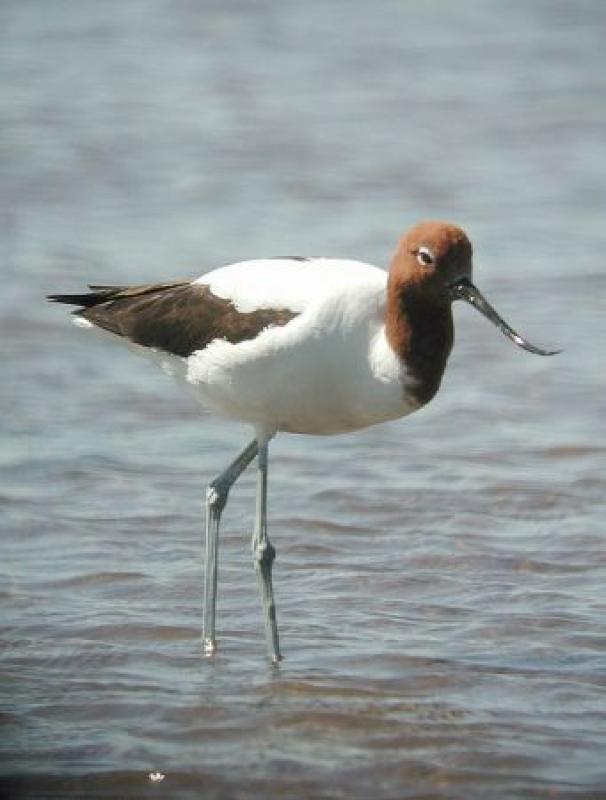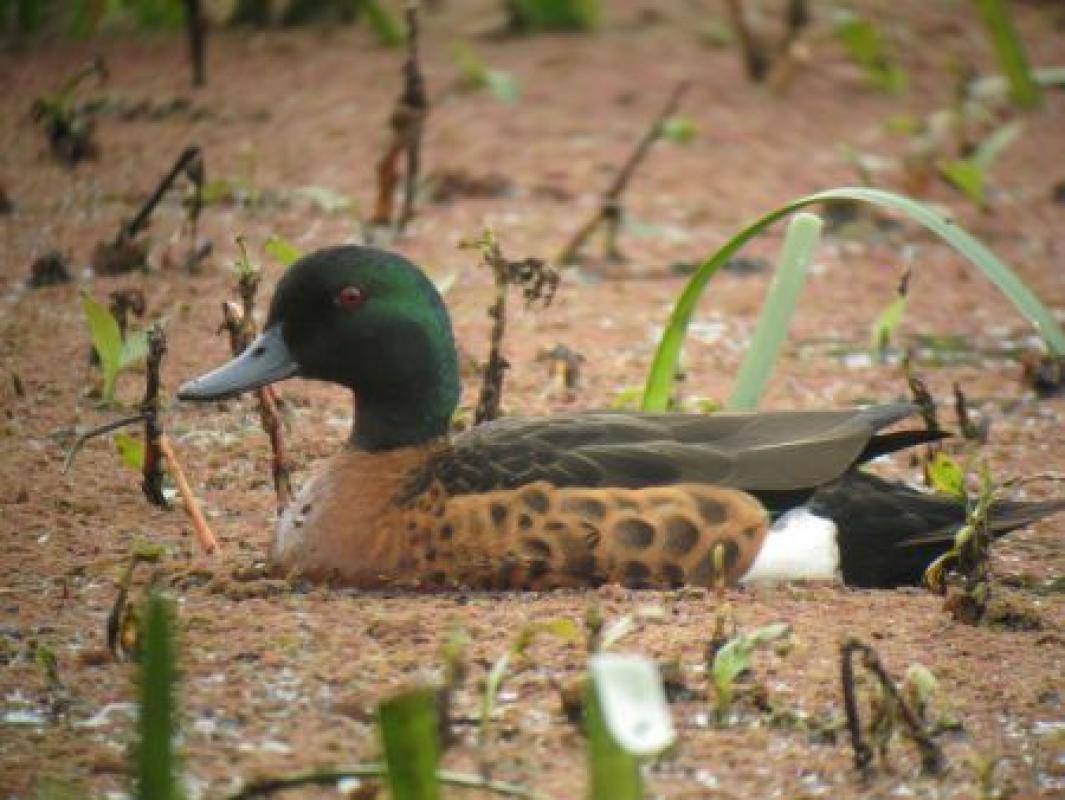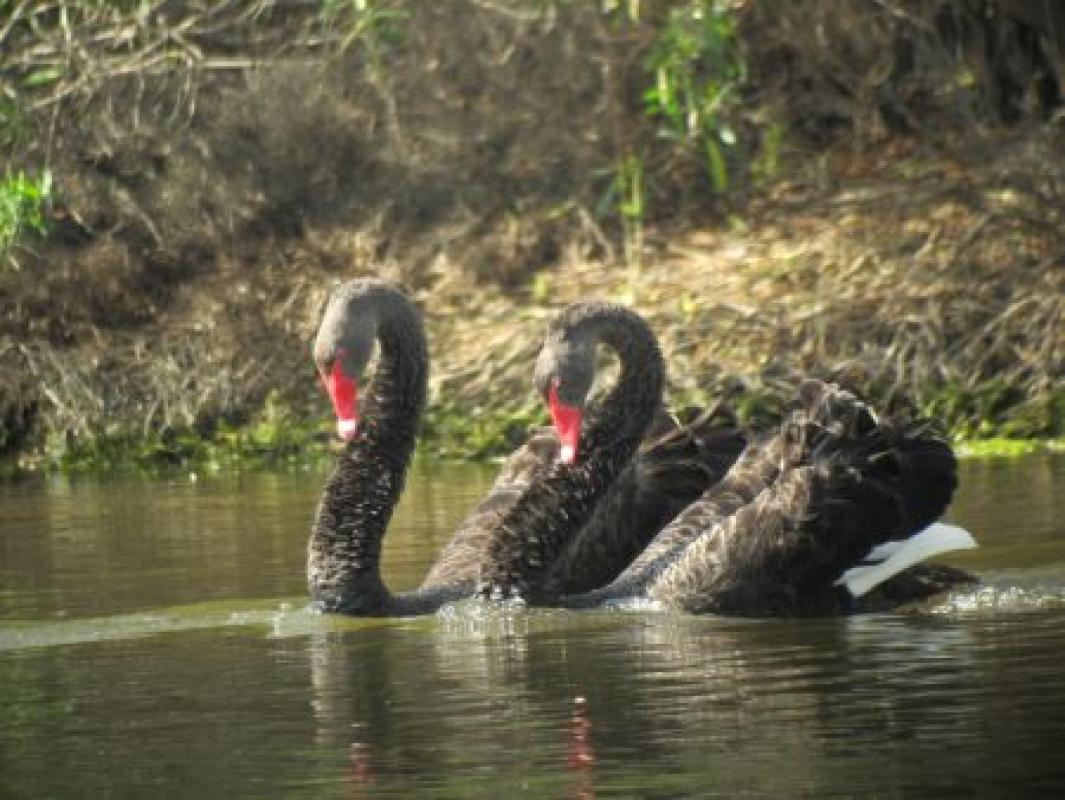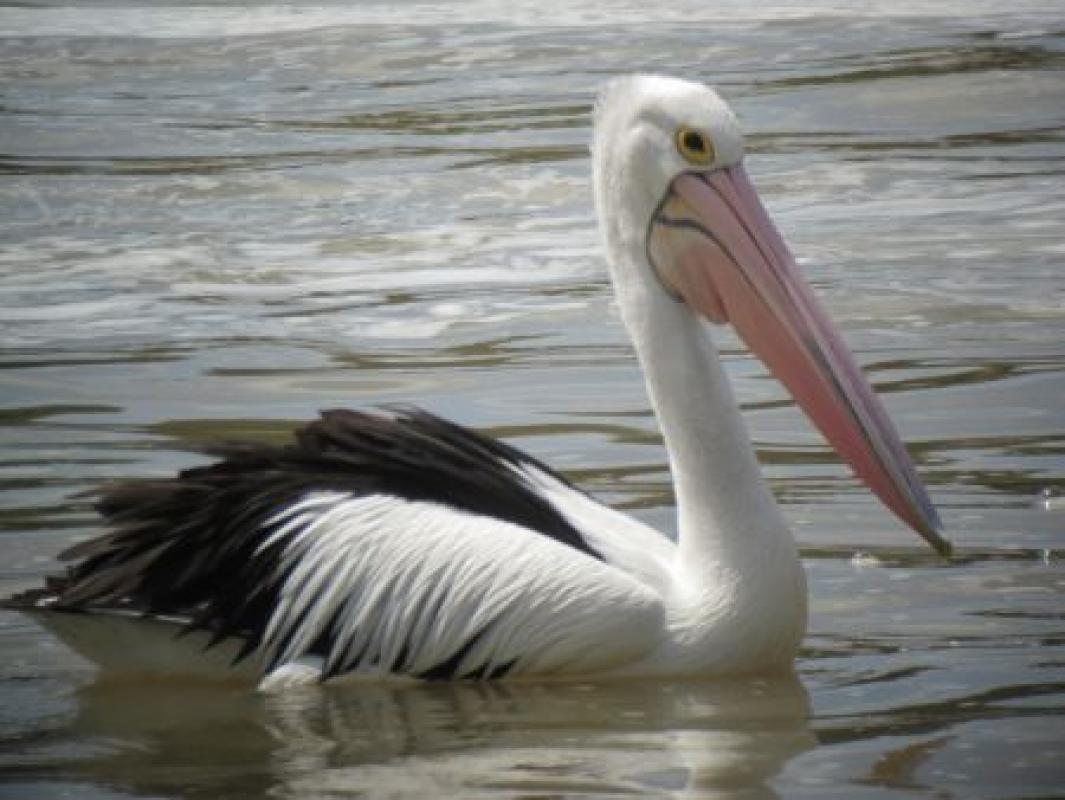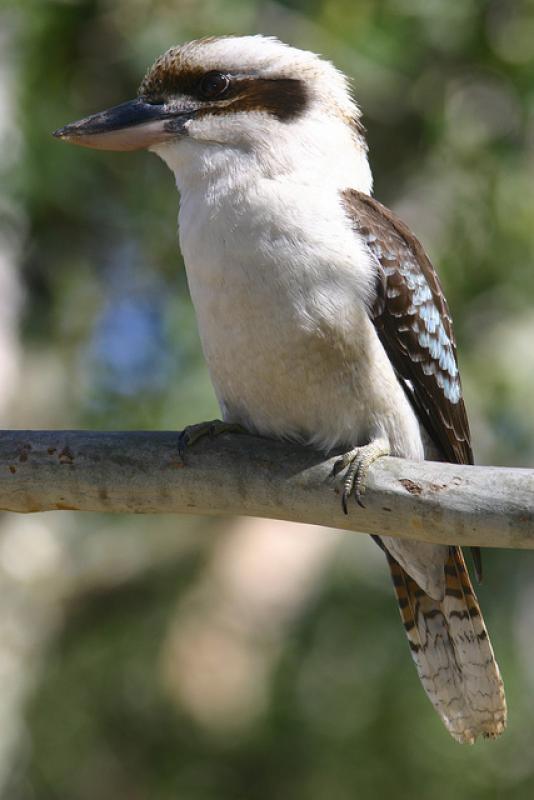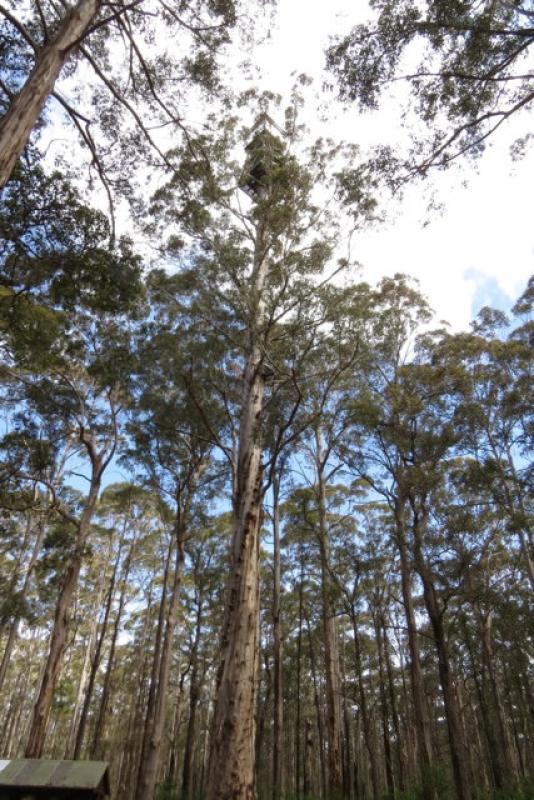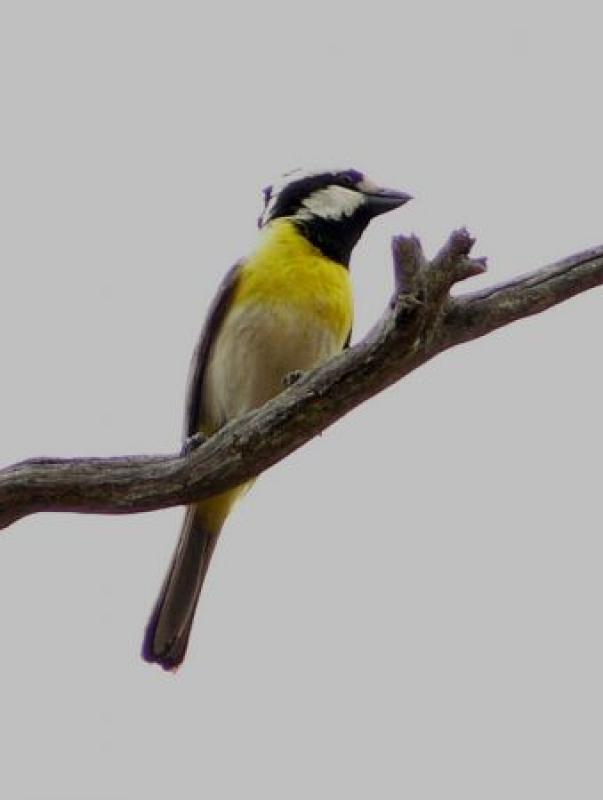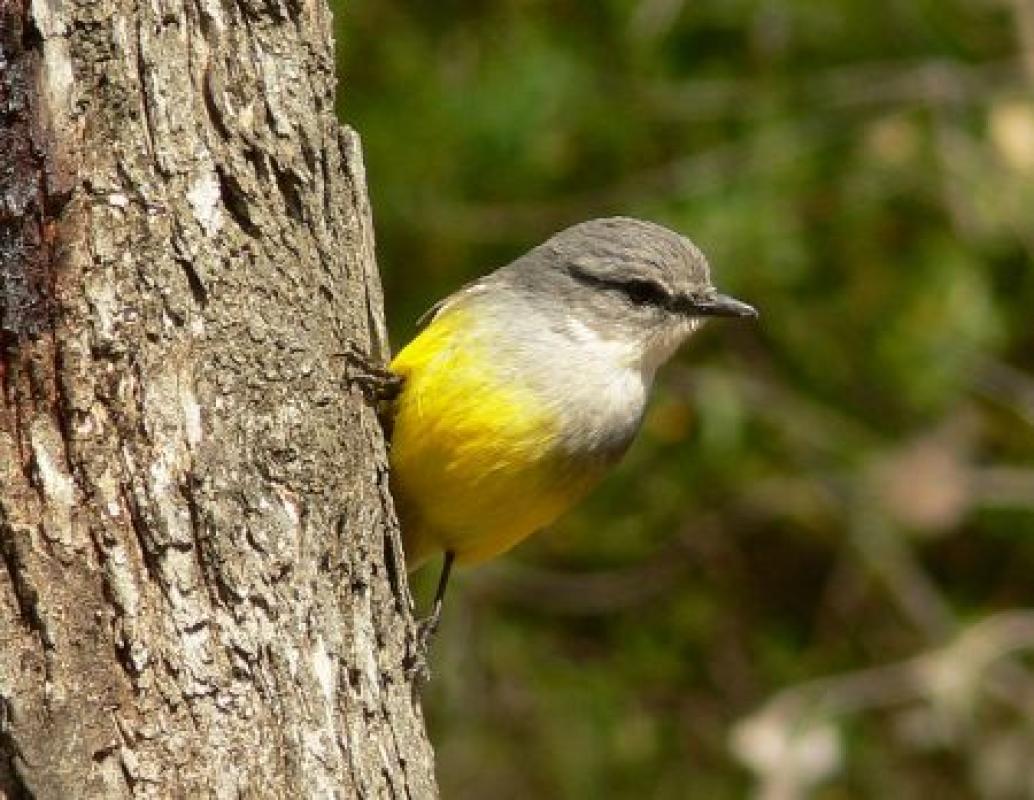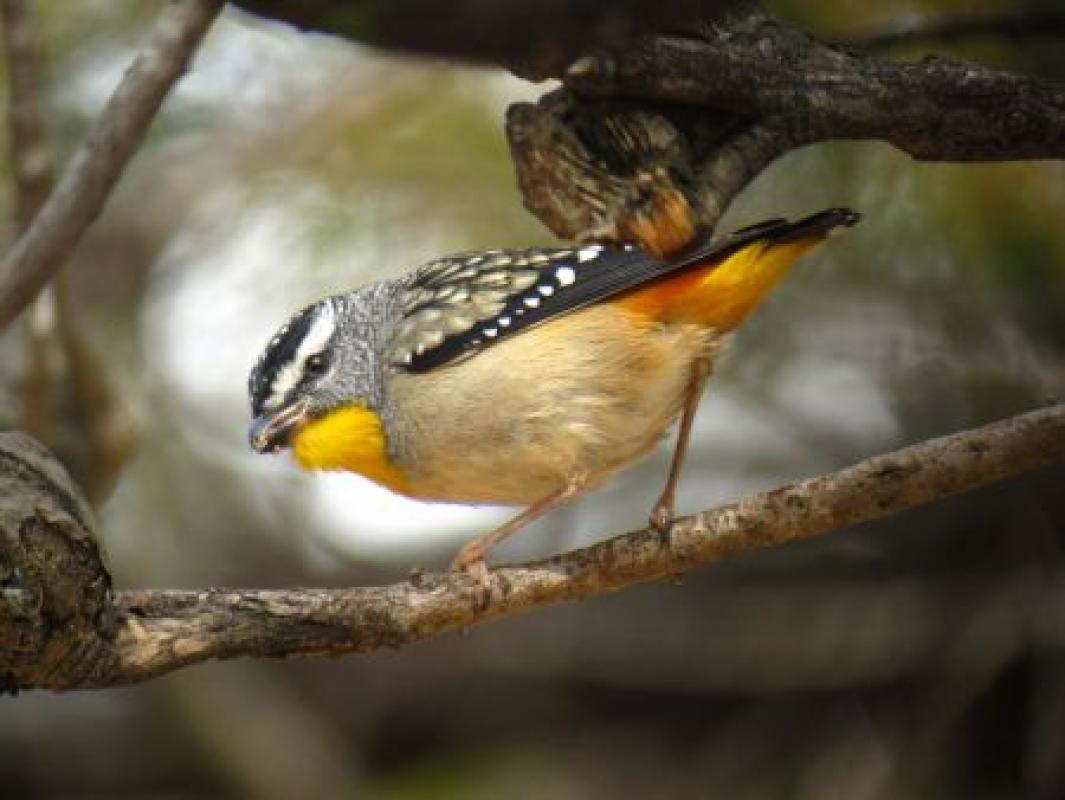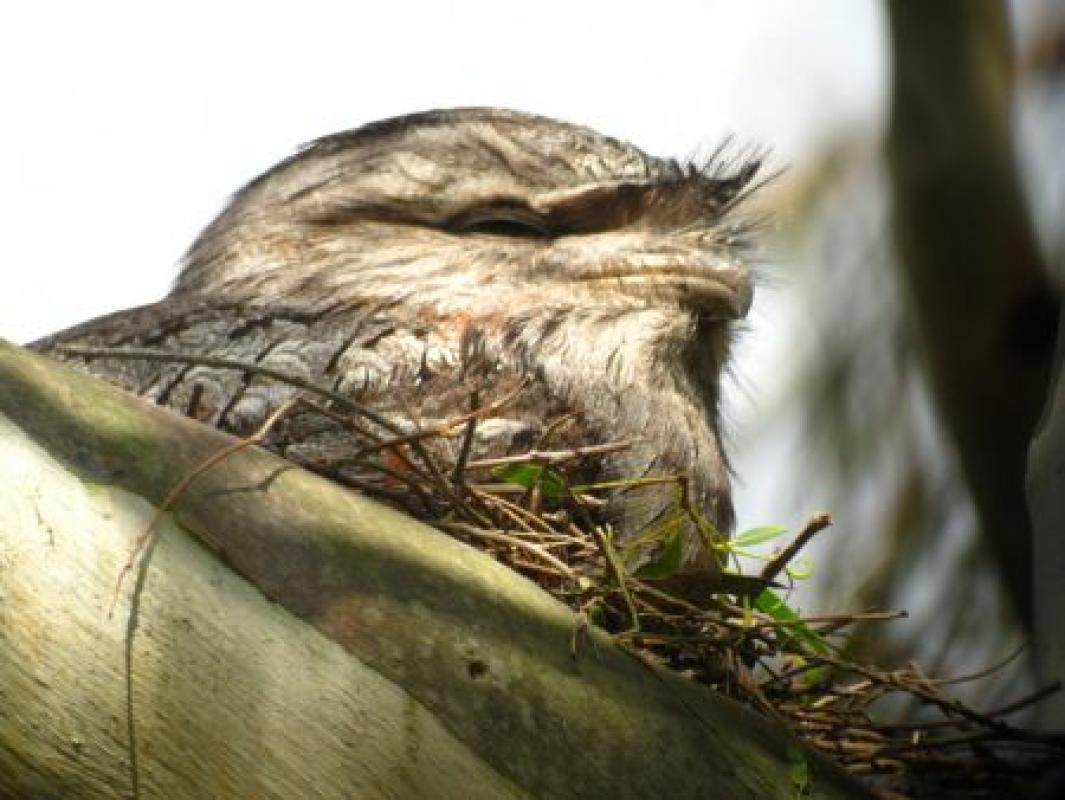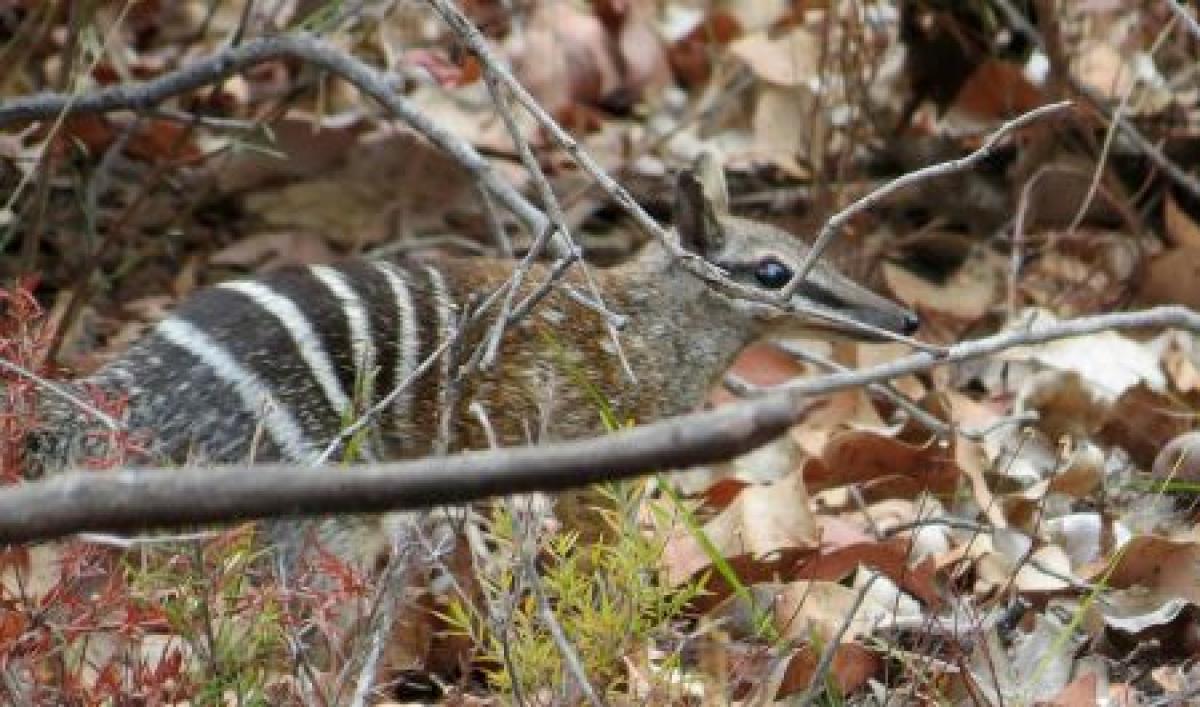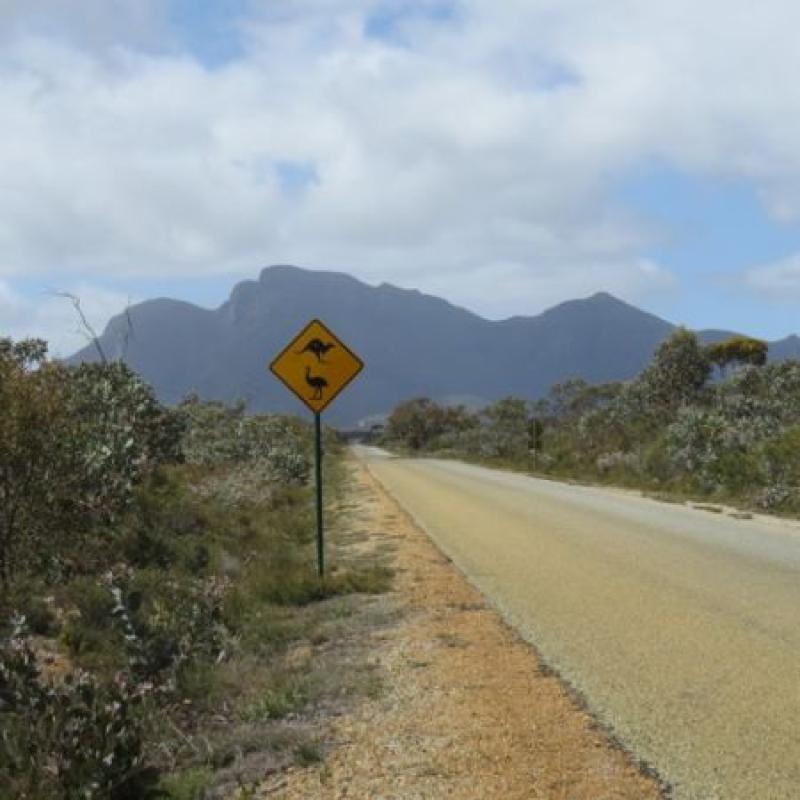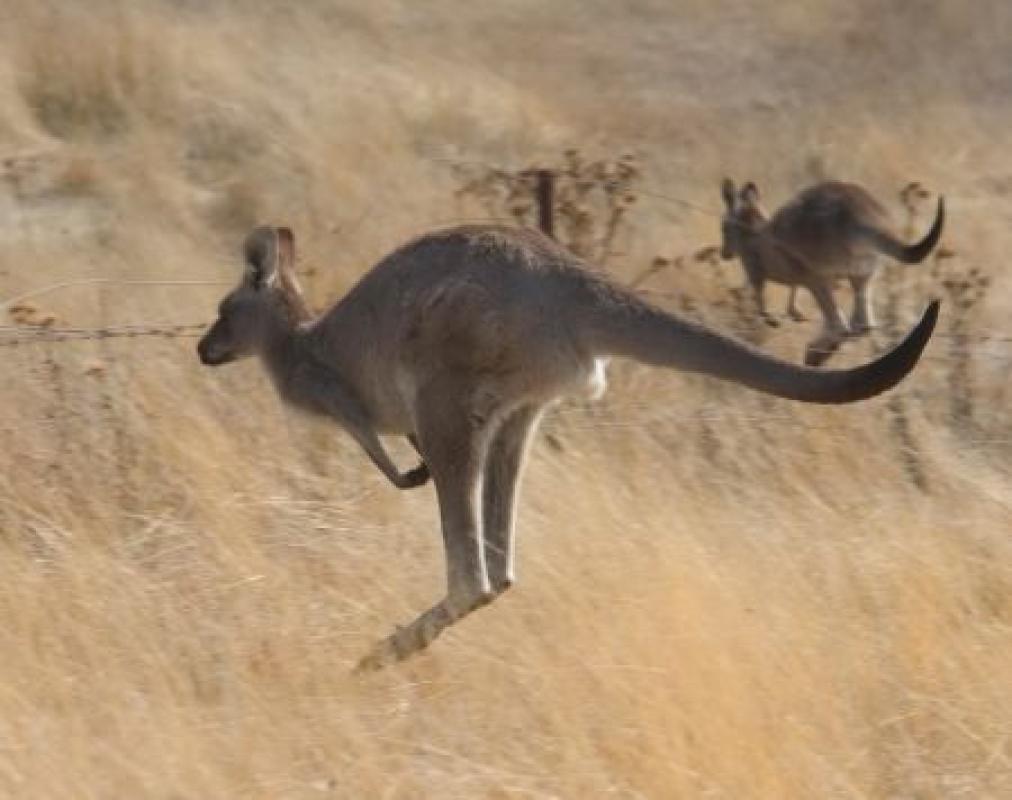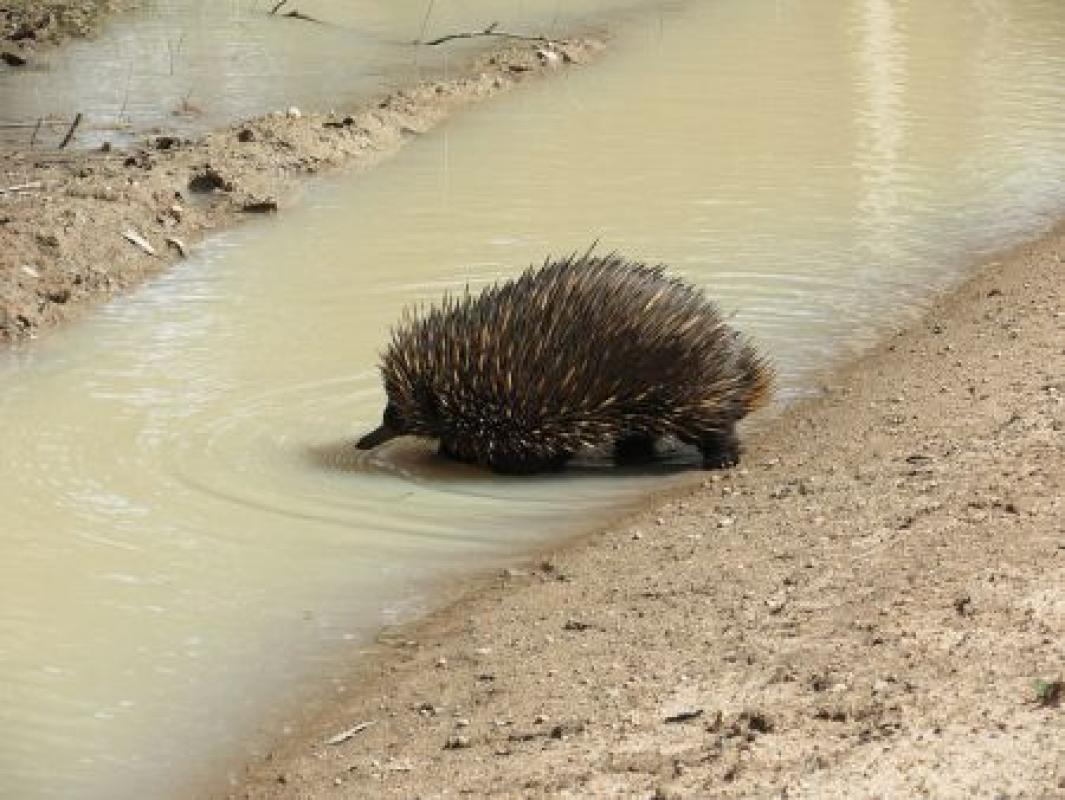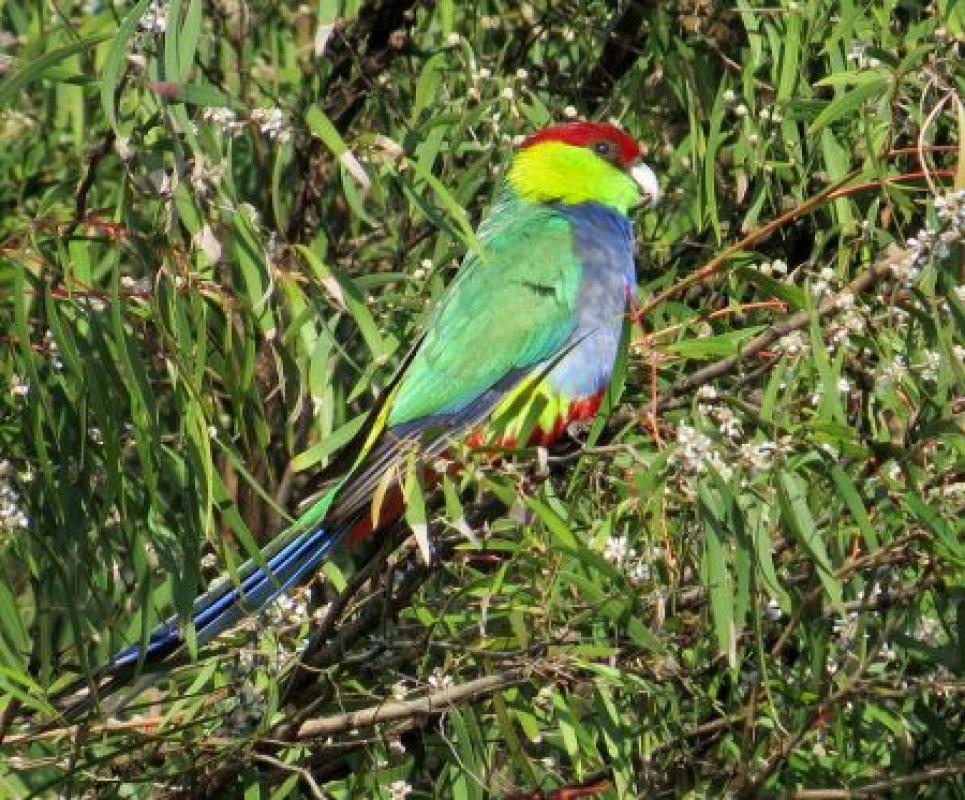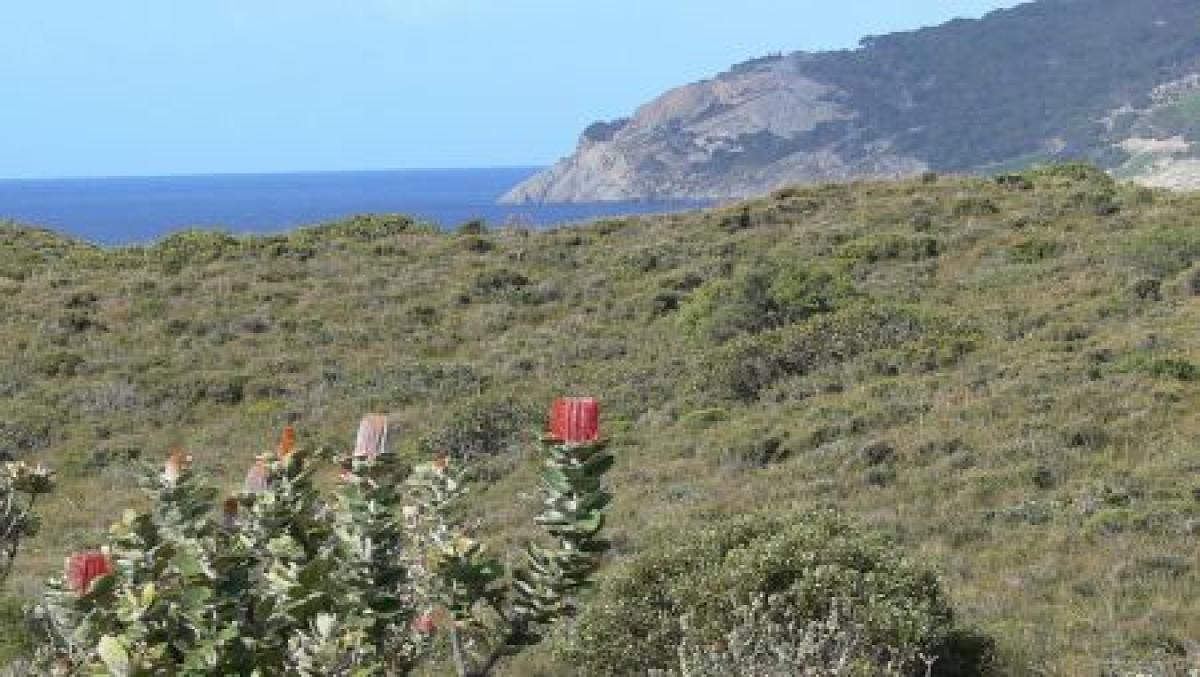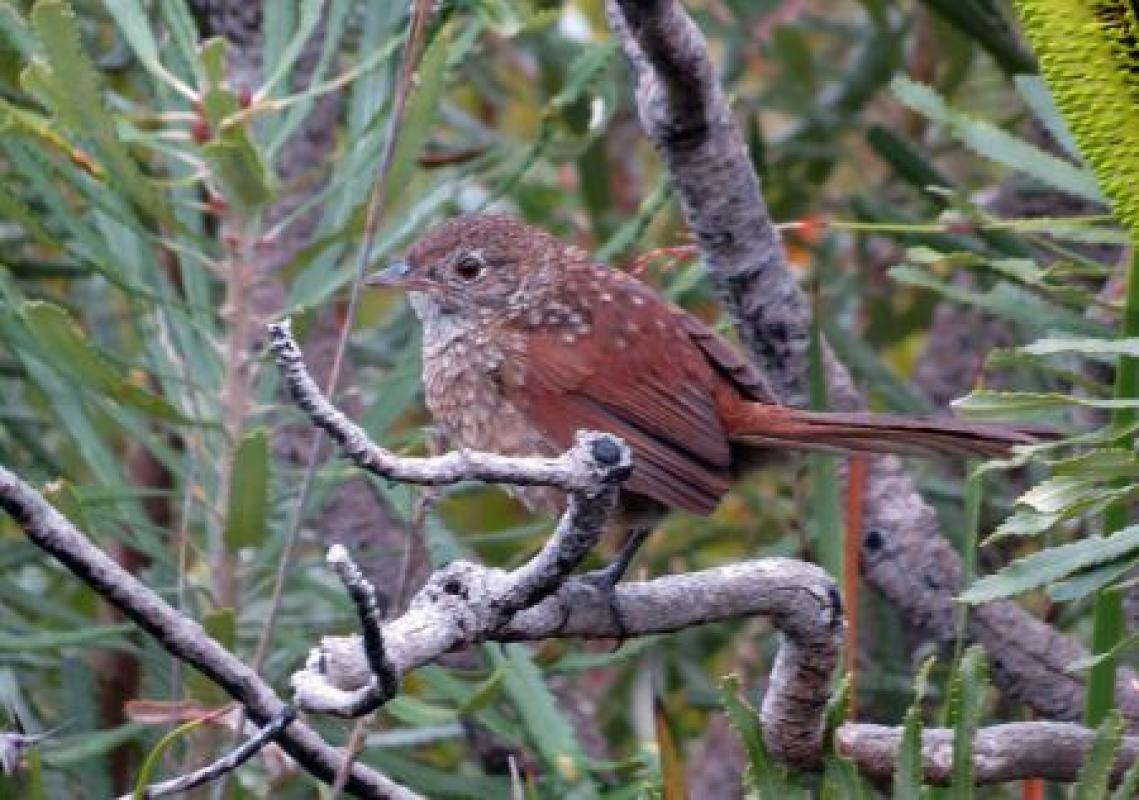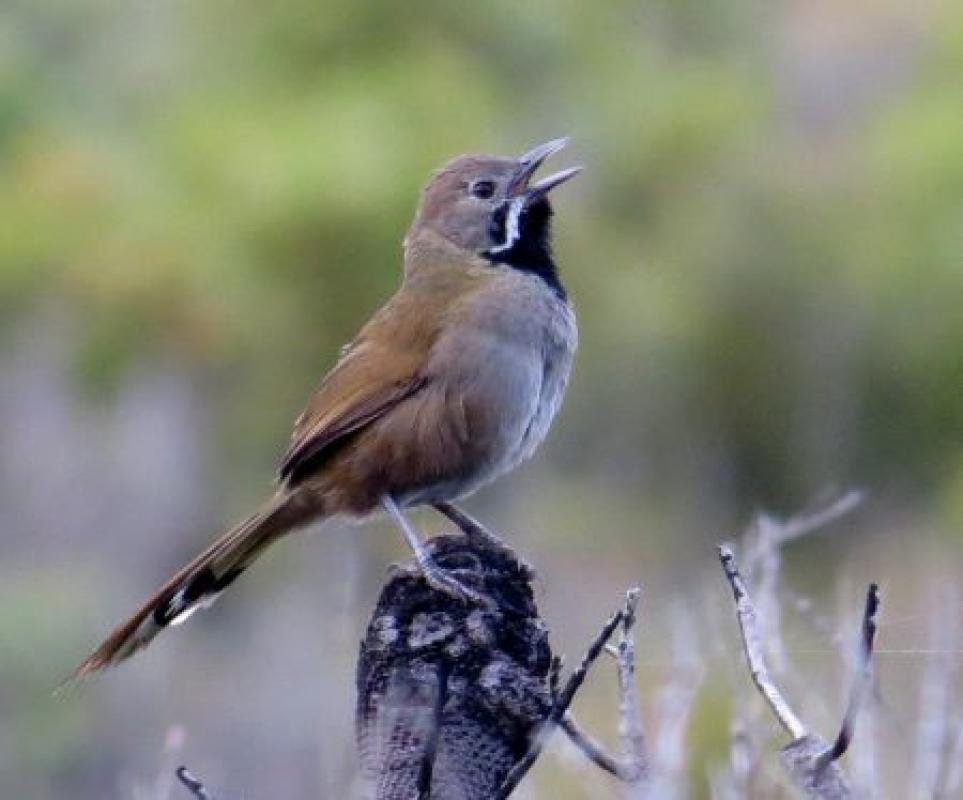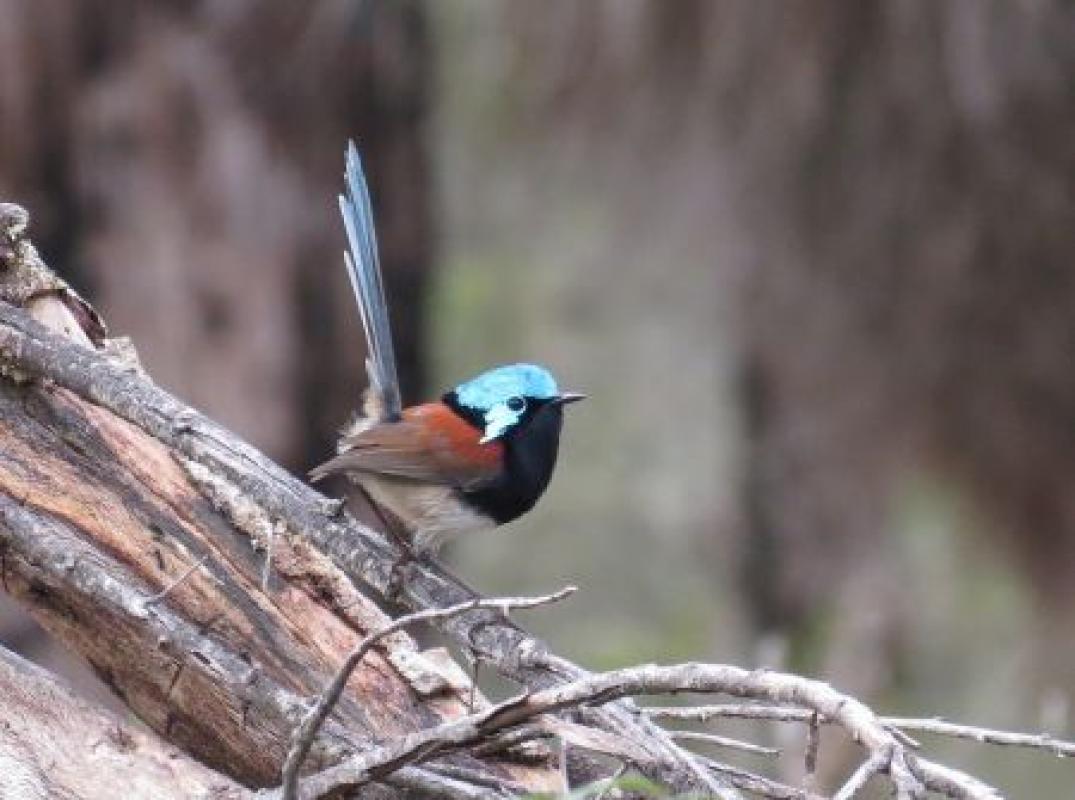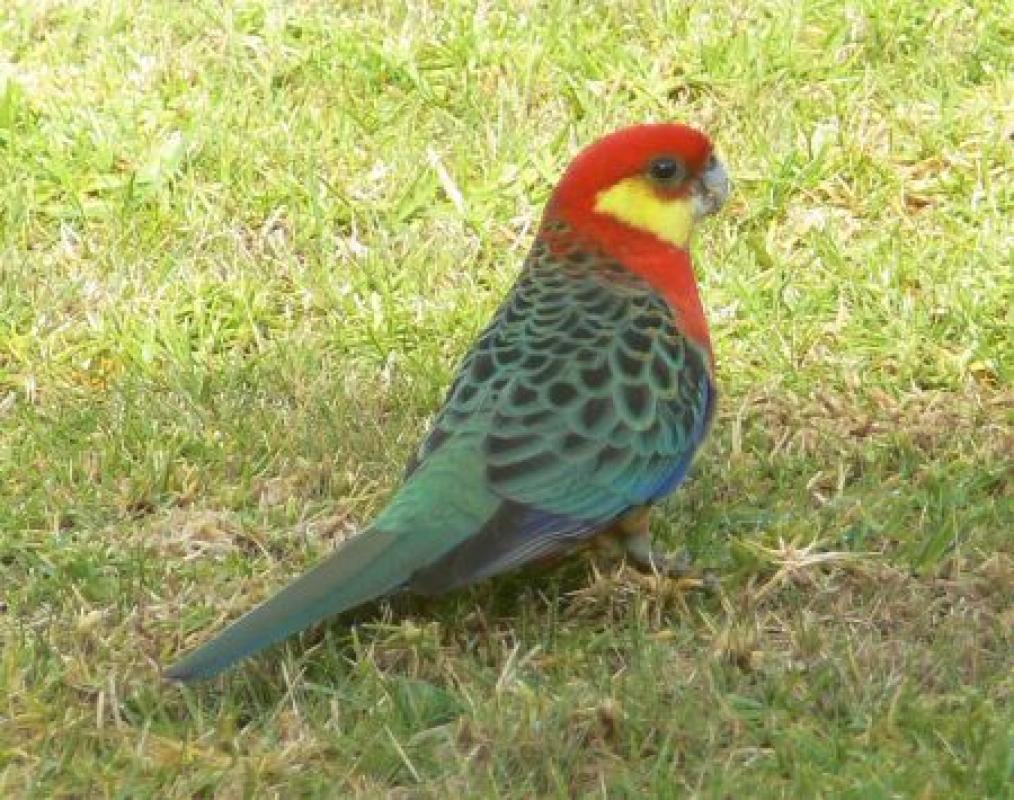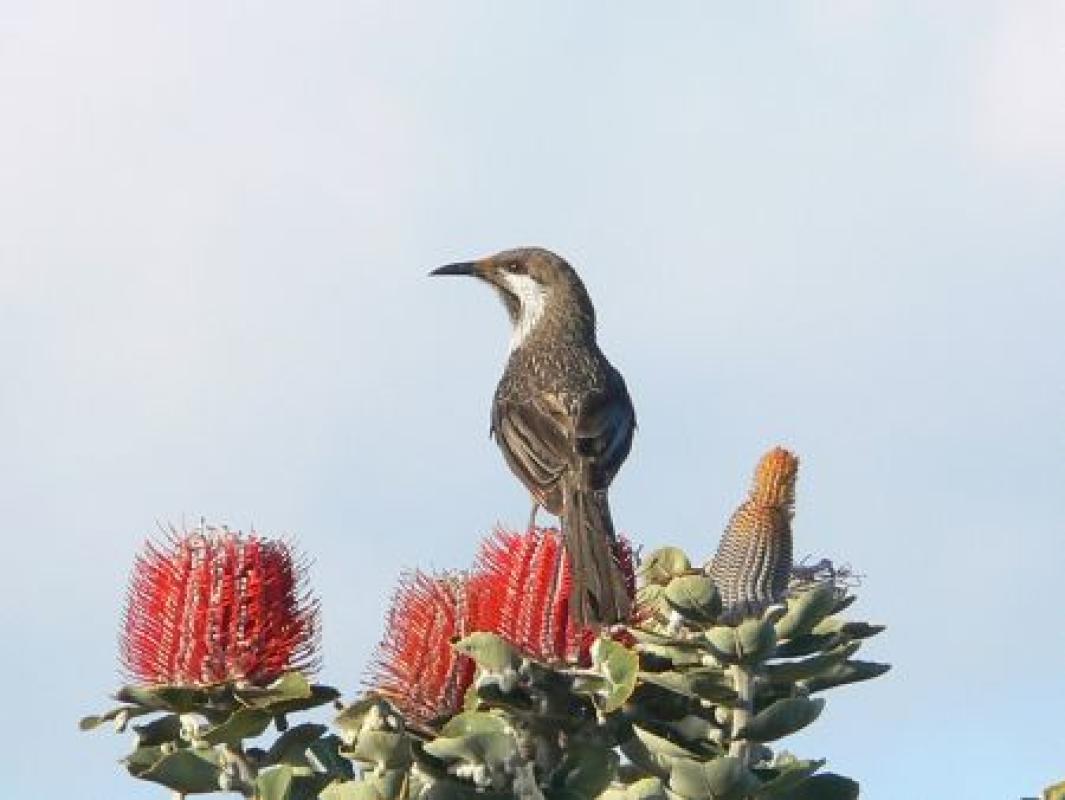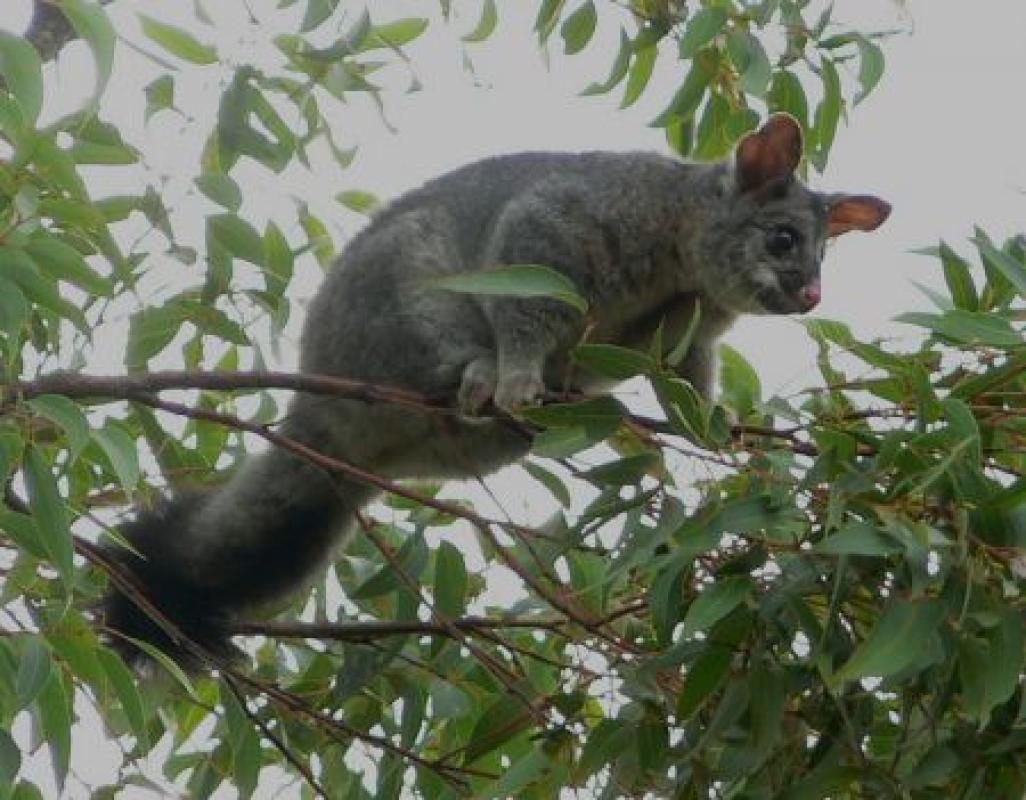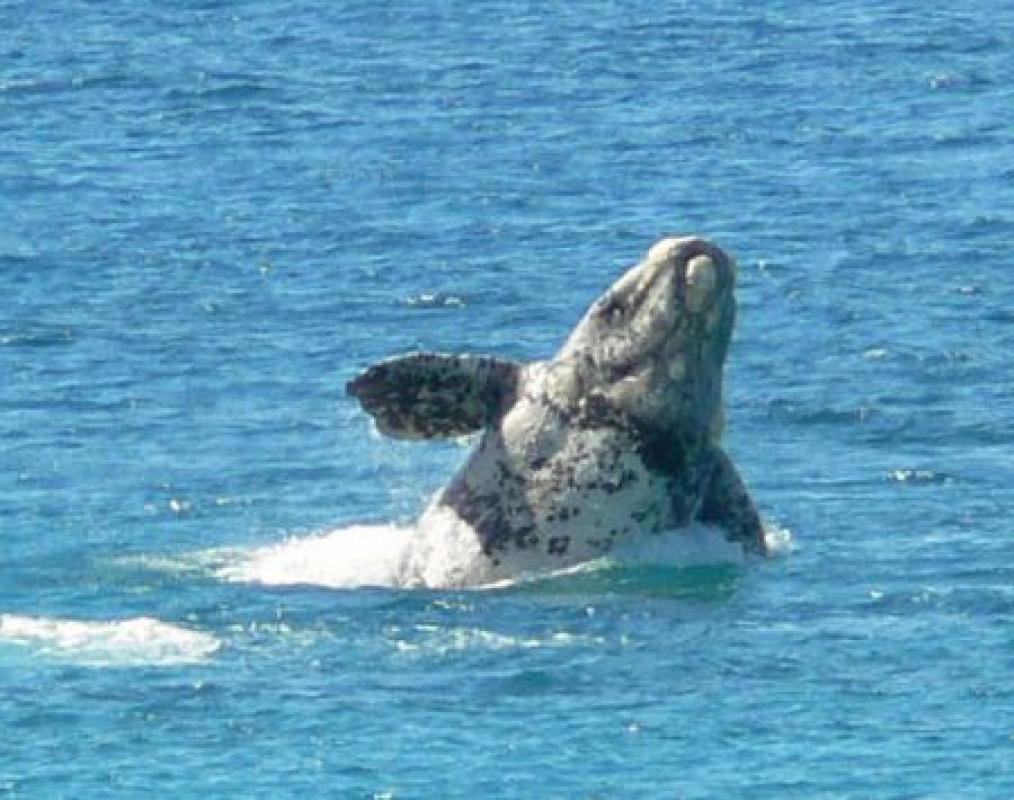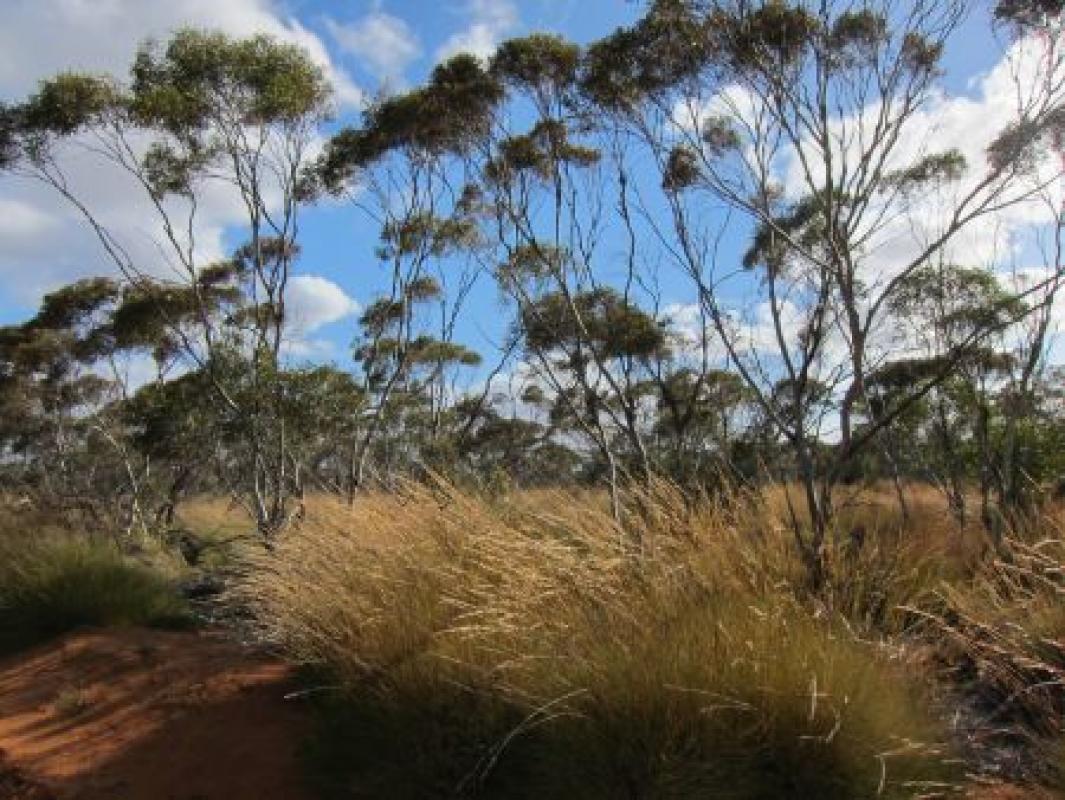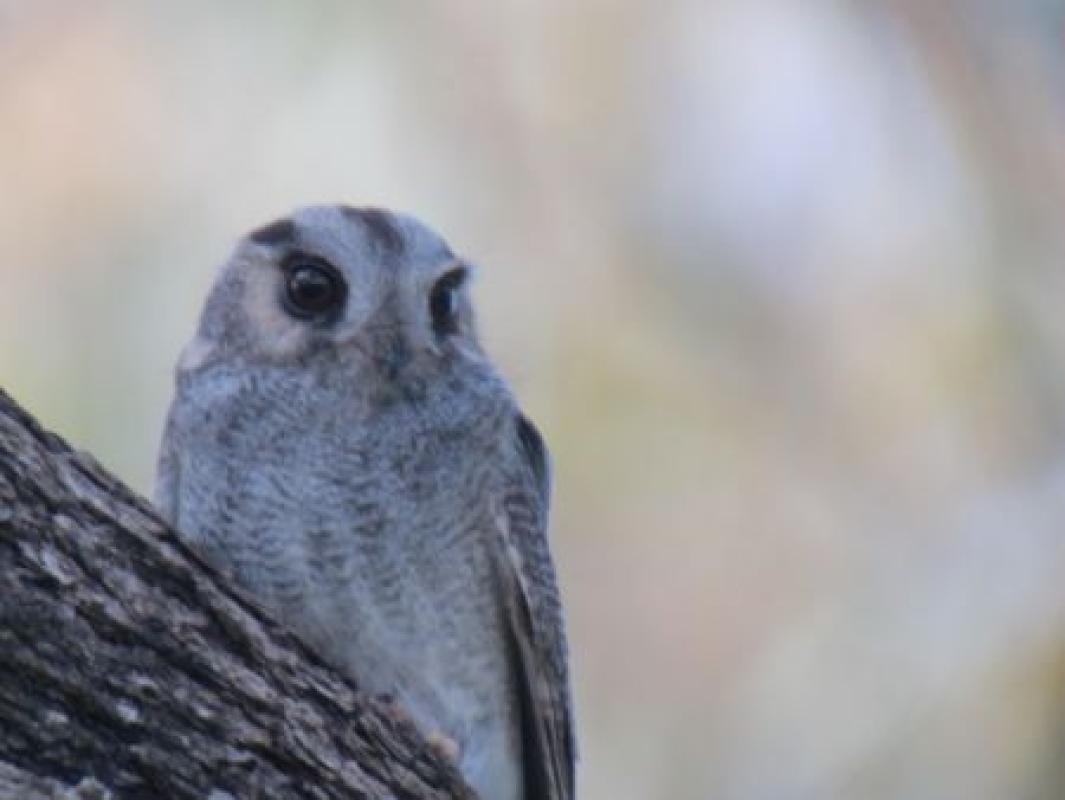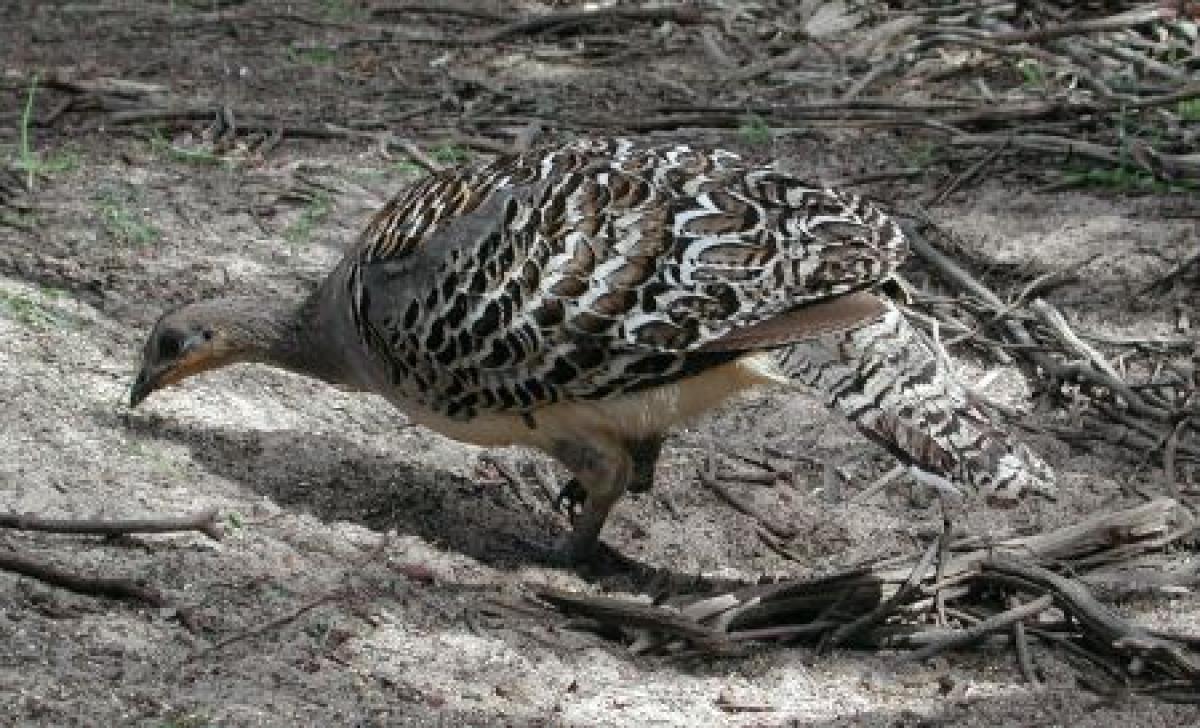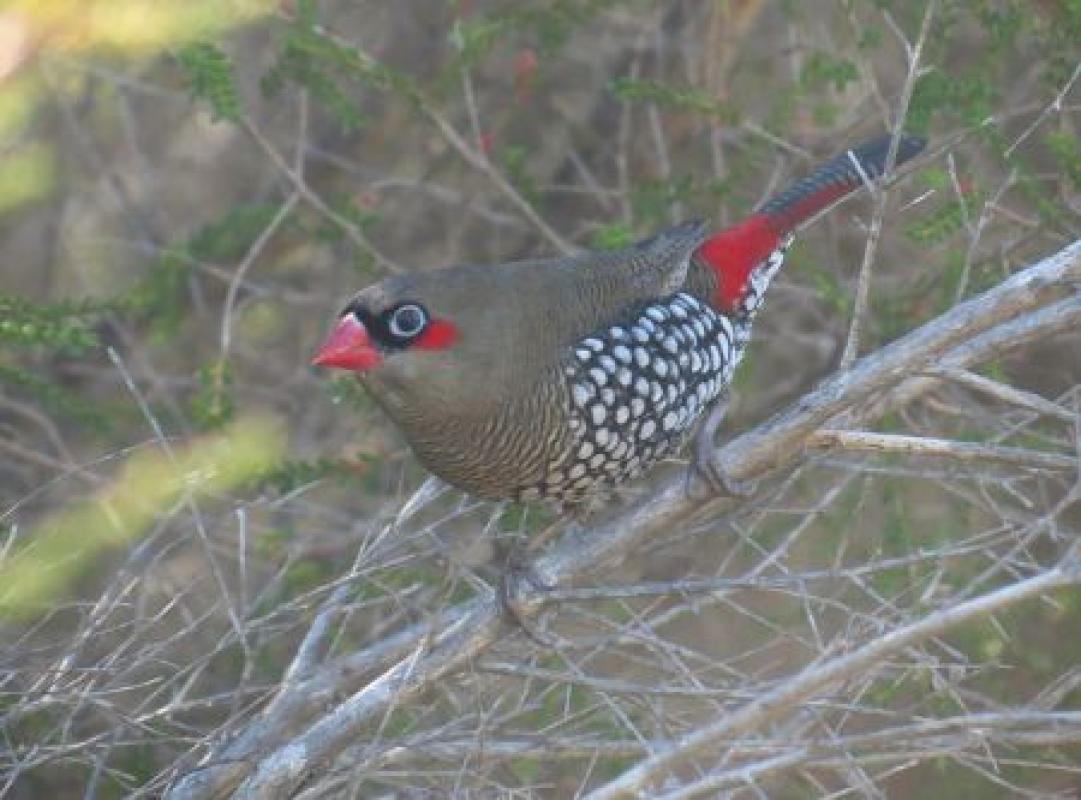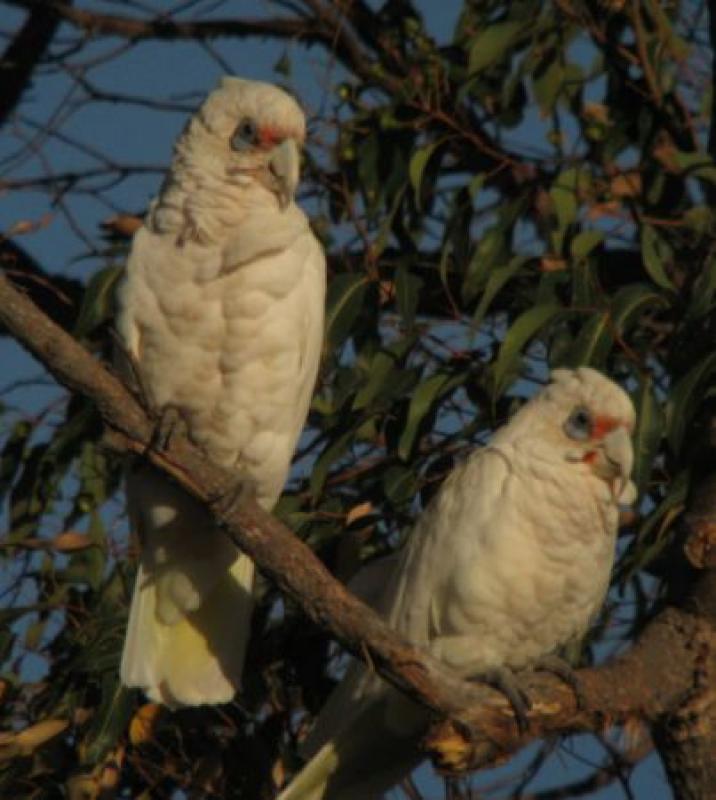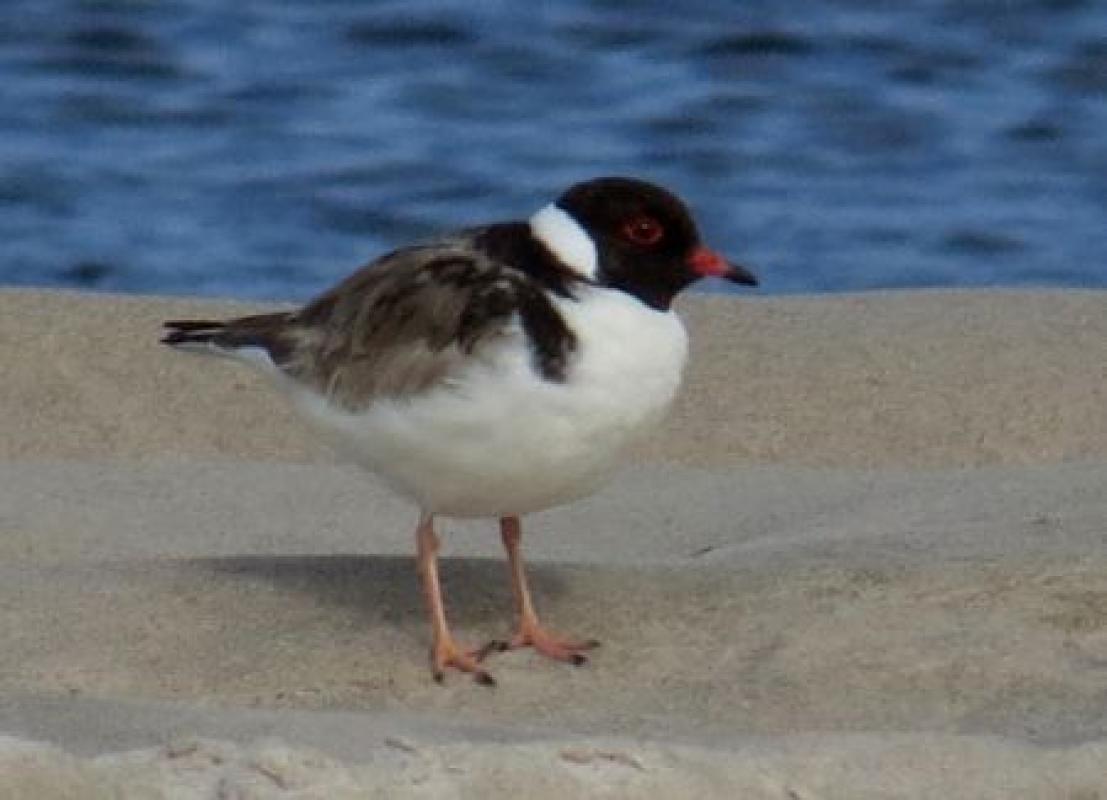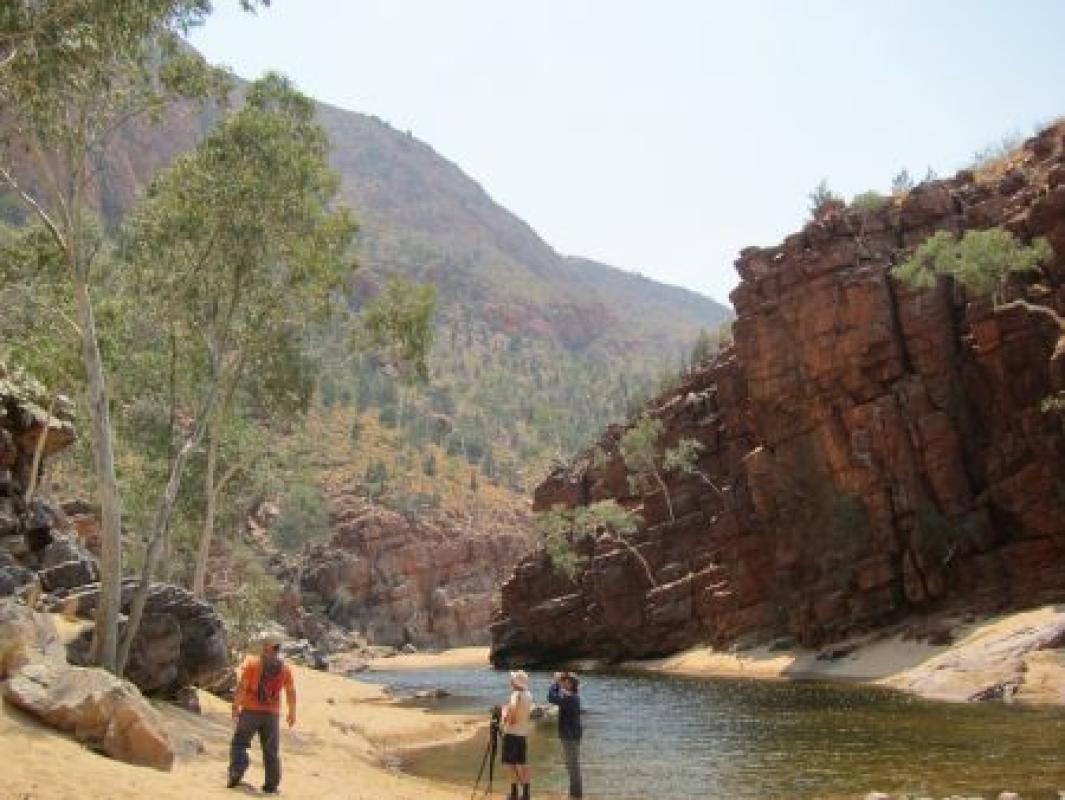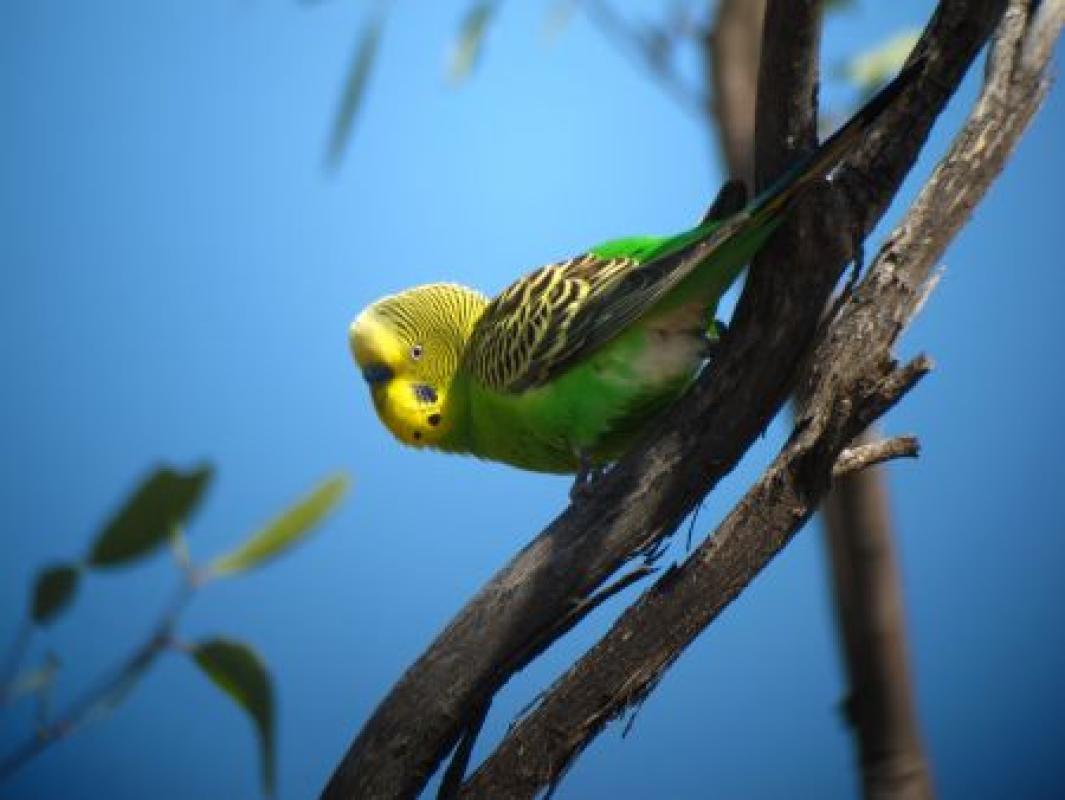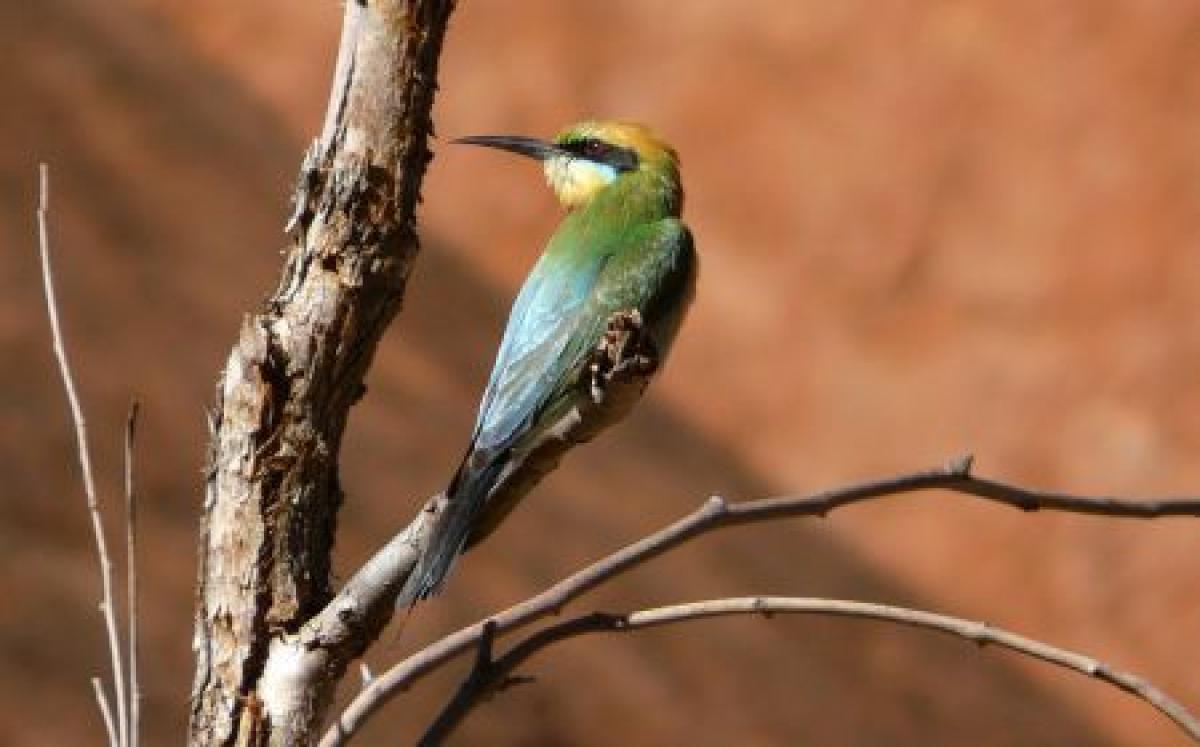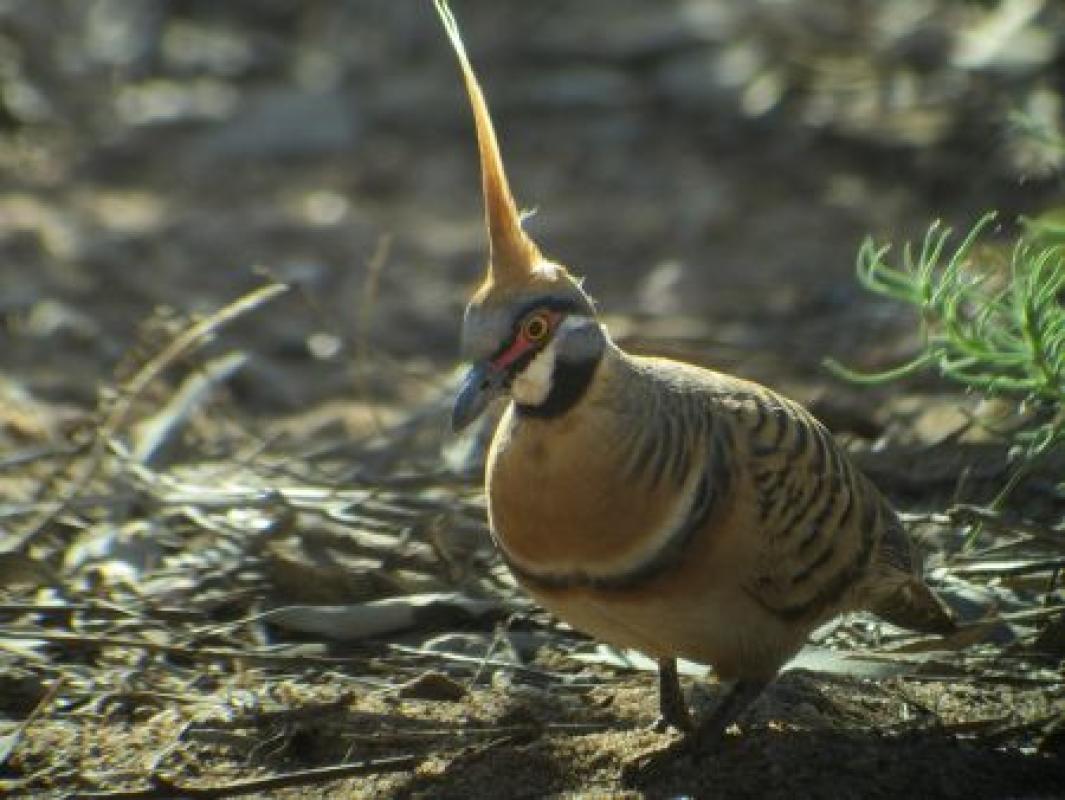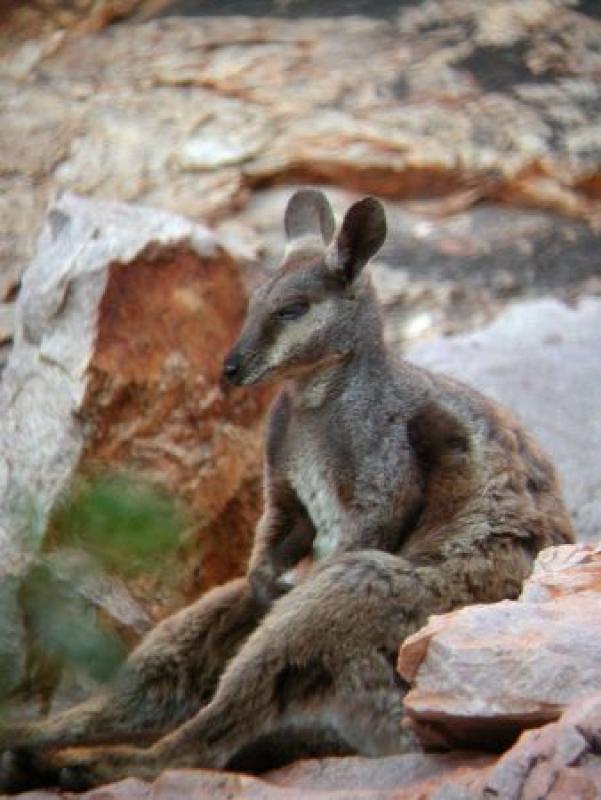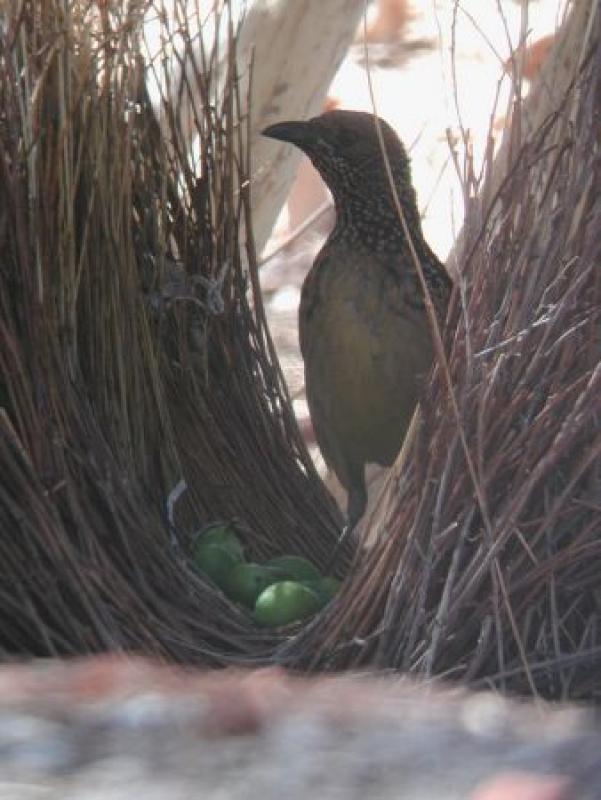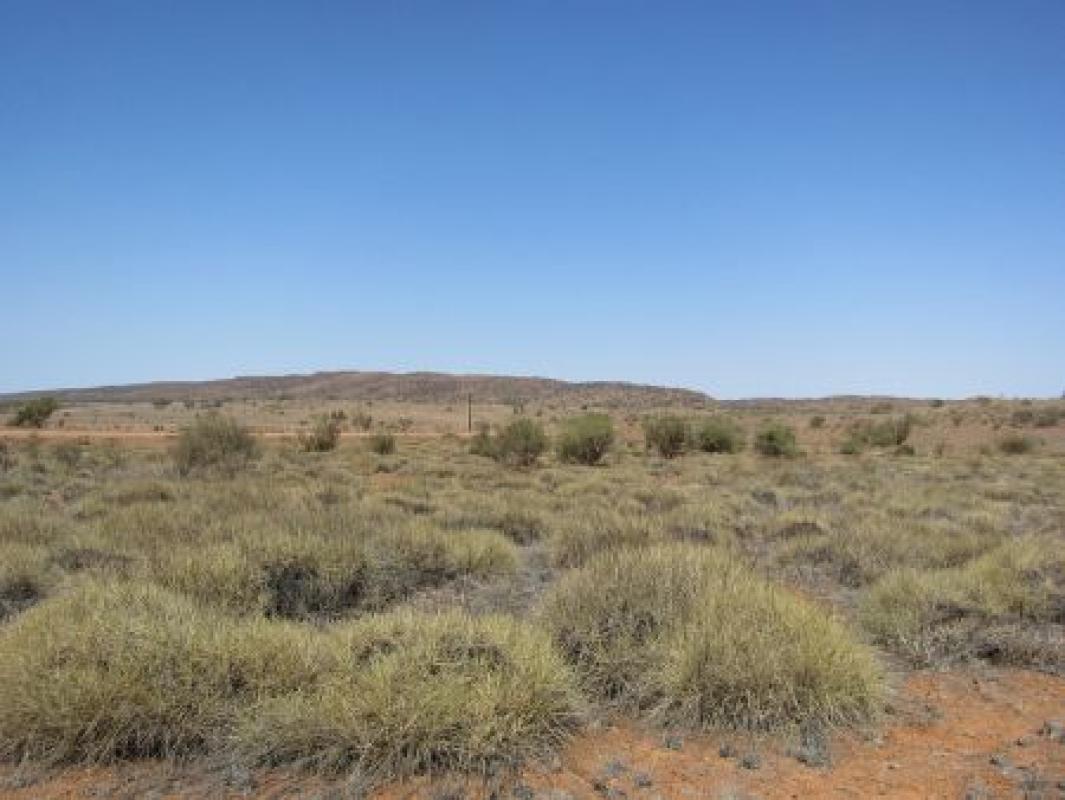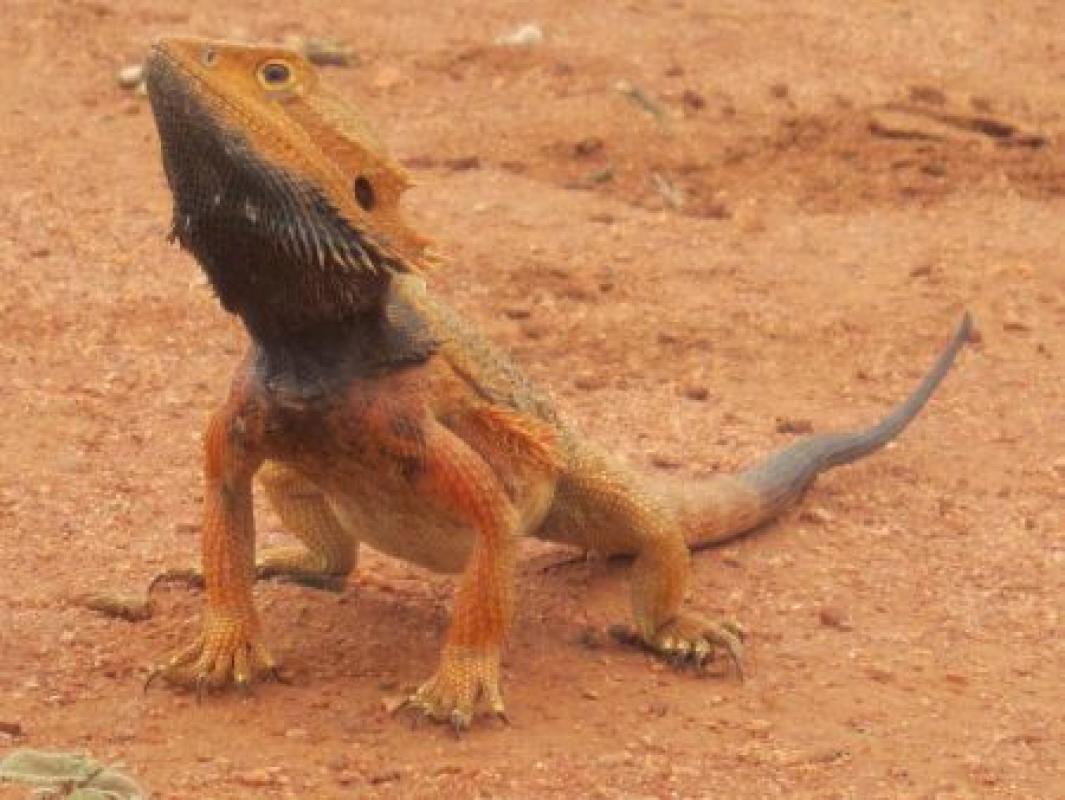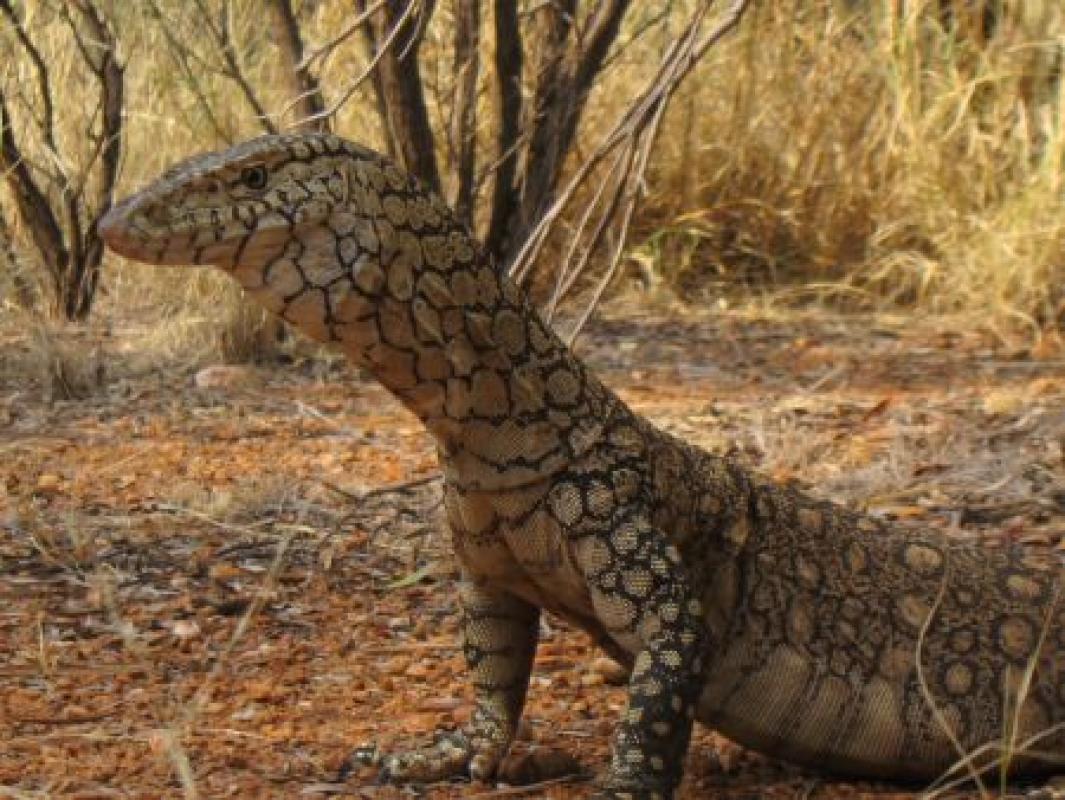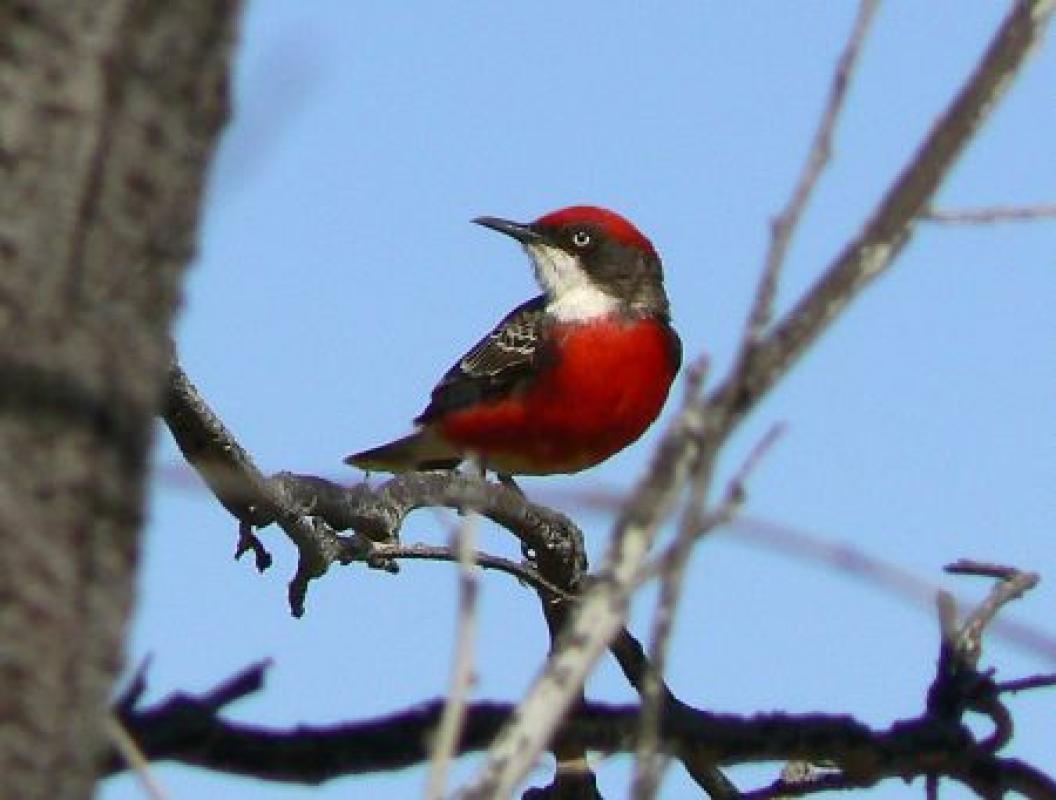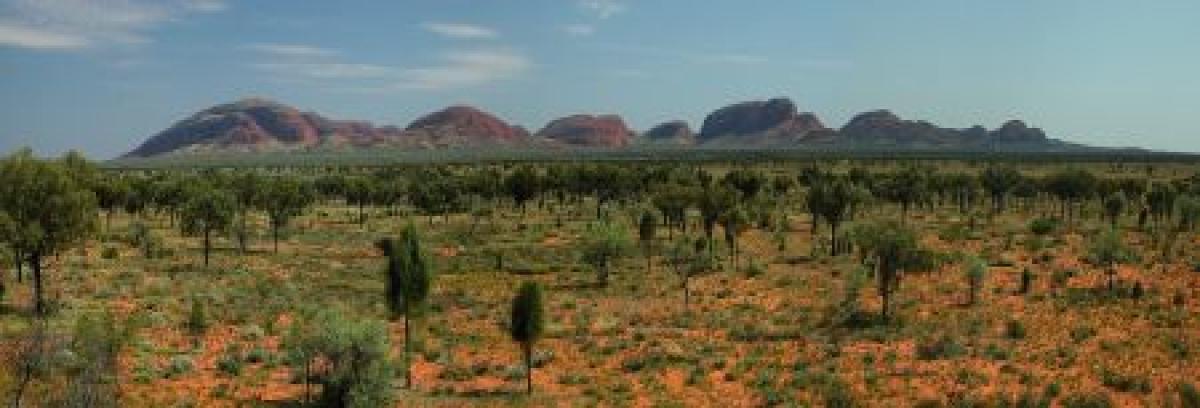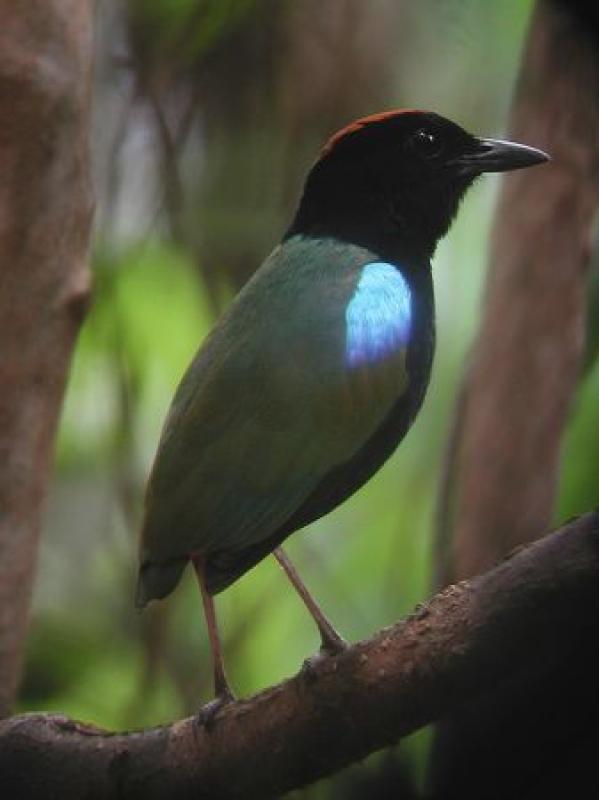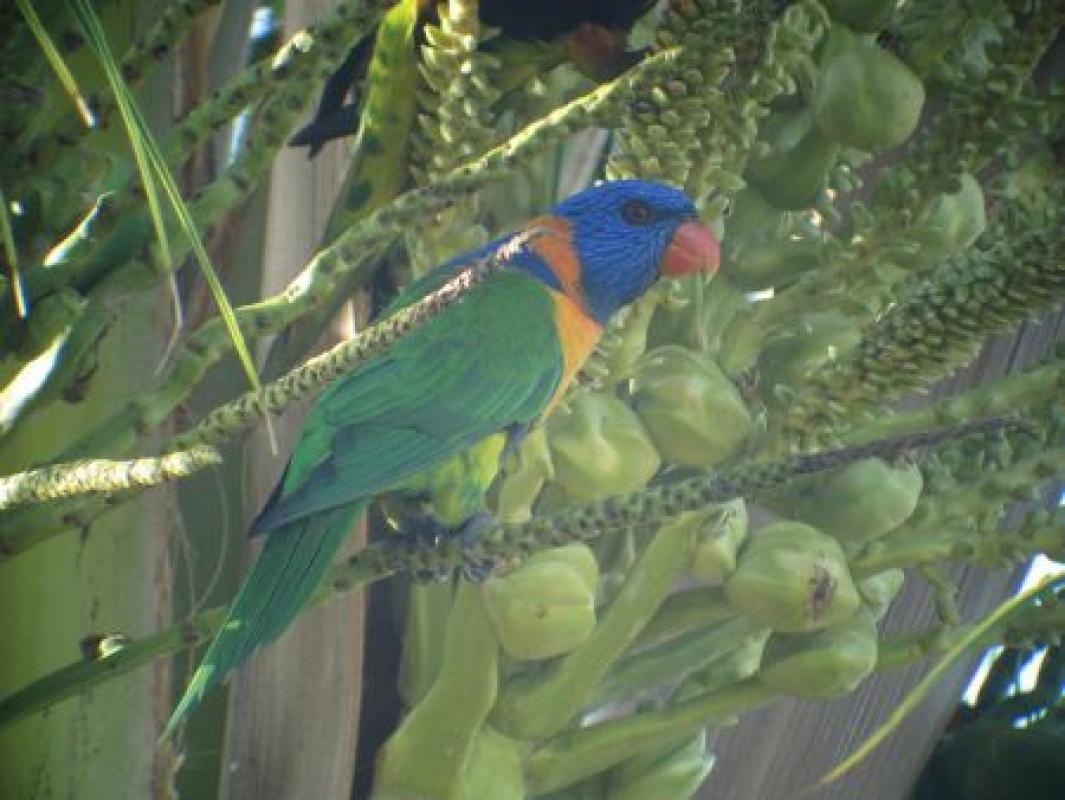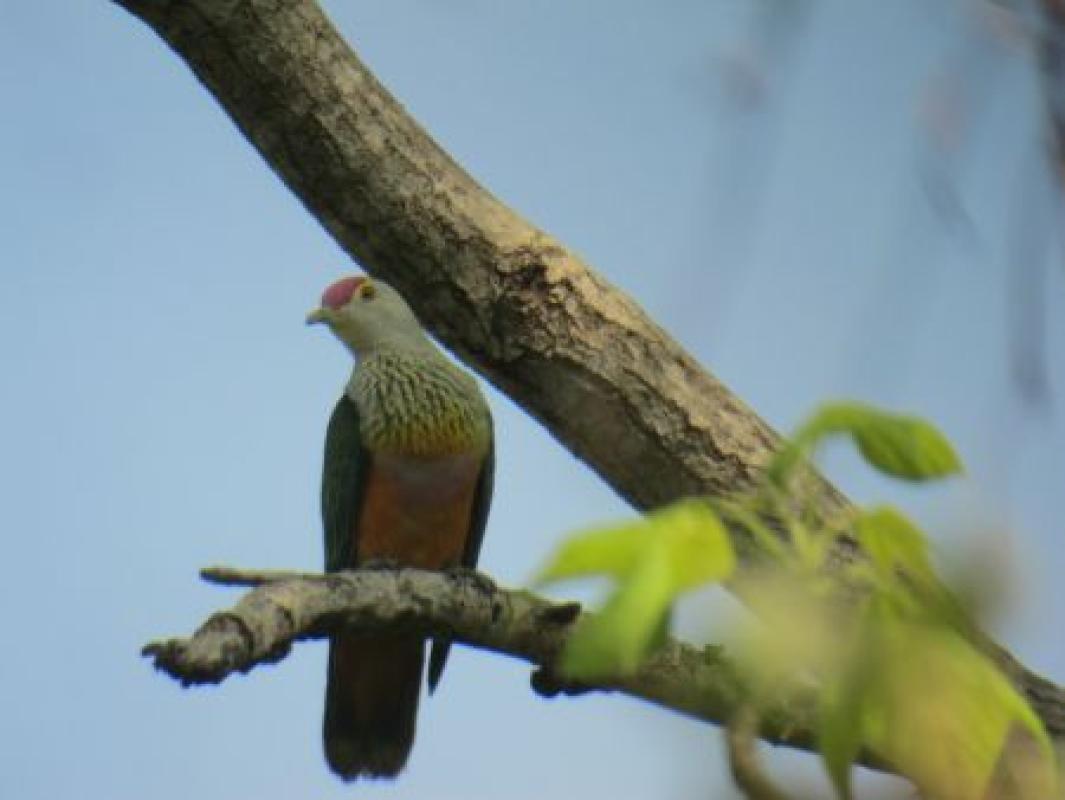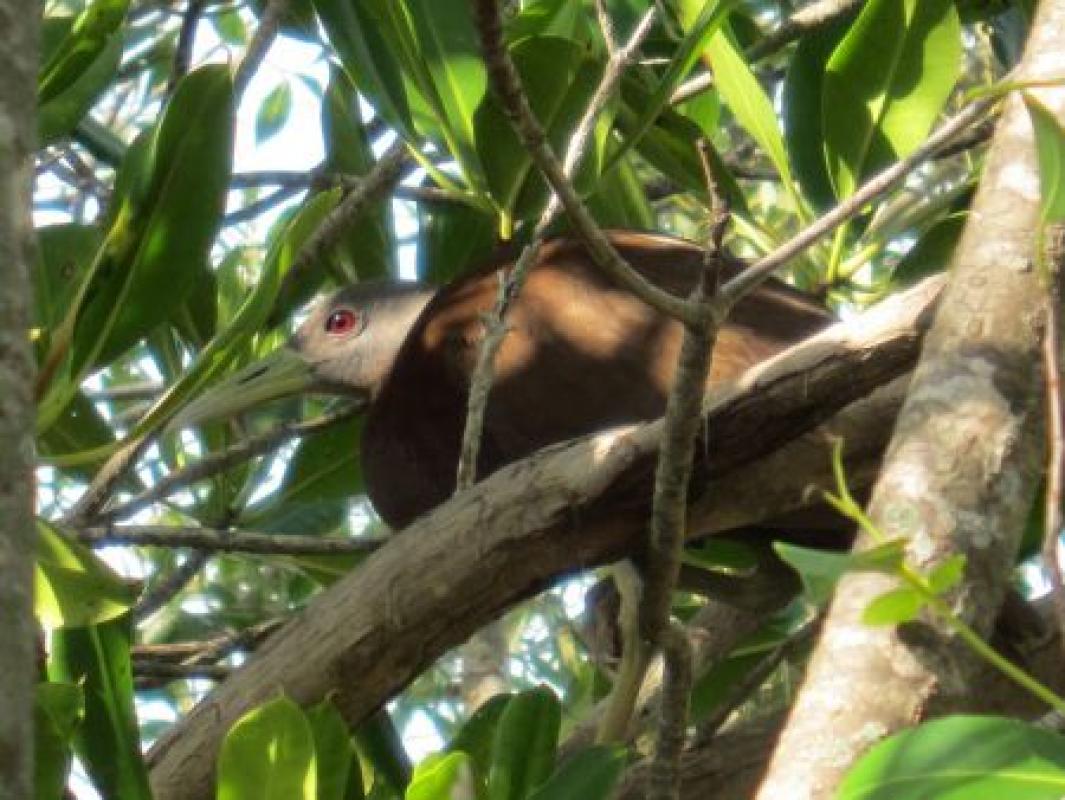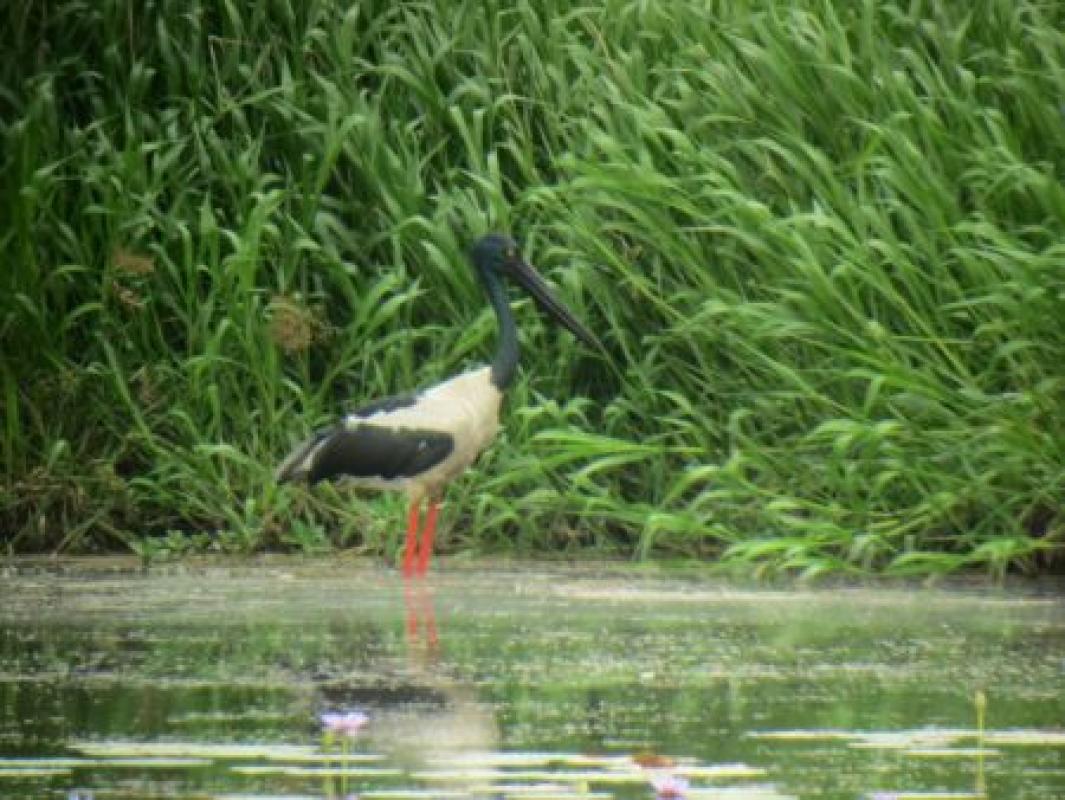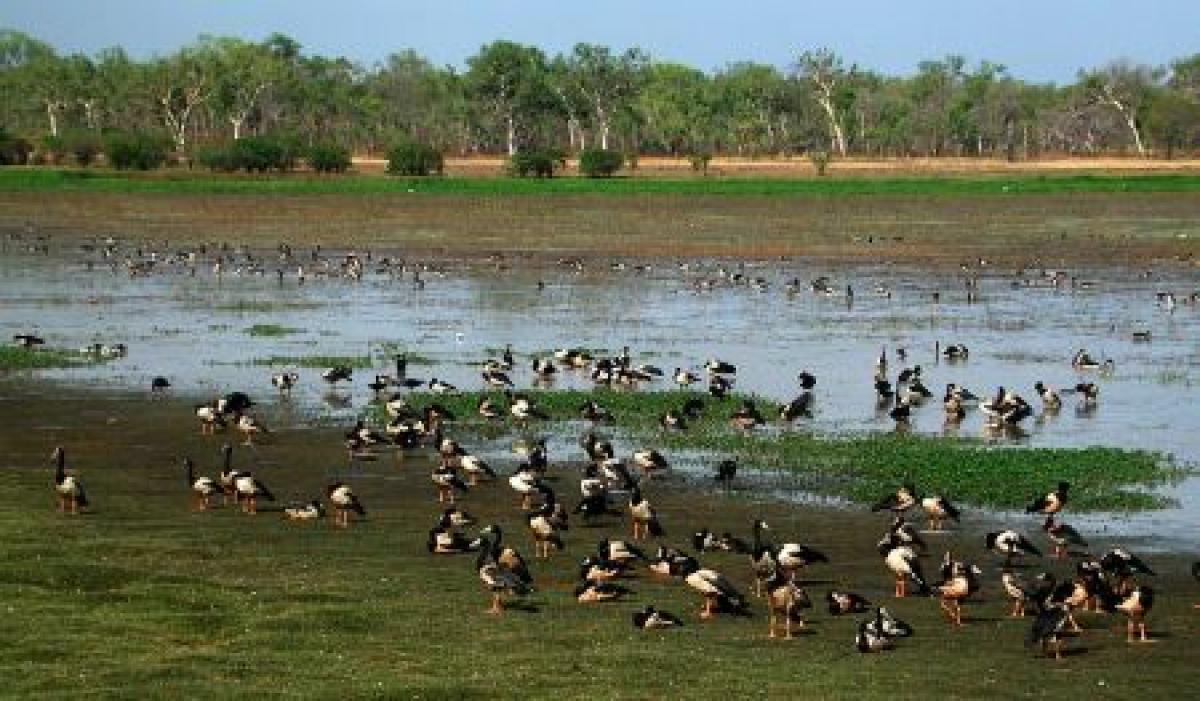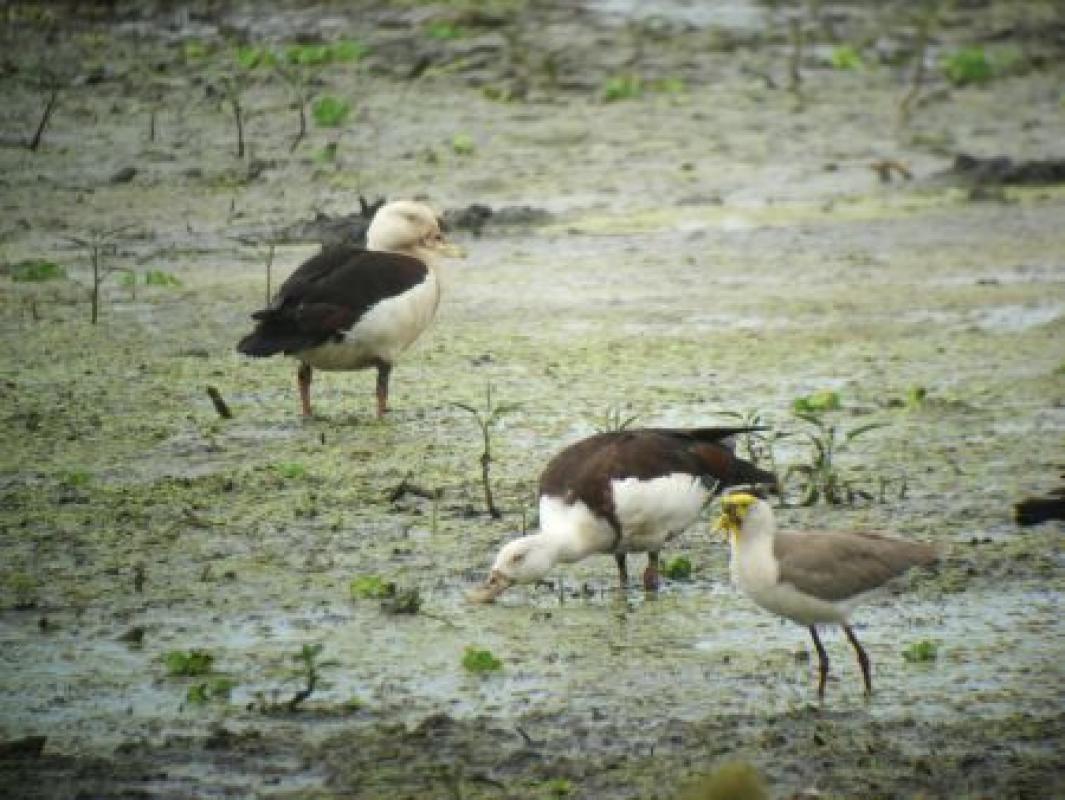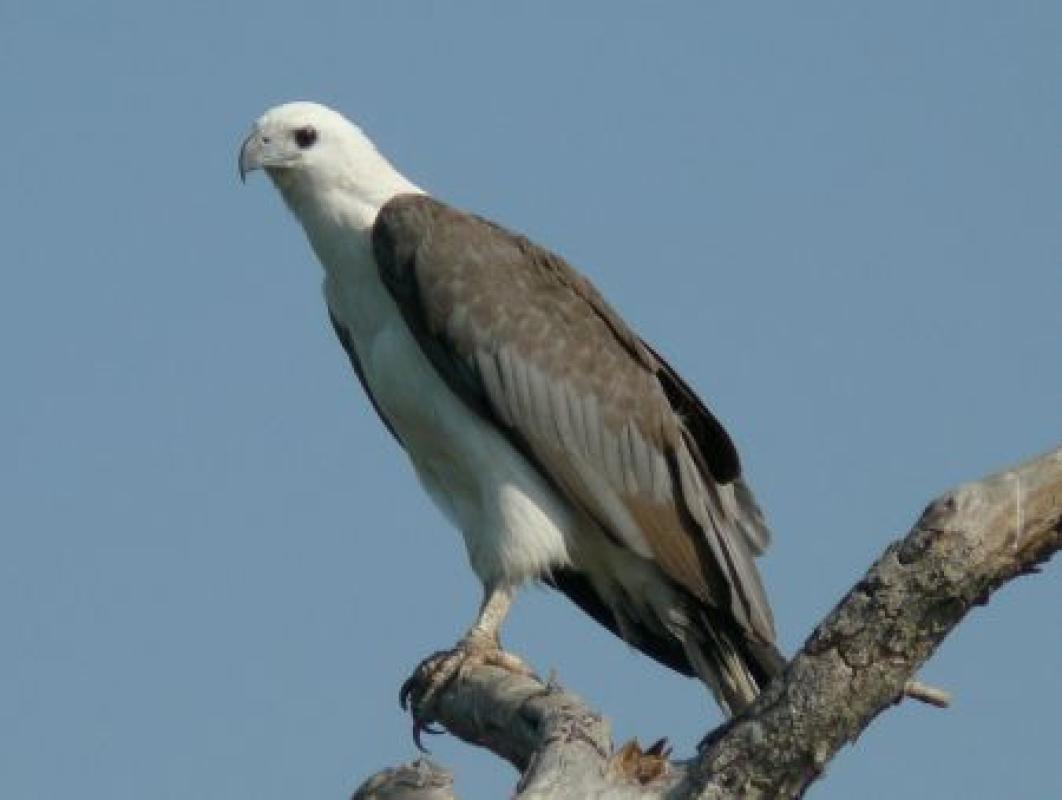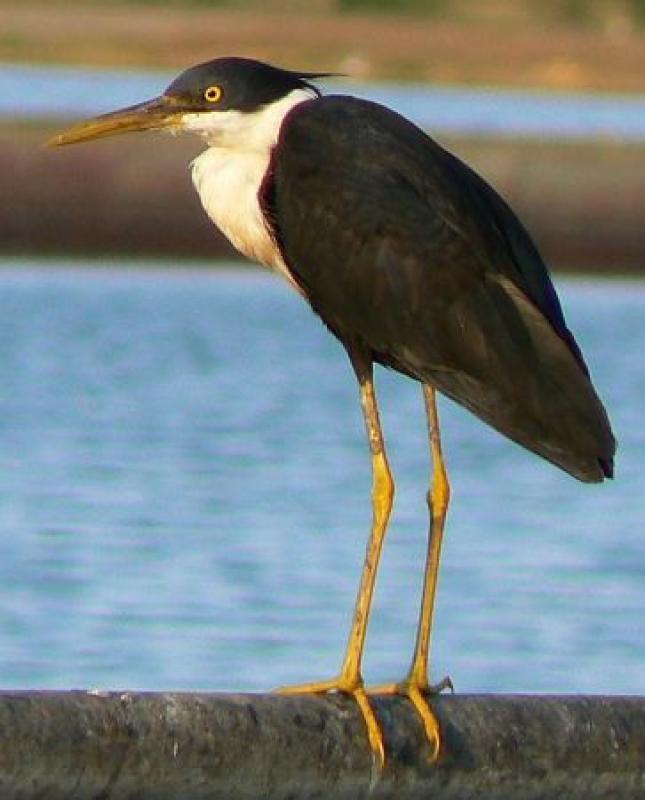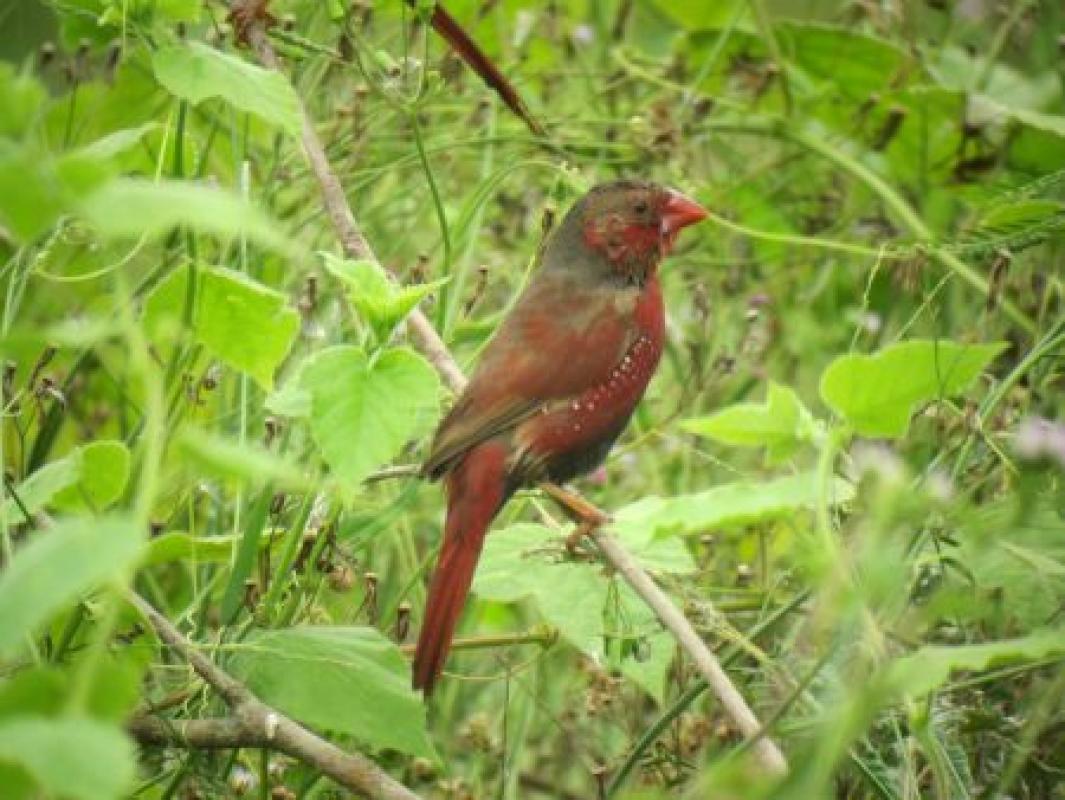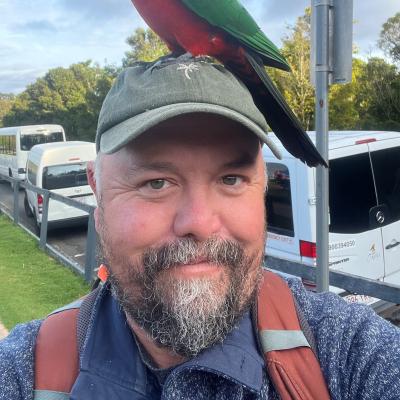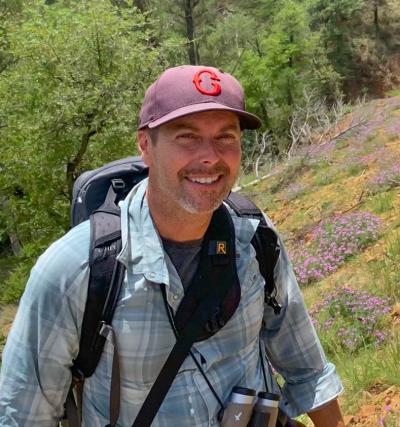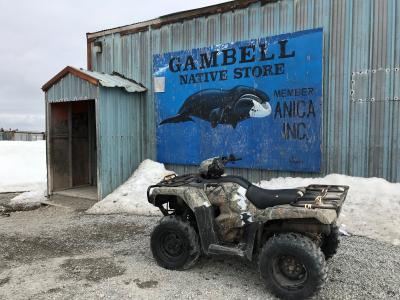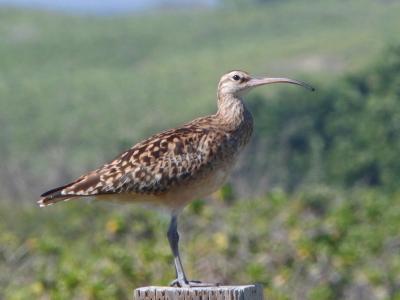Australia: Western Australia and Northern Territory
Brushtails, Baobabs and Bowerbirds
-
Sep 16 to Oct 2 2025
Gavin Bieber and Greg Greene
-
Sep - Oct, 2027
Gavin Bieber
2025
Single Room Supplement $1,180
2027
Tour Price to be Determined
2025
Single Room Supplement $1,180
2027
Tour Price to be Determined
The states of Western Australia and the Northern Territory contain vast tracts of uninhabited desert wilderness and thousands of miles of unspoiled and stunning coastlines, all filled with birds. Starting out in the picturesque city of Perth, we’ll have a full week to explore the remote southwestern corner of the country. Here we’ll seek regional specialties such as Baudin’s and Carnaby’s Black-Cockatoos, the stunning Red-capped Parrot, and the heathland trio of Western Whipbird, Noisy Scrub-bird, and Western Bristlebird.
After our week in the southwest we’ll head to the heart of the outback in Alice Springs. Here amid the scenic and ancient MacDonnell Ranges, and against a backdrop of outback billabongs and Ghost Gums, we’ll search for birds such as Zebra Finch, Budgerigar, the stunning Mulga Parrot, comical Spinifex Pigeon, and skulky Spinifexbird, Rufous-crowned Emu-wren and Dusky Grasswren. At the Alice Springs wastewater facility there are usually throngs of waterbirds, and sometimes we turn up a surprise like Oriental Plover, Australian Crake or Black Falcon.
Our third stop will be in the humid and lush tropical city of Darwin. Here a rich avifauna, flush with dazzling birds like Rainbow Pitta, Red-collared Lorikeet and Red-headed Myzomela, will keep us well occupied for several days. Our visit coincides with the latter stages of the dry season, and often huge numbers of waterbirds and returning migrant waders crowd the remaining waterholes.
Our final stop will be the remote outpost of Kununurra, in the far northeastern corner of Western Australia. This is the finch capital of the country, with up to ten species possible, including the gaudy Gouldian, scarce Yellow-rumped Mannikin, and pretty Star Finch. Here too we’ll look for sandstone specialties such as White-quilled Rock-Pigeon and Sandstone Shrike-thrush, and will take a very enjoyable boat trip out on Australia’s largest man-made lake to observe thousands of waterbirds and the scarce Yellow Chat. A flight back to Darwin will close out the tour.
This tour can be taken in conjunction with our tour, Australia: Queensland and New South Wales.**
Day 1: The tour starts with a 6 p.m. introductory meeting at our hotel in Perth. Night in Perth.
The Western Australia and Northern Territory tour was possibly the best I’ve ever been on. The mix of habitats, number of unfamiliar birds and great leadership made for an unforgettable time. Gavin combines a relaxed style with outstanding birding knowledge, a perfect leader. Peter Taylor’s local knowledge and quiet style was great. Tim Dolby combines local knowledge with an exuberant personality - most appealing. Vicky G.
Day 2: We’ll spend a bit of time this morning visiting one of Perth’s many city parks, where we’ll be introduced to some of the more common wetland birds of Australia. Stately Black Swans, lumbering Australian Pelicans, Pacific Black Ducks, Gray Teal, Blue-billed Duck, and perhaps the bizarre Musk Duck will be paddling around in the lake. Reedbeds should host Australian Reed Warblers and Little Grassbirds, and, with luck, perhaps Buff-banded Rail or Spotless Crake. In the open parklands around the lake we’ll encounter our first (of many) species of honeyeaters, such as Red Wattlebird and New Holland, Singing, and Brown Honeyeaters.
Leaving Perth behind, we’ll make our way to Narrogin, birding en route through the Darling Ranges and Dryandra Forest where we might encounter our first southwest endemics, such as Blue-breasted and Red-winged Fairy-wren, Western Yellow Robin, Rufous Treecreeper or Baudin’s Black-Cockatoo. The brushlands around Narrogin should produce our first Australian Ringnecks and perhaps Dusky or Black-faced Woodswallows. Night in Narrogin.
Day 3: Our hotel in Narrogin abuts a small but very nice wildlands park, and we’ll enjoy a pre breakfast walk across the road. Here we often encounter Red-capped Parrot and Western Rosellas, and if the local Eucalypts are in blossom there will be a host of honeyeaters and thornbills feeding in the trees. Later in the morning we’ll make our way to the vast Stirling Ranges National Park, stopping at the Wagin sewage ponds where the oddly proportioned Pink-eared Duck, the striking Australian Shelduck, and waders such as Black-fronted Dotterel are often present.
Our lodge is nestled on the north side of the Stirling Ranges, within easy reach of the national park. We should arrive in time for lunch at the local cafe. After checking into our rooms we’ll venture out into the park where the forests should hold Canaby’s Black-Cockatoo, Purple-crowned Lorikeets, Sacred Kingfisher, Restless Flycatcher, Western Shrike-Tit and a host of other new birds. Night at Stirling Range Retreat.
Day 4: We’ll spend the morning exploring some of the many dirt roads that bisect the national park. Keeping an eye on the skies as we drive, we might bump into a soaring Square-tailed Kite (more common in the southwest portion of Australia than in the east) or perhaps a Little Eagle. Western Rosellas and Red-capped Parrots should be foraging along the roadsides, and we will keep an eye out for circling Wedge-tailed Eagles, Emus out in the fields and perched up Tawny-crowned Honeyeater and Western Fieldwren out in the heath. The heathland south of the Stirling Ranges hosts over a thousand plant species, including some wonderful terrestrial orchids, many of which should be in full flower.
Our goal for the afternoon is to reach the coast at Cheynes Beach. Here our comfortable lodge offers excellent access to the coastal heathland and sandy stretches of beach that ring the southwest corner of the continent. In the late afternoon we’ll explore the roads around Cheynes, looking for Brush Bronzewing, Southern Emu-wren, Red-eared Firetail, and Western Wattlebird. Night at Cheynes Beach Caravan Park.
Day 5: We’ll concentrate on finding the three skulking heathland birds endemic to the area. Western Whipbirds should be quite vocal, and with some patience we should locate one perched low in the heath. Western Bristlebirds can sometimes be quite tame around the heathland behind the lodge, often coming out in the morning along the edges of the artificial firebreaks. The third species is Noisy Scrub-bird, which can be heard singing all over the reserve but will likely take a significant amount of time and patience to see as it scurries across a firebreak or forages on the ground in dense cover. This species was thought to be extinct until its rediscovery in 1961 at Two Peoples Bay and is one of two species in the endemic Australian family Atrichornithidae.
We’ll have time in the afternoon to bird some of the headlands around Albany, where given favorable winds we might spot Indian Yellow-nosed or Black-browed Albatrosses, Great-winged Petrel or Flesh-footed Shearwater. Mammals abound here as well, and with some luck we could find a diminutive Honey Possum foraging in flowering heath. Luck will not be required for us to spot Western Grey Kangaroos, which are nightly visitors around the cabins. The estuaries around Albany will offer our first groups of waders, with migrants from Asia joining the local specialties like Pied Oystercatcher, Red-capped Plover and Australian Fairy Tern. Offshore in October it is often possible to see Humpback Whales and Southern Right-Whales, and occasionally Sea-lions or Fur Seals haul out on the beaches. Night at Cheynes Beach Caravan Park.
Day 6: After an early start we’ll drive inland to the northeast of Cheyne’s Beach and an area of mallee (thin, multi-stemmed species of Eucalyptus that form open but dense forests along a latitudinal band in southern Australia). Although at first glance mallee forest can often appears nearly lifeless, an amazing diversity of wildlife uses these scrubby forests. We’ll seek out birds such as the appropriately named Shy Heathwren, Southern Scrub-Robin, and the odd Crested Bellbird (recently elevated to a nearly monotypic family). We’ll also visit a (hopefully active) mound of the impressive Malleefowl; the world’s southernmost megapode. In the afternoon we’ll either return to Cheyne’s or head south to the coast to explore some of the estuaries and headlands for waders and seabirds. The brilliant blues of the Southern Ocean, offset by high bluffs and gleaming white sands make for a most attractive backdrop to the birding. Night at Cheynes Beach Caravan Park.
Day 7: Today is largely a travel day as we return to Perth. We’ll stop en route to look for Western Corellas near the Ramsar-listed Lake Muir Wetlands. Our actual route will be determined by our chances for new bird species before we arrive back at our hotel. Night in Perth.
Day 8: A morning flight will take us to Alice Springs, in the center of Australia. This is outback desert country and contrasts strongly with the more temperate southwest. Known as the Red Centre for good reason, the local landscape is dominated by the rich red color of the rocks, and its sparse vegetation provides a home for a surprisingly varied avifauna. After lunch in town we’ll visit Simpson’s Gap National Park, open scrub country with a wealth of central Australian birds, including Pied Butcherbird, Western Gerygone, Gray-headed Honeyeater, Zebra Finch, Black-faced and Little Woodswallows, and Dusky Grasswren. Local rainfall in these deserts determines the presence or absence of many nomadic species, and some years we also see Budgerigar, Diamond Dove, Rufous Songlark, and Painted Firetail. Among the marsupials, Black-flanked Rock Wallaby is a local specialty. Night in Alice Springs.
Days 9–10: During these two days we’ll visit several spots farther away from town. Our choice will be determined by the local conditions, but whichever we choose we’ll be searching for many of the same species, including Spinifex Pigeon, Dusky Grasswren, Rufous-crowned Emu-wren, Spinifexbird, Western Bowerbird, and Red-browed Pardalote. One afternoon we’ll likely visit the Old Telegraph Station next to the spring after which the town was named, a good spot to see Common Walleroo, and the small but well-laid-out Olive Pink Botanical Garden, which often contains some very confiding Western Bowerbirds tending their grass bowers. On one evening we’ll visit a remote water hole where Bourke’s Parrots and Spotted Nightjars sometimes come at dusk to drink. Nights in Alice Springs.
Day 11: We’ll make an early visit to the ponds of the local sewage works to look for Hoary-headed Grebe, Hardhead, Red-necked Avocet, Black-fronted Plover, and White-backed Swallow. Being the only extensive wetland in the middle of a vast desert, the ponds attract any species that is passing through. In past trips we’ve seen Pied Cormorant, Freckled Duck, Gray-tailed Tattler, Long-toed Stint, Silver Gull, Orange Chat, and Oriental Plover and Little Curlew. Who knows what we may find this time! We’ll then catch a late morning flight to Darwin for a three-night stay.
In Darwin we’ll enter the true tropics, encountering many new and colorful species: Australian Figbirds perch on roadside wires, White-bellied Cuckoo-shrikes undulate overhead, and Torresian Imperial-Pigeons sit in the treetops. After checking into our hotel we’ll visit a nearby nature reserve at East Point. On a short walk along the coast on a brush-lined trail we should encounter Orange-footed Megapode as it struts around the lawns that fringe the reserve. Mobs of Agile Wallabies should be grazing on the short turf, and Bush Thick-Knees should be resting under some of the shade trees in the field. Depending on the tide, we may check the exposed reefs for roosting waders, which are likely to include Greater and Lesser Sand Plovers, Pacific Golden Plover, Gray-tailed Tattler, Curlew Sandpiper, Red-necked Stint, and Red-capped Plover. If the tide is low, Eastern Reef Egrets and Striated Herons are sure to be fishing in the rocky pools, and the occasional Brahminy Kite will be drifting overhead. Night in Darwin.
Days 12–13: We’ll spend two days visiting a variety of excellent birding spots around town. These are sure to include the following:
At Howard Springs we’ll walk the nature trail in search of the brilliant-colored and aptly named Rainbow Pitta. Most of the world’s pittas are skulking birds that are extremely hard to see, but this one is an exception. There are lots of other forest birds to look for as well, including Australian Koel, Spangled Drongo, Shining Flycatcher, Little Shrike-thrush, Yellow and Olive-backed Orioles, and a variety of strikingly patterned tropical honeyeaters. There is also a camp of Black Flying-Foxes here, as well as many exotic lizards, colorful turtles, and unusual butterflies.
We’ll visit Buffalo Creek, where, depending on the tide, we have a chance of glimpsing Chestnut Rail. It spends most of its time hidden in dense mangroves, but we’ll certainly hear it calling and with luck might even see it. While we scan for the rail, other mangrove species will entertain us, perhaps including noisy Black Butcherbirds, musical Green-backed Gerygones, dainty Yellow White-eyes, and colorful Azure Kingfishers. On the nearby beach large flocks of migrant waders and terns may be roosting, and these should include many of the waders that breed in Siberia and winter in Australia. A few resident waders may also be present, including perhaps the massive but surprisingly elusive Beach Thick-knee.
The mangroves that line Adelaide Creek should host Arafura Fantail, Broad-billed Flycatcher and Black-tailed Whistler, and in the creek itself we have a reasonable chance at spotting a lurking Saltwater Crocodile. Along the Marakai Track we’ll encounter a range of species more common in the drier interior forests such as Black-tailed Treecreeper, Northern Rosella, and with luck Gouldian, Long-tailed and Masked Finches.
A late afternoon visit to Knuckey’s Lagoon is always a delight as large numbers of waterbirds are sure to be present, including many herons, ducks, and waders. We’ll search among hundreds of Pied Herons, Magpie Geese, Radjah Shelducks, Green Pygmy-Geese, and Comb-crested Jacanas for scarcer species such as Wood Sandpiper and Long-toed Stint. In the past, local rarities have included Garganey, Ruff, Little Ringed Plover, Oriental Pratincole, and Yellow Chat, so who knows what we may find.
One day we’ll drive to Fogg Dam in the early morning, stopping along the way to look for Horsfield’s Bushlark and Black-faced Woodswallow. The lagoons behind the dam were originally a rice-growing scheme, but thousands of Magpie Geese quickly put an end to that idea and the area was turned into a nature reserve instead. Now it is a mass of reedbeds and lily-covered ponds, home to many waterbirds. Among the scarcer species we’ll hope for are Brolga, Black-necked Stork, Royal Spoonbill, White-browed Crake, Broad-billed and Paperbark Flycatchers, Tawny Grassbird, and Golden-headed Cisticola. Nights in Darwin.
Day 14: We’ll take a morning flight to Kununurra. This remote outpost town has experienced a great tourist boom in the last few years, making it comfortable and easily accessible from Darwin. Kununurra sits in an agricultural plain where irrigated fields are interspersed with vast wetlands and tropical dry forest. The mix of habitats here leads to a wonderfully diverse avifauna, with up to ten species of finch being perhaps the stars. We’ll spend the afternoon exploring near town, seeking out some of the rarer species such as Star Finch, Long-tailed Finch and Yellow-rumped Mannikin, in the vast network of agricultural fields in the Ord River floodplain. Night in Kununurra.
Day 15: We’ll have a full day to explore around Kununurra, and our destination will depend on what we are still looking for. One area we may visit is Lily Creek Lagoon, where we should encounter colorful Green Pygmy-Geese and White-browed Crake. At the nearby Hidden Valley Springs a walk along the roads and marked trails should produce White-quilled Rock-Pigeon, Sandstone Shrike-thrush, and Northern Rosella. And on the Weaber Plains we’ll seek out Australian Bustard, Brolga, and Australian Pratincole in the fields, various finches and cisticolas in the roadside scrub, and maybe Brown Quail. We might go farther afield in the afternoon, toward the coastal town of Wyndham, where Mangrove Gray Fantails occur in the mangroves, with stops along the way to look for Spinifex Pigeon and Gouldian Finch. Night in Kununurra.
Day 16: We’ll start early start for a comfortable morning cruise around the huge Lake Argyle. During the dry season, this giant lake supports simply stunning numbers of birds with hundreds of thousands of waterfowl and a good number of wading birds. Our chief targets, though, are three other birds: the nomadic and poorly known Yellow Chat, for which Lake Argyle is perhaps the most reliable spot; White-quilled Rock Pigeons which tend to sit unobtrusively on small rocky ledges; and Sandstone Shrike-thrush, which breeds on some of the lakeside sandstone bluffs. With luck we’ll see Short-eared Rock-Wallaby hopping about on the lakeshore, and we should have excellent views of Freshwater Crocodiles. After a pleasant lunch we’ll head back to the airport in Kununurra for a late afternoon flight back to Darwin. Night in Darwin.
Day 17: The tour ends this morning in Darwin. Those joining the Australia: The East - Queensland and New South Wales tour will catch an early morning flight to Cairns (not included in tour cost).
Note: The information presented below has been extracted from our formal General Information for this tour. It covers topics we feel potential registrants may wish to consider before booking space. The complete General Information for this tour will be sent to all tour registrants and of course supplemental information, if needed, is available from the WINGS office.
ENTERING AUSTRALIA: UK, US and Canadian citizens may travel to Australia on a passport valid at the time of entry with an Australian visa or, if eligible, on a valid passport and an Electronic Travel Authority (ETA), which replaces a visa and allows a stay of up to three months. The ETA costs $20 USD and can only be obtained online. NOTE as of 2022 you must download the app for the ETA from the app store. The ETA must be obtained BEFORE departure and should be done as soon as you purchase your flights, just to give yourself extra time. Instructions as well as a link to download the app are available here: https://immi.homeaffairs.gov.au/visas/getting-a-visa/visa-listing/electronic-travel-authority-601#HowTo
COUNTRY INFORMATION: You can review the U.S. Department of State Country Specific Travel Information here: https://travel.state.gov/content/travel.html. Review foreign travel advice from the UK government here: https://www.gov.uk/foreign-travel-advice and travel advice and advisories from the Government of Canada here: https://travel.gc.ca/travelling/advisories.
PACE OF TOUR: Walks will be on level ground over generally very even terrain and of a mile and a half in duration. Some optional walks out into habitat (i.e. off trail) will be offered while we are in the interior of the continent, and these may involve walking around brush or through some scratchy vegetation. A few of the trails, especially around Alice Springs may involve walking over some rocky terrain or through/around hostile vegetation. Note too that although each walk we take during the day will be short, we may cover 5-6 miles of walking over the course of a day.
Some days will be broken up into optional sections, with pre-breakfast excursions, morning/afternoon trips, and, on some nights, after dinner spotlighting for nocturnal mammals and birds. In some areas we make some long drives, so come prepared to spend a little more time than usual in the vehicles. Australia is a big country!
Whenever possible we’ll return to the hotel in the late afternoon/early evening and we’ll almost always have a break of an hour to shower and relax before dinner. We’ll compile a checklist of the birds we’ve seen just before or just after dinner each evening.
If you are doing more than one section of this tour it will be a long trip, so it is important to pace yourself appropriately.
HEALTH: The Center for Disease Control and Prevention (CDC) recommends that all travellers be up to date on routine vaccinations. These include measles-mumps-rubella (MMR) vaccine, diphtheria-tetanus-pertussis vaccine, varicella (chickenpox) vaccine, polio vaccine, and your yearly flu shot.
They further recommend that most travelers have protection against Hepatitis A.
Please contact your doctor well in advance of your tour’s departure, as some medications must be initiated weeks before the period of possible exposure.
The most current information about travelers’ health recommendations can be found on the CDC’s Travel Health website at http://wwwnc.cdc.gov/travel/destinations/traveler/none/australia .
Elevation: We do not ascend to any appreciable elevation while on this tour, with perhaps our highest point being about 1000 ft above sea level.
Water: Public drinking water is safe throughout Australia.
Insects: Bring a strong insect repellent for protection against mosquitoes, sand-flies and leeches which we may encounter at times. In general, we do not encounter high concentrations of biting insects during the tour but, especially in the interior of the continent non-biting flies can be a real nuisance at times in some years. Many participants have sworn by the use of headnets around Alice on busier fly years, although some years we see few to no flies during our visit.
Smoking: Smoking is prohibited in the vehicles or when the group is gathered for meals, checklists, etc. If you are sharing a room with a non-smoker, please do not smoke in the room. If you smoke in the field, do so well away and downwind from the group. If any location where the group is gathered has a stricter policy than the WINGS policy, that stricter policy will prevail.
ACCOMMODATION AND WIFI: Our hotels will vary from fairly basic in out of the way small country towns, to international airport hotels in Perth and Darwin. Almost all Australian hotels provide in-room refrigerators, tea and coffee making facilities and hair dryers. They also have self-service laundry rooms. Most of our hotels have a laundry service as well. In a couple of places accommodation is limited and we stay in cottages that contain two private bedrooms and one shared bathroom (per cottage). If necessary, we try to put two people in one of the bedrooms and one in the other, so that there are only three people sharing a bathroom.
WIFI is surprisingly not widely available in Australia, and when it is available, it tends to be slow, or very expensive. This is improving every year, but do not count on daily WIFI service throughout the tour. Currently the hotels in Perth, Alice (with a Hilton Honors membership), Darwin and Kununurra all offer free and good WIFI and access is improving in many of the smaller towns as well.
FOOD: We’ll normally have breakfast in our hotel. Sometimes this will consist of cereal, fruit, juice, coffee and toast brought to our rooms, and in other locations we will use the provided breakfast buffets. On some days we will have a picnic lunch while on others we’ll stop at a small cafe or take-away for sandwiches and a drink. Dinners are generally at or near our accommodation and are reminiscent of standard restaurant fare in the UK or US, with excellent seafood dishes on the coast. Exotic ingredients like Emu and Kangaroo are occasionally available. In general meals are expansive, hearty, and varied.
Drinks: A soft drink, a beer or a glass of wine is provided at lunch and dinner, as is coffee or tea. All other drinks or ‘personal’ drinking water for use in your room and during the day is the responsibility of the individual. Tap water is safe to drink and can be used to fill water bottles for daytime use. We will have a supply of water available in the van at all times.
All other drinks or ‘personal’ drinking water for use in your room are the responsibility of the individual.
Food Allergies/Requirements: We cannot guarantee that all food allergies can be accommodated at every destination. Participants with significant food allergies or special dietary requirements should bring appropriate foods with them for those times when their needs cannot be met. Announced meal times are always approximate depending on how the day unfolds. Participants who need to eat according to a fixed schedule should bring supplemental food. Please contact the WINGS office if you have any questions.
CLIMATE: This tour spans a wide array of habitats and climactic conditions. Temperatures could range from 10C (50F) and possible wind and rain while on the Southwestern coast, and up to 37C (98F) (rarely even a bit higher) and strong sun in Kununurra. Most of the tour will involve daily highs around 22-28C (72-82F) degrees, and lows in the 12-18C (53-65F) range.
TRANSPORT: Transportation on most of the tour will be in a minibus driven by the leader. All participants must be willing to take their turn in the back seat and a daily rotation of seating positions will be encouraged. During some portions of the tour a local Australian co-leader will accompany the group and will take the front passenger seat. In the Northern Territory we may have to use two smaller vehicles with radio communication to comply with local requirements.
For our internal flights (Perth-Alice Springs, Alice Springs-Darwin, Darwin-Kununurra-Darwin) we use Australian based airlines.
Interactive Map
2023 Narrative
IN BRIEF: The weather during the Australian spring of 2023 was unusually warm across most of the country, although a good period of rain earlier in the year had resulted in a marked increase in fresh vegetation growth and access to surface water than much of the last decade. We found conditions around Alice, Darwin and Kununurra abnormally hot, with temperatures up to 10 degrees Celsius above historical averages. Irrespective of the weather conditions though, our tour covered an amazing breadth of habitats and birds. We spent the first week around the Southwestern corner of the country, where we explored towering Marri and Karri forests, mallee, coastal heathland and windswept seaside cliffs and beaches. Here we found all twenty of the SW endemics and enjoyed particularly good views of two of the infamous skulkers; Western Bristlebird and Western Whipbird, as well as a host of waterfowl including Freckled Duck and the bizarre Musk Duck. Mammals were good too, with lots of Western Grey Kangaroo, close range Southern Right Whales in the bay at Cheyne’s Beach, two Numbats in Dryandra Forest and even a diminutive Honey Possum!
We then spent a few days around Alice Springs, a small city nestled into the ancient MacDonnell Ranges which rise up from the surrounding desert and contain permanent water sources and dry creek beds lined with bone-white Ghost Gums. Here the bird list was shorter, but many truly special species kept us amply entertained. Spotted Bowerbirds displaying over their bowers, Little Woodswallows soared over ancient red-rock cliffs, Pink Cockatoos were busily readying their nest cavity and Bourke’s Parrots visited an outback waterhole at dusk. Our hoped-for Dusky Grasswrens and Spinifexbirds performed well, and we came across several of the locally ephemeral desert nomads such as Budgerigar, Banded Whiteface and Crimson Chat. We also succeeded in tracking down some of the harder local species such as the stunning Painted Finch, cute but dumpy looking Chiming Wedgebill and very attractive Cinnamon Quailthrush (which showed amazingly well this year).
Leaving the arid interior behind we then flew up to the humid and tropical Top End where the bird diversity markedly shot up. Rainbow Pittas preformed wonderfully, and we enjoyed masses of waterbirds including our first Whistling-Ducks, Pygmy-Geese and Magpie Geese, colourful Black-necked Storks around Knuckey’s Lagoon. A day roosting Rufous Owl at the botanical gardens and a pair of actually visible Chestnut Rails provided our day one highlights around Darwin. Around Fogg Dam we tracked down some calling Rose-crowned Fruit-Doves and our first close up encounters with Crimson Finch, Little Curlew, Australian Pratincole and Comb-crested Jacana. At the mangroves along the nearby Adelaide River both Broad-billed Flycatcher and Black-tailed Whistler showed well, along with a still unresolved Reed Warbler that was lurking in the underbrush. Darwin was good to the end, as just before we went to the airport our local contact informed us of some excellent birds in a nearby marsh. Twitching an Asian Dowitcher and a Broad-billed Sandpiper, as well as our first Marsh Sandpipers and Glossy Ibis was a nice way to close the section of the tour!
For the last leg of the tour, we spent a day exploring the Ord River Floodplain near Kununurra, where we definitely enjoyed a wealth of Australian finches; finding Long-tailed, Masked, Star, Gouldian, Zebra and Double-barred in patches of seeding grasses and a little flock of flying Pictorella Munia. A pair of beautiful Buff-sided Robin showed well a bit north of town, and around the town of Wyndham we located a flock of Cockatiel, Mangrove Fantail, a pair of Northern Rosellas and a host of new honeyeaters including Rufous-throated, Yellow-tinted and Bar-breasted and the striking looking Silver-crowned Friarbird. Also here we spent our last full morning out on the vast Lake Argyle, where our highlights included beautiful Yellow Chats, a hulking Australian Bustard, Sandstone Shrikethrushes and White-quilled Rock Pigeons scurrying about on red sandstone island cliffs and a nice selection of waders including Oriental Plover and Long-toed Stint. All too soon the tour wrapped up, with a trip list of 319 species. The diversity of wildlife and birds to be found in this less traveled and more wild western side of the country is simply staggering, and I can’t wait to return in 2025!
IN FULL: We started our tour with a visit to nearby Herdsman Lake, one of the premier waterbird spots around Perth. We spent a very enjoyable and relaxed two and a half hours walking along the lakeshore, which was considerably higher than normal due to a recent spate of rain. The grassy verges of the lake were liberally sprinkled with hulking Australasian Swamphens, Dusky Moorhens and Eurasian Coots, many with fuzzy babies in tow. Waterfowl were particularly well represented, with family groups of Black Swans and Maned Duck, quietly foraging Pacific Black Duck, Grey Teal, Hardheads, and a single male Freckled Duck. This last species was a welcome sight, as the species is quite nomadic, and not particularly numerous. Our views of the bizarre Pink-eared Ducks with their huge and highly curved bills, zebra striped flanks and black eye spots were particularly good as several birds loafed in the shade of some overhanging trees along the path, occasionally showing off their namesake pink feathers and we were thrilled to spot a brood of young ones as well, already with their oversized bills attached to their still fuzzy bodies. Along with the waterfowl show we located several pairs of Great Crested and Australasian Grebes, Little Black and Little Pied Cormorants, a few gigantic Australian Pelicans, all three species of possible Ibis (Australian Straw-necked and Glossy), and a smattering of herons. The reedbeds hosted an unusually cooperative Australian Reed Warbler which sat obligingly for us for nearly a minute, and two handsome Buff-banded Rails. Flowering bottlebrush trees along the paths were hosting dozens of gaudy and raucous Rainbow Lorikeets (actually introduced to SW Australia) glowing brightly in the morning sun, and a smattering of Honeyeaters including numbers of quarrelsome Red Wattlebirds and Brown Honeyeaters as well as a few New Hollands. The open lawns along the walking path were full of a suite of black and white birds; with Willie Wagtails, Australian Magpies, Magpie-Larks and Australian Ravens all marching along the grounds looking like they owned the place. In the paperbark forest patches around the lake we spent some time watching a pair of flitting Gray Fantails, as well as a perched female Rufous Whistler and a quick-moving flock of Silvereye.
At another nearby section of the lake, we quickly found a pair of staked out Tawny Frogmouths stoically resting right above the busy walking and jogging trail that encircles the wetland. These loggerheaded birds with their massive orange eyes and huge bills are quite imposing, somewhat of a cross between a large nightjar and an owl. The male was sitting on a nest and the female was huddled up in a nearby tree. For such large birds, sitting in such open trees, frogmouths can be remarkably difficult to spot by chance, so having such approachable and staked out birds (and some assistance from a local birder) is always a boon. Leaving Herdsman Lake behind we stopped in at nearby Lake Monger, where our chief motivation was to use the public toilets. The birdlife of this more open and deeper lake though was its own reward, and we spent a few minutes studying up close Australian Shelducks, a dapper and colourful duck with a bright patchwork pattern, some handsome Blue-billed Ducks, and a surprisingly large number of Hoary-headed Grebes; a somewhat unpredictable nomad in the Perth region.
Leaving greater Perth behind we headed out to the Southeast, and after a quick stop for lunch and provisions in Armadale started to drive inland and uphill into the Darling Ranges. A short comfort stop in the whimsically named town of Wandering stretched out a bit as we tracked down a singing Rufous Songlark and some foraging New Holland and Singing Honeyeaters around the city park, but soon enough we reached our main birding area for the afternoon; the Dryandra Woodland National Park. This recently designated area protects a large native patch of drier wandoo eucalypt forest that is surrounded by a vast agrarian landscape with paddocks filled with sheep or the odd cow, and fields of flowering rape and seeding wheat. Arriving in the forest we started to slowly make our way across the reserve, stopping wherever activity seemed to dictate. At our first stop we found several bright orangey/buff Rufous Treecreepers foraging on the ground or clambering up nearby trunks. Yellow-plumed Honeyeaters were seemingly in every tree, and several Dusky Woodswallows were sallying out in the midstory. Our marquee sighting for the stop though was certainly the very cooperative pair of Western Shriketits that lingered for some time in a tree just overhead. Although widespread in southwestern Australia this species is generally quite scarce. Their oversized bills, snazzy black and white head pattern and bright yellow and white underparts combine to give the species the gestalt of a carnival-bound oversized vireo. Further into the forest we stopped to look at a trio of furtive Blue-breasted Fairy-Wrens that were lurking in some roadside pea flower shrubs. Although they never seemed to sit still to pose for the assembled cameras the males showed well as they occasionally sat up on a higher bit of vegetation before vanishing back into the shrubbery. Some very vocal Spotted Scrubwrens and a pair of interacting Striated Pardalotes were happily much more confiding at the same stop. A few lucky participants also spotted a handsome Western Yellow Robin that was perched on a low snag a few dozen meters off the road. It’s hard to pick out a favorite from the diverse and highly charismatic family of Australasian Robins, but each of the many species that we found during the tour was a crowd pleaser.
We then moved a bit further to the north in the park, where we managed somehow to time our visit perfectly, with two Numbats seen foraging along the road and lingering for even a short photo-shoot! This sighting marked our first for the species on our WINGS tours! Numbats are diurnal marsupials that specialize in eating termites. They resemble a cross between a squirrel, a mongoose and a small anteater, and with their banded bodies, bushy tails and long nose they are quite a unique animal. The species is critically endangered species with fewer than 1000 remaining in the wild. Their once large range is now confined to just a few small areas around Dryandra and adjacent parks. Happily though, within this tiny area the population seems to be slowly increasing due to the intensive trapping efforts of cats and foxes by the local park service. After the second Numbat crossed the road we turned our attentions to a perched Purple-crowned Lorikeet up in the canopy, a species that to this point we had only seen as little green screeching rockets zipping overhead. With this perched bird we could finally make out its dark purple crown, red, yellow and orange facial colours and delicate blue chest, a fitting bird to cap off our quite satisfying day list. We made one final stop as we drove the short distance on to our hotel in the little town of Narrogin where we added a second quintessentially Australian mammal to our day list with a mob of Western Gray Kangaroos hopping around in some open fields. It was truly a magnificently rich day, and a great kickoff to our two-and-a-half-week tour through Australia’s magnificent west.
On our second day we started with an optional pre-breakfast walk to a parkland across from our hotel. Although this patch of woodland has not yet fully recovered from a recent burn and the effects of Eucalypt die-back (a fungal pathogen that has recently been badly affecting large areas of Southwestern Australia) we found it to be quite birdy. Honeyeaters were particularly prevalent, with loads of garrulous Red Wattlebirds, New Holland and White-cheeked Honeyeaters chasing each other around between the flowering shrubs and a single Gilbert’s Honeyeater that responded well to our broadcast calls. Parrots put on a good showing as well, with gaudy Red-capped and vocal Australian Ringnecks, a pair of perched Elegant Parrots on a distant snag and excellent views of a couple of Western Rosellas vying for our attention in the treetops. At one point we stopped to call in a responsive Horsfield’s Bronze-Cuckoo, and while watching the bird as it sat on a bare limb above us a flurry of wattlebirds and parrots suddenly flew in chasing a hapless Southern Boobook! The owl dove into a large cavity just above us, with the throng of victorious honeyeaters and parrots lingering above the hole. The show wasn’t quite over though, as we teased in a pair of Western Thornbills that showed well in a short shrub along the road edge. These quite dull thornbills are somewhat thinly distributed across the SW corner of the country, and although their largely unmarked yellowish-buff plumage will likely not contribute to a victory in any upcoming thornbill beauty pageant they are sprightly and charismatic little birds that can be hard to consistently locate. We then headed back to our lodge for a well-deserved breakfast; there’s nothing better than a half-dozen or so life birds to whet the appetite!
After breakfast we began the journey south towards the Stirling Ranges, roughly 200KM to the SSW. Just a few miles into the journey we stopped at a roadside swamp fringed with samphire and saltbushes. Here we quickly located a cooperative pair of White-fronted Chats, a perky tricoloured species of largely terrestrial honeyeater. The male in particular is a sharp-looking beast, with a starch white face and belly split with a crisp black breast band. A bit further to the south we stopped in at the small town of Wagin. The town’s claim to fame is undoubtedly the “Home of the Giant Ram” roadside attraction; an oversized white (and anatomically correct) ram statue that towers over a park in the center of town. We made the obligatory stop at the roadside attraction, where in addition to the statue we were happy to locate our first sitting Common Bronzewings; a portly and largely terrestrial pigeon with an amazingly bright reflective wing that glitters with all the hues of the rainbow in good light.
Just a bit down the road we stopped in at the Wagin Sewage Works, where we were a tad disappointed to see some new fencing up around the ponds. We scanned from outside the verge and located a foraging Wood Sandpiper along the back bank. This caused us to continue down the short dirt track around the pond, which proved to be exceptionally productive. In the ponds we located a few Australian Shelduck and Australasian Shoveler among the many Gray Teal, Pacific Black Ducks and Coots. Along the berms between the ponds we were surprised to spot two Black-tailed Native-Hens strutting along between some bushes. This is quite a sporadic species in the southwest, preferring to breed well inland in ephemeral swamps. It was really the bushes around the ponds though that captured most of our attention. A family group of White-browed Babblers put on an excellent show as they gathered nesting materials and chattered to each other about their individual takes on the best building techniques. On the overhead wires we scoped a perched Crested Pigeon; yet another common but stunningly attractive bird that sports a thin crest, zebra striped mantle, peach neck, orange eye and prismatic reflecting wings. The site also produced another surprise, when a pair of Mulga Parrots flew in and landed just in front of us before foraging in the roadside grasses. Despite the rather off-putting name these exquisite birds, with distinct sexual dichromatism are perhaps the brightest of the small green parrots in Australia. The pair allowed close approach, and the bright emerald, yellow and red male really sparkled even in the overcast skies. Once back at the vans we stopped to admire a Spotted Jezebel (a bright yellow, red, white and black butterfly) that was foraging in some mistletoe clumps near where we were parked. Leaving Wagin behind, we headed a bit further south, where we stopped for lunch at a recently opened and surprisingly upscale café built in the renovated old flour mill building in downtown Katanning.
As Qantas Airlines in their infinite wisdom has yet to resurrect their standard Perth direct to Alice Springs flight we knew that we would be finishing the southwest leg of the trip with a drive back to the Perth airport from the coast. In an effort to make that drive a bit shorter and easier we decided to spend the balance of the afternoon a bit to the west, where we could look for Western Corellas and if successful cut out a good chunk of driving on that last day. We made a driving loop over to Frankland River, down to Rocky Gully and then back East towards Mount Barker. This proved an excellent plan, with multiple sightings of Corellas along the roadside. The first was a single and distant bird foraging in some taller grasses. The second sighting involved a dozen or so birds at a much closer distance that were foraging for tubers in a short grass field along the road. It was the third sighting though, near the center of Rocky Gully where we really were able to enjoy this species at close range. Nearly forty birds were busily feasting around a pig pen in someone’s backyard. Several were perched around in the nearby trees, offering excellent photo opportunities and a good study of their elongated upper mandibles and red-washed faces. Near the tiny town of Broomehill we stopped to investigate some obvious bird activity and were happy to have close views of our first Black-faced Woodswallows, Yellow-throated Miners (here of the Southwestern “Dusky” subspecies that lack any yellow in the throat) and foraging Elegant Parrots and Galah. A bit further south we stopped to watch a large group of Emus that were running around in a roadside clearcut, keeping a wary eye on us as we trained cameras in their direction. As we neared Mount Barker we ground to a halt when we spotted a flock of white-tailed black cockatoos foraging in a large field of rapeseed. Most were Carnaby’s Black-Cockatoos, but we did detect a pair of the longer billed Baudin’s perched in a nearby tree, and when going over our photos found a few others lurking amongst the Carnaby’s. Being able to watch these huge black parrots with their deep moth-like flight pattern and huge white tail flashes at length and at such a close range was a special experience, made all the better by the regular passing of small flocks of Regent Parrots that were also out foraging in the fields. We had dinner in the town of Mount Barker in (seemingly) the only open restaurant in the region, and then finished the drive over to our base for the night at the Stirling Range Retreat.
We awoke the next day happy to be able to see what the lodge grounds actually looked like. The property sits just to the north of the Stirling Ranges; a small series of peaks that rise up from the plateau to heights just above 3000ft. Long famous for its rich floral diversity (with over 1500 species of plants known from the National Park) and scenic beauty the park was one of the first protected areas of Western Australia. We met up for a relaxed hour or so walk around the grounds and over the highway into the park. Even in the somewhat unseasonably cold (and lightly drizzling) conditions we located a wide selection of species. Just outside our arc of cabins we tracked down a very vocal and active Restless Flycatcher as it moved around in the midstory. Little groups of Yellow-plumed, Brown and New Holland and the occasional Gilbert’s Honeyeaters were buzzing around in the flowering trees, and an impressive number of Purple-crowned Lorikeets were zipping overhead. Happily, a few of these diminutive parrots did eventually sit well for us, showing off their multi-hued heads to great effect. Near the registration building we were thrilled to spot a couple of perched Regent Parrots, close enough to us that we could really enjoy their odd chartreuse plumage with red/pink centered coverts. Across the road we spent some time around the carpark, where, perhaps the large trees were providing a bit of shelter from the winds. Here the highlight was undoubtedly a pair of quite cooperative Scarlet Robin, a showy species clad in bold red, black and white with a brilliantly white forehead. A little mixed flock of Weebill, Western and Inland Thornbill and Striated Pardalotes put on a good show; although we were constantly getting distracted by a ridiculously tame pair of Grey Fantails that were coming to within just a foot or so of our lenses. A pair of Carnaby’s Black-Cockatoos were prospecting for nest sites around the larger trees, with the female repeatedly disappearing into various hollows while the male looked on patiently. The floral show was excellent as well, with three species of terrestrial orchids (including a couple of impressive White Spider Orchids), some bright red sundews and a wealth of intensely colored flowering peas. Everywhere we turned it was just very apparent that we were in another world, far removed from our normal haunts in the northern hemisphere.
After packing up we headed a bit back north to bird along the northern edge of the park where some large saline lakes and short heathland provide excellent birding. As we neared the turnoff we stopped to watch a pair of circling Wedge-tailed Eagles that were cruising over the heath below the road. At the first of the saline lakes we carefully scanned the edges and were rewarded with views of a single Hooded Plover foraging on the opposite shore. These elegantly marked birds possesses a black hood decorated with a bright red bill and eyering, and is perhaps the most striking of the Australian plovers. It’s an endangered species, confined to the southern coast of Australia, most birders see this species somewhere on the heavily trafficked sandy beaches of Tasmania and Victoria. In the southwest though the birds breed on inland lakes are certainly in less danger of disturbance and as a result the area is a stronghold for the species. The heathland around the lake supported a healthy population of Tawny-crowned Honeyeaters, several of which deigned to stay put for lengthy scope views before tearing off to chase a nearby rival. Our other main target species for the site, Western Fieldwren performed well (for a fieldwren), perching up on some low bare branches and lingering long enough for some photos. This attractively pattered bird, with streaked yellow underparts and a touch of rufous on its forehead is a recent but now generally accepted split from the more widespread Rufous Fieldwren, and endemic to the southwest corner of the country. As we started to drive south we were distracted by a passing Spotted Harrier that was alternating between being chased by some irate Magpies and chasing them. Unfortunately, the bird drifted out of view before the other van could rejoin us. We had better luck with a perched Gray Butcherbird which lingered for quite a long time along the road, occasionally diving down into the heath to grab an unsuspecting bug or lizard.
Next, we headed a bit to the southwest, to another low set of hills called the Porongurup Ranges. Here stately Karrii trees (stretching upwards of 200 ft high) grow atop a dense understory of shrubs and small Eucalypts. As it was near midday by the time we arrived and there was a stubborn drizzle in the air we elected to stop in at the local tea house for lunch. The café is in a wonderfully idyllic country setting, with lush grounds full of flowering plants, a local art gallery and local gift shop, and some of the friendliest proprietors around. Often, they are hosting rescued orphan animals which they nurse (a near round-the-clock operation) before releasing them as adults. During our visit they didn’t have any animals on show, so we made do with the excellent sandwiches, quiches, and sumptuous scones. Almost as soon as we entered the national park we stopped to watch a small flock of Red-tailed Black-Cockatoos that were calling and perching in the trees just off the road. This is perhaps the most spectacular of Australia’s many gaudy parrots, smartly clad in black and crimson (or orange for the females) with a large shaggy crest and creaking ethereal calls. At the carpark near the end of the park road, we were somewhat disappointed to find the park service noisily clearing some trees around the bathroom block with a chainsaw. We waited around a bit and the noise died down, revealing a lovely group of White-breasted Robins that came out into the clearing and busily bounced around the leaf litter along the road edge looking for insects activated by the rain. Here too was our first Western Whistler that came in quite close to the group, and a couple of busy little Inland Thornbills.
As the afternoon was beginning to wane, we turned southwards towards the coast, travelling along little used back highways that passed through some rich agricultural land, often with small wetlands scattered about in the lower areas of the fields. Another Spotted Harrier drifted over the road as we neared the coast, again skipping away before offering solid views. We arrived at our base for the next three nights, the Cheyne’s Beach Caravan Park in the late afternoon. Although the park has ample options for tent, caravan and trailer camping we take advantage of their free-standing and very modern chalets that are perfectly positioned to provide easy access to the coastal heathlands and scrub in this remote corner of the country. The view of the sweeping white sand beach, with the azure waters of the Southern Ocean is superlative. Our principal reason for visiting this corner of Australia was, as always, to spend some time looking for a trio of scarce and generally retiring birds that are resident in the dense coastal heathlands. Virtually all Australian birders make the pilgrimage out to Cheynes at some point in their lives, hoping for glimpses of Western Scrubbird, Western Bristlebird and Western Whipbird. After a bit of time off we met up and looked around the cabins a bit, finding Splendid and Red-winged Fairywrens, Spotted Scrubwren and White-breasted Robins on the lawns. Down on the postcard perfect powdery white sand beach we located a couple of passing Pacific Gulls, a large black-backed gull that possesses an almost comically oversized bill that seems purpose built for splitting hapless crabs into tiny bite-sized bits with ease. Here too were three hulking Sooty Oystercatchers, a pair of Ospreys (here of the eastern subspecies group with shorter and more hawk-like wings, and a bulkier body than that of their northern cousins) and a single Caspian Tern. Perhaps overshadowing all of these sightings though was a female Southern Right Whale with a young calf that were lolling about in the shallower waters of the bay. We finished our birding for the day with an obligatory vigil along a short dirt road leading to the beach that cuts through a small patch of dense heath. The road bisects the territory of a Noisy Scrubbird, and many a visiting birder has waited patiently here for the bird to cross over the road, briefly forced out of its preferred dense cover. Perhaps due to the recent (and over-zealous) clearing of the road edges by the local council our sighting didn’t materialize, though we could hear the ringing calls of the local bird, named Noisy Nick by the local birders, emanating from the dense scrub. Dinner, prepared by the cooks at the caravan park office was excellent, and we enjoyed it on the covered back deck of the hosts house, paired with some local wines.
We met up the next morning early and started up the trail that leads into the sandy heathland above the chalets just a bit after sunrise. The winds were slight, and the skies overcast, making for excellent birding conditions. The heathland along the coast here is stunning, with a myriad of showy and unique flowers and shrubs scattered all along the sandy tracks. Likened to the cape region of South Africa these coastal heaths of southwest Australia are one of the richest sites of floral endemism on earth. In accordance we punctuated our walk with many a stop to admire various flowering sundews, Banksias or showy flowers. Around the edge of the heath were prodigious numbers of very active New Holland Honeyeaters, which soon gave way to White-cheeked Honeyeaters as we progressed further into the habitat. Near the beginning of the tract we stopped to watch our first Western Wattlebird that was foraging in a flowering Scarlet Banksia a bit off the trail. This localized species lacks a wattle and is smaller and darker than the by now familiar Red Wattlebird. Both Western Bristlebird and Western Whipbird appeared with very little effort once we were up on the higher ridges of the heathland. A pair of Bristlebirds actually crossed the sandy track in front of us several times, even feeding along the verge of the road as they slowly made their way up towards our position. The Whipbird (which often can occupy several hours or even days’ worth of a birders time) started singing in a taller thicket and soon vanished as it was chased by some aggressive White-cheeked Honeyeaters. Happily though it reappeared several times, even climbing up into a several tall bare trees where we were able to watch it for a few minutes as it advertised its presence in full view! As we began to walk downhill another (or perhaps the same) Whipbird clambered up into a bush just a few feet away from half of the group, lingering for just enough time for some frame filling camera shots before it flew across the tract and dove back into the heath. Nearby we tangled with several groups of Southern Emu-Wrens which proved to be a bit more reticent, popping up into view for just enough time for a couple of participants to get on them before performing their customary vanishing act. Peter remarked that it was perhaps the best morning show that he had ever had for these two normally very reclusive species. Raptors were not as prevalent as usual, though we did enjoy a close flyby from a pale morph Brown Falcon. It’s an oddly shaped bird for a member of the Falco genus; broad of wing and with a dihedral flight profile and spotted a distant Kestrel over the ridge. The best raptor was spotted as we walked back, with an adult Little Eagle (widespread but never numerous across all of Australia) that was circling low overhead. As we neared our cabins for breakfast, we paused to watch some Western Gray Kangaroos foraging along in the heath and relaxing in the shade of the road. We also were happy to spot a cooperative (rather oblivious to our presence) Brush Bronzewing at the edge of the caravan park. After a bit of a break for coffees and breakfast we opted for another walk up into the heath and around the margins of the park. It took a while for us to leave the cabin area, as we located several quietly feeding Brown Quail, a pair of Red-winged Fairywrens and our first good views of Red-eared Firetails all around our chalets! It’s hard to choose a favorite Australian finch, as there are many truly snazzy species, but this one recalls one of the best African twin spots, with jet black flanks liberally spotted with large white spots and a scarlet stripe across the auriculars and rump. Our walk up into the heath revealed several fast-moving Western Spinebills that did eventually slow down enough for us to drink in their gaudy orange and black plumage. Here too we tried our luck with two different singing Noisy Scrubbirds, again finding them unwilling to pop out along the small firebreak trails and into view. Along the edge of a large farm paddock up on the higher part of the heath we counted an impressive 93 Australian Ravens, and located a perched Australian Pipit sitting up on a grass tussock. Also here we were able to see the sparkling waters of the bay, with at least five Southern Right-Whales, including two calves. Several of the whales were active, with one half-breaching and the others repeatedly fluking or rolling over at the surface. Just before lunch we stopped to admire a pair of Western Whistlers, this time including a handsome gold, black and white male that were sitting in a bush along the edge of the park.
In the afternoon we decided to drive out to the nearby city of Albany to look over some estuaries and bays for waders and other more open country birds. As we neared Albany, a small but pretty city that houses around 30000 people and is set in one of the largest natural harbors in the country we passed through an area of open ranchland, with healthy looking herds of cows or horses grazing bucolically with Straw-necked and Australian Ibis in tow. Our main stop for the afternoon was Rushy Point, a small promontory that juts out into the western side of Frenchmen’s Bay and is surrounded by extensive mudflats and eelgrass beds at low tide. Around the carpark we scanned the bay to the south, finding our first snoozing Common Greenshank, a passing Caspian Tern and a nice comparison of all four species of local cormorants. Some bushes along the edge of the picnic area were hosting a trio of Southern Emuwrens that actually decided to pop up several times, offering a much better showing than the earlier birds in the heath. We then walked along the short beach out to the actual point, stopping to admire some strands of a local algae with odd swollen nodes that apparently is known as Neptune’s Necklace. Although our tour is timed in the early spring; a generally too-early date for peak wintering northern Hemisphere waders this far south in Australia we did find a few species of interest around the point. A large flock of Red-necked Stints was out on the exposed mudflats, with a dozen or so Black-bellied Plovers and two Red Knots nearby. A Pied Oystercatchers was a bit further out as well, providing a bit of colour among the more understated wintering waders. Pacific and Silver Gulls, White-faced Herons, Great Egrets and Australian Pelicans were liberally sprinkled around the bay, foraging on small crabs among the eelgrass beds. Right out at the point we found another Caspian Tern, this time sitting with some smaller terns orbiting around it. We zoomed the scopes up and were happy to be able to see that these smaller birds had white foreheads, orange-yellow bills and orangey legs, all fieldmarks for Australian Fairy Tern. This is a patchily distributed coastal tern around the southern half of the country. It’s listed as vulnerable in Australia and is endangered in New Zealand as it prefers to breed on sandy beaches, and is easily disturbed by people, pets and vehicles. By this point the afternoon was waning, so after a comfort stop (where we also briefly ogled a large and black King’s Skink that was sunning on a roadside rock) and another break for fuel we headed back to Cheyne’s for a delicious dinner prepared by our hosts.
We started our last full day down on the southern coast with a morning departure for the mallee forests of the Corackerup Nature Reserve, about 120KM East of our base at Cheyne’s Beach. Unlike most mallee forest in eastern and central Australia that have a bed of patchy Spinifex in the understory this western mallee has a heathy understory, rich in flowering shrubs. Our first stop was in the town of Wellstead, where a planned short stop for bathrooms stretched into a bit of a birding bonanza. Flowering trees around the small botanical gardens were attracting heaps of New Holland Honeyeaters and Red Wattlebirds, and while scanning the surrounding area we picked up Nankeen Kestrels and Crested Pigeons and were thrilled to scope a quietly sitting Black-shouldered Kite on a distant snag. Once we reached Corackerup Nature Reserve we spent the rest of the morning walking along a wide firebreak access road through the forest, choosing this particular track as it passes by an occasionally active Malleefowl nest. Early October is traditionally a good time for the species to begin tending their giant mound nests. The timing varies with the years though, with individual birds commencing their daily nest tending only once the temperature regime is to their liking. Unfortunately for us, the mound was not recently active. We were able to the structure though, and many were (I think) surprised at its size. Malleefowl mounds are about 3.5 feet high and easily 10 feet in diameter, and comprised of a substantial amount of decaying vegetation topped with a conical cap of dirt. The males work hard to maintain a constant temperature of 33 degrees C while incubating the eggs. Truly an engineering feat that surpasses the ability of most humans!
Although no Malleefowl appeared during the walk we managed to drum up a nice selection of other mallee specialties, with Southern Scrub Robins calling virtually our entire walk. These large and long-tailed Robins are in a different genus than most of the Australian “Robins” and actually quite closely resemble some of the African Scrub Robins (though they are not closely related). It took a few tries before we achieved good views of a sitting bird, but it was worth the effort. Surprisingly the other typically even more skulky specialty species here performed amazingly well. A pair of Shy Heathwrens responded vigorously to our proffered calls, lingering along the edge of the tract and showing off their bright rufous rumps and streaked throats in the morning sun. In the patches of slightly taller mallee we found Purple-gaped Honeyeaters to be quite common (if flighty), and we finally managed good views of a little group of Brown-headed Honeyeaters here as well. At one slightly more shaded section of the trail we found a hive of activity, with a very responsive pair of Blue-breasted Fairywrens, a little group of handsome Spotted Pardalote, some perky and approachable Weebill and a seemingly inexhaustible number of New Holland Honeyeaters. A hulking Wedge-tailed Eagle put on a good show for us as it circled lazily overhead, occasionally being chased by a seemingly tiny in comparison Australian Raven. Once we returned to the vans, we attacked the snack bags and headed south, making several stops for roadside reptiles that were active in the rapidly warming weather. Most were Shinglebacks; a large and corrugated skink that is widespread in Australia and quite active in the early spring but we also found two larger Southern Heath Monitors and a fast-moving Bearded Dragon.
We then drove a further 60K to the southeast bound for the coast at the small town of Bremer Bay. Our principal reason for visiting the area was to look over the masses of waders and waterfowl that tend to congregate on the flats near the mouth of the Bremer River but the shaded and comfortable picnic area with public toilets and a coffee stand was a close second! After lunch we took a quick look at the stunning white sand beach at the head of the bay before driving a bit back up the estuary to look at the exposed mudflats. Here we found our first Chestnut Teal, Australian Darter and Great Crested Terns as well as much closer views of foraging Red-necked Stints, and a flock of three Ospreys circling along the treeline. Over on the west side of the bay we were able to take a look at the rocky peninsula opposite Glasse Island. This proved a better-than-expected stop, as within a minute of our arrival we were staring at a mass of several hundred Great Crested Terns with a couple of sharp-looking Pacific Gulls, our first Common Sandpiper and several bathing Sooty Oystercatchers all along the rocky shore. Walking around the headland we were able to ogle some of the coastal wildflowers (and a few more species of lizards) before we turned our attention out onto the Southern Ocean. Nearby Glasse Island, just off the coast was hosting a dozen loafing Australian Sea Lions and another swarm of terns. Scanning further out to sea we picked up several passing Australasian Gannets but the largely offshore winds were keeping any tubenoses too far out to detect from land. On the walk back we were thrilled to spot two Rock Parrots flying overhead and heading vaguely in the direction of our parked vans. Our luck held, and as we neared the base of the small harbour breakwall we spotted one of these olive-colored parrots, with a bright blue forehead quietly foraging in some patches of pink flowers. Rock Parrots are restricted to the extreme coastline in the south and west, seldom being seen more than a few hundred meters from the shore. They feed in the windswept dunes and breed on rocky offshore islands and cliff faces, and are generally quite uncommon across their limited range. This sighting marked only our second good sighting of the species on our western tour, and was certainly a welcome surprise. On our return drive to Cheyne’s we made another stop in at the public convenience in the tiny town of Wellstead, where we managed to add Laughing Dove, Gray Currawong and Tree Martin to our rapidly topping the eBird charts Wellstead hotspot lists.
Back at Cheyne’s most participants elected to spend the remainder of the day relaxing, catching up on emails or quietly wandering around the grounds with cameras in hand. The rest went back down to the beach to see if Noisy Nick felt like actually poking his head out of the underbrush this time. Despite our valiant and patient efforts, he failed to show, although he twice came right up to the edge of the recently cleared road before turning back, seemingly reluctant to enter the recently rearranged part of his territory. Our efforts were not entirely wasted though, as a couple of Southern Right Whales were close enough to shore that we could hear them breathe in heavy hollow spurts. The shrubs along the road edge were also alive with birds, including a family group of Red-winged Fairywrens, two very active Grey Fantails and a flock of agitated Silvereye.
The next day was largely a travel day, as we not only had to get back to Perth but had to connect with an outbound flight to Adelaide in the evening due to Qantas’s stubborn reticence to resurrect their Perth-Alice Springs flights post covid. One stalwart participant got up early and wandered down to the Noisy Scrubbird territory. Peter was down there as well, and amazingly the bird crossed the paved road, proving that it was still willing to move around its old territory. A bit later it must have crossed at its usual spot since we could hear its incessant calls coming from the other side. While we were packing up the cars we drummed up a responsive Fan-tailed Cuckoo, a bird that had been calling overnight each day but that had managed to elude us until that point. It lingered on some overhead wires long enough for even the last of the packers to enjoy. We then set off to the north, with our first planned stop back amongst the Karri trees of the Porongurup Ranges. We found conditions to be vastly better than on our first visit, with sunny skies and no chainsaws in sight. The carpark at the end of the road was heaving with parrots, including Western Rosellas, Elegant Parrots, Purple-crowned Lorikeets and Australian Ringnecks all checking out potential nesting cavities. We also enjoyed closer views of Gilbert’s Honeyeaters and several tame White-breasted Robins and a bit further down the road picked up a singing pair of Shining Bronze-Cuckoos that put on a good show up in the canopy. Just as we were leaving the trees behind we spotted a pair of perched Black-Cockatoos and pulled over so we could take a closer look. As hoped we could clearly make out the compressed ridge on their bills and at one point when the male yawned could discern the elongated upper mandible that marked these as Baudin’s Cockatoo. A passing truck flushed the birds, but thankfully they landed again not too far away, uttering their truncated wailing calls as they crossed the intervening field. With these birds firmly in hand we completed the sweep of Southwestern endemics (although the Scrubbird was a heard-only for most)!
Continuing north we stopped in the small community of Kojonup where in addition to the public facilities we found a small but excellent free museum which featured artefacts from both the original local inhabitants and the early farming settlers, as well as a small herbarium and some amazing intricately carved Emu eggs. In the car park we also encountered a pair of Yellow-rumped Thornbills that were busily carrying nesting material in to their nearly finished nest just over our heads, and just as we left town we ground to a halt to watch a single Emu striding across a farm paddock. A picnic lunch in the town of Williams allowed those in the group with a proclivity for insect watching to spend a bit of time along the shallow creek that meanders through town. At least six species of odonates were ogled and photographed, with a few others refusing to land for a thorough view. Here too we enjoyed close up views of Weebill, a trio of interacting Black-fronted Dotterel and a pair of Rufous Whistler. Our last stop for the drive was to the forest around the carpark at Wungong Dam, nestled in the rolling Darling Ranges just inland from Perth. Here we made a short walk in the woods where we were able to (at last) track down a male Splendid Fairywren in its full luminous plumage. At first he was a little shy, staying tucked up in the dense midstory, but with a bit of patience we were able to see him hopping about on the edges of the trail, occasionally hitting a patch of sunlight and glowing like a purple-blue beacon on the forest floor. Here too we had our final views of White-breasted Robins, Western Whistlers and Gilbert’s Honeyeaters and a pair of wonderfully cooperative Grey Fantails flycatching at eye level from the edge of the woods. Just as we were readying the return walk to the vans we heard the sharp chipping of a group of Varied Sitellas emanating from up the hill. Happily they responded well and we were soon surrounded by a group of at least five of these undeniably cute nuthatch-like birds, here of the southwestern “Black-capped” subspecies. Although widespread, this species is never particularly numerous, and over the course of our annual month-long pair of tours we tend to find them at some random spot only once or twice. The sittellas were to be our final new addition for the week in the southwest corner of the country, where we tallied 151 species of birds.
We reached the Perth airport in good time, checking into our 6pm flight to Adelaide with time for a bit of dinner inside security. Once in Adelaide we quickly grabbed the bags and walked over to our very convenient airport hotel, making it to our rooms about 35 minutes after we landed. With the hour and a half time zone shift it felt a rather short night when we rose to meet the next morning at 5:10am for our 6:30am flight but as the alternative was basically losing one of our full days in Alice it seemed a good tradeoff.
Our flight on to Alice went smoothly and we touched down a bit before 9am. Stepping off the plane at the Alice airport is like entering a new world. Far removed from the pastoral greenery and rocky coasts of the Southwest we found ourselves in an arid landscape, with ancient rocky ridgelines in the distance, and bright red earth underfoot. We could see a substantial amount of dried and seeded grasses (mostly introduced species sadly) covering much of the landscape. This is indicative of a good period of rain in the recent past, and indeed for much of the early half of the year Alice experienced a lengthy wet period. The last rains had fallen about three months before our visit though, with water holes beginning to dry up and a lot of the nomadic birds that frequent the area when conditions are good departing for distant parts of the country that had better and more current rainfall.
Our first stop was the small but lovely Olive Pink Botanical Gardens where we spent an hour and a bit slowly walking around the gardens, soaking in the desert ambiance amid a sprinkling of excellent new species. The undoubted highlight was an active bower of a male Western Bowerbird. A huge bifurcated grassy structure tucked under the shade of a small shrub, with a few collected white bits and bobs decorating the entrance. To our elation the male was actually attending to the bower when we arrived, busily redecorating the inner walls of the bower. Field guides do this species a disservice. Far from being beige and uniform they possess a stunning mosaic pattern of black and gold, with an electric purple-pink nuchal crest. Also around the gardens we found several confiding Port Lincoln Ringnecks, a couple of Little Crows, our first Spiny-cheeked and White-plumed Honeyeaters, lots of Yellow-throated Miners (here of the more typical inland race) and Crested Pigeons and even a quietly sitting male Mistletoebird that was sitting atop a bare tree. After a delicious lunch (or brunch for those who opted for the breakfast options) and some time spent photographing a family group of Gray-crowned Babblers that were busily constructing yet another nest site (the whole garden is littered with old babbler nests) we opted to check in to our hotel and have a siesta.
After our break, we headed west out of town to Simpson’s Gap, a cleft in the main MacDonnell Ranges. The MacDonnell Ranges are ancient, and in many places the spine of the range is cut by old streambeds. Short but often very dramatic gorges then appear, and many of these hold permanent water holes in the shady region between the gorge cliffs. Along the entrance road we stopped to admire a perched pair of Pied Butcherbirds that were hunting over a recently burned patch of desert. A bit further along we glimpsed a Crested Bellbird that unfortunately flew off before most people had managed solid views. At the same spot though we did track down a singing Singing Honeyeater that showed quite well. Once at the carpark our attentions were soon drawn to a little flock of Zebra Finches foraging around the edge of the taller grass. This diminutive and colorful finch is a species that most non-Australian bird people first see behind bars. Here in the outback, surrounded by the vastness of the landscape the tiny birds take on an entirely different persona, as busy little flocks cover huge areas in search of seeding grasses. Along with the finches we picked out a few Diamond Doves, a truly tiny species that is delicately clad in silvery-gray, white and orange, with a wonderful array of small white spots on its brownish wings. Here too was a pair of very showy Rainbow Bee-eaters, which repeatedly perched on some bare branches near eye level and simply glowed under the late afternoon sunlight. We then walked down to the waterhole, with the reddish cliff face glowing in the sun, and white-trunked Murray River Red Gum trees lining the sandy riverbed. There was still a substantial amount of water in the riverbed and the reflections in the water of the stark but beautiful landscape were stunning. While scanning the cliffs we noted a few circling Little Woodswallows (which roost in crevices in the rocks), and a perched pair of Nankeen Kestrels. In the scree slope behind the pond we were thrilled to spot a couple of Black-flanked Rock Wallabies (this largely nocturnal small wallaby usually spends the day tucked into crevices in the nearby scree slope, only occasionally bounding out into view) peering down at us with a bit of a quizzical air, and even coming down to the base of the scree to show off for our cameras. A fruiting Rock Fig was hosting several foraging Western Bowerbirds that were chattering away at each other with their characteristic wheezy and cackling calls. As the heat began to recede and the shadows lengthened, we made the short drive back to Alice, arriving in time for a hearty dinner.
The next day we spent traveling west of town through the MacDonnell Ranges National Park. The land feels (and is) truly ancient, with some of the oldest extant geological formations on the globe, and a timeless feeling to the air and even to the vegetation. For the morning we explored the main highway through the range, stopping wherever we detected birds along the roadside. It proved an excellent strategy. Even before we left Alice Springs, we had to stop to admire a perched Black-shouldered Kite just off the road, and a few Spotted Doves up on wires (an introduced but handsome bird). Our first stop once we left town was for a Red-backed Kingfisher that was sitting up on a tall dead tree. This is a somewhat enigmatic arid-land Kingfisher which undergoes often dramatic movements in response to rain. We watched the bird for some time as it switched perches and showed off its dazzling array of colours (a pleasing combination of turquoise green, black, white, and chestnut) perfectly in the early morning sun. The area was active for honeyeaters as well, with an attractive Spiny-cheeked showing well as it clambered up a bare limb. A bit further along we ground to a halt when we noticed a flicker of white in a nearby tree. It proved a fortuitous observation, as once we exited the vans we could tell that there were several Pink Cockatoos (which until recently were known as Major Mitchell’s Cockatoos) in various trees around the road. This is arguably the most attractive of the countries Cockatoos, snowy white with a pink blush to the chest and head, bright salmon pink underwings and a showy bicoloured crest. Numbers fluctuate around Alice from year to year, as the birds preferred food source (terrestrial gourds) need rain to germinate. Happily for us though there were a fair few around this year, and we would see them several more times at other spots later that day.
Eventually we reached our first planned stop, at a sheltered valley that has been spared the local bushfires and still possesses good stands of Spinifex grass. The spinifex around Alice has been hard-hit by the combination of more frequent and more severe fires and the creeping invasion of introduced bufflegrass. As a result, patches of mature spinifex, which provide an interlinked virtually closed canopy brush have become rare. We spent about an hour walking among the spikey clumps of grass, quietly stalking two of the special birds that call these old growth spinifex groves their home. Unfortunately, perhaps due in part to the blustery morning winds, we didn’t hear any Rufous-crowned Emu-Wrens or Dusky Grasswrens during the walk. We did however track down a rather furtive Spinifexbird, an odd nomadic grass warbler that more closely resembles a capped reed warbler. This sighting marked only our second for the revamped western tour, and although the bird was definitely shy it did eventually sit up high enough in some seeding spinifex for us to make out its characteristic long tailed profile. Just the habitat that we had to walk through here is fascinating, and the experience of stepping around the spiky clumps of grass is one that any visiting birder must have at some point in their journey around Australia. During the walk to and from the valley we also picked up a couple of family groups of Splendid Fairywrens, here of the multi-colored inland subspecies that looks quite different from the deep purple-blue southwestern form. A few Inland Thornbills, Weebill and Zebra Finches rounded out the cast for what proved to be quite a rewarding hour.
Perhaps the best stop of the morning was at Serpentine Gorge. This almost kilometer long trail eventually terminates at a small pool tucked between some high cliffs and surrounded by a grove of tall gums. Since swimming isn’t allowed and it’s a bit of a walk in from the carpark this waterhole tends to be less attractive to tourists. On the walk in we stopped a few times to soak in some of the local flowering plants, as well as several perched Mistletoebirds, a few Singing Honeyeaters and our first good looks at Grey-headed Honeyeaters. Once we reached the very cold pond at the mouth of the canyon we were simply surrounded by birds. Flocks of Zebra Finches were seemingly everywhere, with White-plumed Honeyeaters calling all around us. With some patience we stood back and watched as birds began coming down to the waterhole to drink or bathe. On a couple of occasions while we were watching the finches coming down to drink we picked out a few Painted Firetails, a local resident but often very hard to find species (a write-in for the trip list in fact) as they tend to spend most of their time high up on the rocky ridges in the mountains. It’s a stunning species with a bold crimson and black body with contrasting white spots along the flanks and a long red bill. The area had one other treat in store for us though, with a pair of Spinifex Pigeons (or Spinipigs for short) were seen on the run up into the cliffs above the pond. A tad bit later we stopped in at Ormiston Gorge where we were able to easily spot four more of these small stocky pigeons that were loafing around the tables of the café. For a usually shy bird of relatively inaccessible habitats these birds behaved fantastically. Spinifex Pigeons could easily have been designed by a committee of 6 year-olds with a large box of randomly selected crayons in hand. Tall spindly blonde crests, a bronzey-buff body bisected by curved black and white bands, and bright red bare skin around their yellow eyes combine to form a quite unlikely looking beast, and watching such a bird literally walking between your legs is not a bad deal. After a picnic lunch near the Ormiston café we walked the short distance down to the postcard-perfect Ormiston Gorge, with huge Ghost Gums towering over the sandy wash that contained a deep and large water hole full of small fish, hunting dragonflies and eager bathers from around the world. The red cliffs soar over a thousand feet above the canyon floor here, and the entire scene evokes the heart of the MacDonnell Ranges. The scenery was dramatically improved here by a group of at least five Pink Cockatoos that were loafing around in the trees above the water and seemingly oblivious to the hordes of nearby people. We watched them at incredibly close range for quite some time as they clambered around the branches, occasionally hanging upside-down to reach a particularly tasty seed pod. At one point they dropped to the waters’ edge and had a drink, strutting around the pond margin and content to allow our close approach for a photo shoot. Before starting to head back to Alice we decided to continue a tad farther, in order to look at the Finke River bridge crossing near the (sadly now defunct) Glen Helen Resort. Here we found just a little water in the riverbed, with a couple of Black-fronted Dotterels, Grey Teal and Pacific and White-faced Herons around the largest part of the river. An isolated pond near the road was hosting two large and rather frantic looking fish, doubtless aware that as the pond continued shrinking they were running out of options. Gavin waded in and one of the fish actually beached itself, allowing for a brief transport back to the main river. Its large size and bright silver body identified it as a Bony Bream, a write-in fish for the tour list! On the drive back towards Alice we stopped in at the aptly named Ellory Creek Big Hole, where we mainly enjoyed the exquisite view of the still reflections of red cliffs in the deep canyon waterhole. A few Grey Teal and a quite approachable Australasian Grebe were here too, providing an avian accompaniment to the small groups of swimming humans.
For our second full day around Alice we spent the morning to the south of the ranges, birding along the Santa Teresa Rd. This generally little trafficked route winds well out into the desert, eventually reaching the small community of Santa Teresa a few hundred Kilometers out of Alice. The road is usually a bit rough, with corrugations and sandy patches, but this year we were happily surprised to find a substantial part of our trip to be recently paved! A few kilometers past the airport we stopped in a section of lightly forested mulga where a few birds crossing the road caught our attention. It proved a good location, with a responsive pair of Red-browed Pardalote, a family group of Purple-backed Fairywrens, some displaying Rufous Songlarks and a passing Wedge-tailed Eagle! A little further down the road we found an area of low seeding grasses that was attracting a large number of zebra finches. We pulled over to investigate and were thrilled to spot a single Budgerigar perched on a low fence along the road, glowing an intense emerald green in the early morning light. Numbers of these familiar tiny parrots fluctuate wildly in the red center, with tens of thousands occurring when conditions are good, and none at all when conditions are poor. Seeing a single Budgie is actually much rarer than seeing hundreds or zero, but this one showed quite well for us. Here too we were elated to find a few striking Crimson Chats (another nomadic species, and one which had not been reported around Alice recently) running around in the bare ground near the road. A few Australian Pipits, lots of Black-faced Woodswallows and Red-backed Kingfisher rounded out the cast here. The Kingfishers were particularly abundant along the road, with at least a dozen birds over the course of the morning!
We continued on to about the thirty-kilometer mark, stopping near where the road crosses a low rocky spinifex covered ridge Spinifex around Alice has been hard-hit by the combination of more frequent and more severe fires and the creeping invasion of introduced bufflegrass. As a result, patches of mature spinifex, which provide an interlinked virtually closed canopy brush have become rare. To make matters even worse, the road construction crew that were working on the road decided to convert half the ridgeline into a quarry for the roadbed surface; including the exact part of the hill where we managed to find Rufous-crowned Emuwrens on our prior visit. We spent about an hour walking along the base of the ridge opposite the new quarry, picking our way among the spikey clumps of grass, and quietly stalking the special birds that call these old growth spinifex groves their home. Unfortunately, the Emuwrens didn’t appear, but we had simply amazing views of a very cooperative pair of Dusky Grasswrens that perched up on some dead branches and put on an amazing show. Grasswrens may not be as brightly coloured as some of the more obvious members of Australia’s avifauna but their hyper alert and very interactive manner makes them very charismatic. Many an Australian birder holds their Grasswren tally in high esteem, as most species live in very remote and often difficult to access areas. Any trip with 2 of the 3 infamous spinifex skulkers (Grasswren, Emuwren and Spinifexbird) has to be counted as a success.
Since the paved road allowed us to get out to the site quicker than anticipated we decided to do a bit of exploring, heading out a further 10KM or so past the ridge. This was a new area for our tour, and it did not disappoint, with several surprise birds showing off extremely well. The first, and most spectacular surprise was furnished by two pairs of Cinnamon Quailthrush that were foraging right along the road edge. Related to the whipbirds the roughly seven species of Australian Quailthrush (the taxonomy of this group seems to be in a state of near constant flux) are all beautiful and elusive birds. Most species are found in the arid inland parts of the country, and although many occur in regions with little vegetation the birds have an uncanny ability to find the small rises or isolated bushes that black them from the prying eyes of birdwatchers. These two pairs were uncharacteristically bold, allowing us close approach (in the vans) so that we could really appreciate their bright buff, black and white banded plumage as they slowly but steadily worked their way through along the edge of the roadside vegetation. This sighting was a first for our groups on the Santa Teresa Rd, and only the second ever on our cumulative list. A little off the road we found a dry stock pond fringed by shrubby mulga trees. Here we found a vocal pair of Chiming Wedgebills, a dull coloured whipbird relative with a ringing repetitive song. The roads south of Alice mark the northern limit of their range, with the birds not consistently in the area. Our drive back was punctuated with a few stops to look at Bearded Dragons and a Reticulated Whipsnake, both likely activated by the rapidly warming conditions.
We reached Alice in time for a delightful lunch in a downtown café, and then made a quick visit to the nearby museum dedicated to local paleontology. Over the last few decades more and more digs have unearthed a trove of new information about the Australian megafauna that largely died out roughly 50,000 years ago (a timeline suspiciously close to the suspected arrival of people on the continent). The museum director actually came out and gave a short talk about the “demon ducks of doom” which were huge flightless birds that used to roam the plains here. The museum has a few articulated skeletons and a life size model of these very impressive birds, as well as numerous assorted fossils of Diprotodons, meat-eating kangaroos and huge crocodiles whose presence, if they were still extant, would certainly make a visit to Alice Springs even more exciting for a visiting birder!
After a siesta back at the hotel we spent the late afternoon and evening exploring the roads around Kunoth Bore and the Hamilton Downs Rd which lie to the Northwest of Alice Springs and north of the MacDonnell Ranges. We started by slowly driving down a side road that leads back south from the highway through a good stand of mulga. It’s an uninviting and somewhat barren looking forest that is somehow reminiscent of a post-apocalyptic Christmas tree farm. On the drive south we stopped to admire a large Bearded Dragon along the road, and shortly afterwards a Brown Goshawk that swept across the road and quickly vanished into the woods. On the way back we spotted likely the same Goshawk, labouring to carry what was possibly the same dragon down the road! Our main goal on this side road was to spend a bit of the tail end of the day birding some of the tiny farm tracks that wind across an open grassy plain. Here we found both Southern and Banded Whiteface (a pair of largely terrestrial thornbills that frequent the arid regions of the country), a perched-up Brown Songlark and a placidly sitting Gould’s Monitor Lizard. At one point a pair of hunting Australian Hobbies flashed past us in the distance, chasing a small flock of budgies over a row of bushy gum trees. Once back in the mulga forest we tracked down a pair of Red-capped Robins sitting just off the road. The female is a rather sedate gray with a rusty forehead, but the male is flashy indeed; crisply pattered in an intense scarlet, black and white. A non-avian highlight along the road was furnished by the many curious looking Mulga Ant mounds that were scattered around between the mulgas. The very interesting ant mounds have oddly sculpted open ports from the subterranean colonies and were surrounded by a mat of carefully gathered vegetation to guide and encourage air flow into the colony for thermoregulation, an amazingly complex behavior for a half-inch ant to dream up.
As it was by now starting to get close to evening we repositioned to another dam a bit further north, and enjoyed a picnic dinner in the field as we waited for the sun to get close to setting. At dusk we settled down for a vigil of the water, hoping that we might chance upon some Bourke’s Parrots coming down to drink. These largely crepuscular (even nocturnal) parrots are unobtrusive during the day, as they roost in dense mulga. Typically, the flocks come out as dusk falls and take advantage of the permanent water at the dam before heading out to feed during the night, and to our relief this night proved quite typical. Upon our arrival the pond was hosting a few dozen Common Bronzewings coming in for an evening drink. Just as it began to get dark, we started hearing their clipped flight calls emanating from all around us, and by scanning the edge of the water for motion we soon realized that several birds were walking down the embankment to the water. The parrots actually first appeared when it was still light enough to easily discern the blushing pink and blue tones to the birds plumage. We waited around for a bit admiring the celestial show unfolding above us, picking out Saturn and the Southern Cross in the rapidly darkening sky. On the drive back home we flushed an owl off the side of the road which we were able to relocate on a distant tree. Even in the torchlight we could make out the pale face and body that marked it as a Barn Owl, another write-in species for the tour.
Our flight up to Darwin was in the mid-morning so this year we took an early breakfast in order to maximize our available birding time. We met up with a local birder named Lisa Nunn who had agreed to take us in to the world famous (in birder terms at any rate) Alice Springs Wastewater Treatment Facility for much of the morning. As the most significant surface water around for hundreds of miles these sewage ponds tend to attract a lot of waterfowl and waders, and we spent the rest of the morning walking the berms around the cells. As the ponds are close to the dump it’s also attractive to Black and Whistling Kites, providing excellent comparison views of these somewhat similar brown raptors. An imposing Wedge-tailed Eagle was attracting a lot of attention from the local Little Crows, eventually flapping off with an escort of more than forty crows noisily helping it along. Flocks of Hoary-headed and a few dozen Australian Little Grebes were floating around in the lakes, joined by countless numbers of Gray Teal, and a sprinkling of Pink-eared Duck, Hardhead and Pacific Black Ducks, and a few Maned Ducks. The berms between the ponds were hosting impressive numbers of Black-fronted Dotterel, Red-necked Avocets and Pied Stilts, as well as a few migrant waders including Sharp-tailed, Common and Wood Sandpipers and a single Black-tailed Godwit. One of the ponds had a lot of exposed edge, and here we were happy to find a couple of Red-capped Plovers and a single Red-kneed Dotterel. The small patches of taller reeds held both Buff-banded Rail and Australian Crake, which eventually gave us good views when they finally came out into the open. From one particularly good vantage point we spent a half-hour picking out smaller birds in the saltbush and reedbeds. A few Little Grassbirds, an Australian Reed-Warbler, a Rufous Songlark and an Australian Pipit provided the brown-coloured backdrop to much flashier White-winged and Purple-backed Fairywren families that were remarkably cooperative in the windless early morning conditions. The intensely colored iridescent blue and starched white male White-wingeds uncharacteristically perched up on some very exposed branches seemingly aching to be ogled and earning the moniker of “the Freddy Mercury of Fairywrens.” As we walked around the rest of the ponds new birds kept popping up for us, with Whiskered Terns, an Intermediate Egret (a rarity in Alice Springs), and Fairy Martins (with Tree Martins available for close comparison) all enjoyed in turn. As we returned to the vans we realized that our species total was rapidly approaching 50 for the site, so we took a few extra minutes to add the few remaining birds for the landmark. We divested ourselves of our very fashionable high visibility vests and after bidding farewell to Lisa we made the short trip out to the airport to check in an relax a bit over coffees while we waited for our flight.
After settling into our hotel and resting a bit in the midday heat we took advantage of some local gen from a longtime friend who lives in Darwin and headed directly to the Darwin Botanic Gardens. Here we were quite successful in relocating the Rufous Owl that he had found on a day roost earlier in the day. This is an impressively large owl, with particularly large feet that help it take prey items such as Possums and Flying Foxes. It has a limited and patchy range in Australia, largely confined to the tropical forests of the top end and northern Queensland. Like the related Powerful Owl this species often catches prey that are too large to consume in a sitting, and it solves this issue by standing on the half-eaten food the next day; polishing it off the next night. Our owl had done exactly that, with the fluffy remains of a possum poking out from its oversized talons. The gardens held a nice assortment of more common local birds as well, and we definitely enjoyed our first (of several) Orange-footed Scrubfowl scratching around the raised beds, White-bellied Cuckooshrikes and Torresian Imperial Pigeons perched in the canopy edge and a group of gorgeous Blue-faced Honeyeaters sitting up on a tall palm spike. Again in consultation with our local contact we elected to forgo our normal visit to East Point; as the falling late day tide seemed perfect for a decent chance at detecting another of the areas most impressive and difficult species; the Chestnut Rail. We drive the short distance over to Lee Point, settling in at the end of the Buffalo Creek Road for a mini big sit. Out on the adjacent beaches we found a nice array of waders, including some relatively close Great Knots and Common Sandpipers, a foraging Common Greenshank, Black-bellied and Red-capped Plovers and Great Crested Terns. A bit offshore we also noted a foraging Brown Booby that was pacing back and forth a few hundred meters from the beach. A mixed pair of Reef-Egrets showed well here, providing an excellent illustration of the two typical colour morphs. Over the thick mangroves that line the river channel we enjoyed views of all three common local kites, with Whistling, Black and Brahminy all periodically circling overhead. Here too were Osprey and a simply stunning pair of White-bellied Sea-Eagles which perched in excellent light for us across the river, and languidly flapped by several times during our vigil. As the tide began to drop it created exposed mudbanks fringing the far shore. Azure and Sacred Kingfishers and a couple of Australasian Darters showed along the edges, and then, to our utter astonishment first one, and then a second Chestnut Rail actually appeared out of the mangroves. The birds came down to the shore and fought over a particularly tasty crab before heading back under the trees. Many a birder has spent many a fraught evening here hoping for just a glimpse of these generally secretive, huge (almost the size of a Swamphen) and colourful rails. We took reams of photos and videos from our vantage point on the boat ramp and soon after the rails walked back up into the mangroves the third time we headed back to the hotel for our own showers and dinner. At dinner we were able to thank Clive personally for his hard work locating the owl for us; seeing Rufous Owl and Chestnut Rail on one’s first afternoon in the top end takes some incredible luck and excellent scouting!
We started our next day around Darwin with a return visit to Lee Point and Buffalo Creek, this time concentrating on forest birds. Along the road a thin strip of monsoon forest abuts a wide sandy beach and connects to thick mangroves forests along Buffalo Creek. We parked near the end of the road and spent the next two hours or so birding, covering a grand total of perhaps 300 meters in the process. Right where we parked we lingered for at least 15 minutes, taking in our first Australian Yellow White-eyes, Varied Trillers, snazzy Bar-shouldered Doves, White-gaped and Rufous-banded Honeyeaters and a surprising number of Red-headed Myzomelas that were bouncing around as well, the males showing off their dazzlingly bright red heads. In some South Pacific cultures these tiny red feathers were actually used as a form of currency; they are certainly bright enough to evoke envy! A bit down the track we stopped to admire a calling Little Bronze-Cuckoo which then performed quite well for us as it remained perched in some bare tangles on the edge of the road for several minutes, with its red orbital ring clearly evident in the morning sun. New birds popped up seemingly everywhere, from dull-colored Gray Whistlers peering down at us in their characteristic lazy way, to intensely bright Australian Figbirds plucking fruits from the canopy and hulking Green Orioles clucking away from all directions. Even with this wealth of new birds surrounding us our attentions became laser focused when we detected a calling Rainbow Pitta a bit further down the road. Pittas are, in many birders estimations, the holy grails of the bird world. Pleasingly plump and short tailed they bound around on their long legs as they feed in the leaf litter. The several dozen species spread across Africa, Asia and Australasia are clad in an amazing variety and intensity of colours, each seemingly trying to outdo the others in some sort of international fashion show. Rainbow Pittas are generally easier to see than many of the Asian species, but are no less spectacular. Inky black, with an emerald green back, bright blue wing patch, red vent and a semicircular chestnut crown stripe they are a treat for the senses. This bird behaved perfectly, hopping around in the understory just off the road, and occasionally even staying put in patches of full sun! After soaking up our views we headed back to the vans and then drove a bit to the east for a quick stop at Holmes Jungle, where we managed to locate a pair of Masked Finches and a perched Forest Kingfisher in quick succession.
Our next stop was a bit inland and east of town, at Howard Springs. This is a small park that contains an excellent, tract of monsoonal forest, with large fig trees, vine tangles and brush along a shallow creek. Even before we had left the parking area the birds began to appear. Another birder was crouched on the lawn with a poised camera, and after he ushered us over we enjoyed our second placidly foraging Rainbow for the day as it hopped around the edge of the manicured lawn! We struck out down the short loop trail, finding that, like many of the other sites around Darwin that we visited this year the signs of the 2017 cyclone were still evident, with many of the larger trees down and the understory choked with fallen limbs and tangles. Park workers were busily constructing some upgraded sections of trail and although they were very considerate in stopping work while we were close their activities seemed to be impacting the local birdlife. We found the short rainforest trail to be a bit quiet, although we managed to locate our hoped-for Arafura Shrikethrushes (a recent split from Little Shrikethrush), a single Dusky Myzomela, a female Shining Flycatcher and two pairs of elegant looking Crimson Finches. As we left the forest, we stopped for some non-bird related wildlife in the form of a large Merten’s Water Monitor that was lounging along the bank and which allowed us close approach. The pond held a nice selection of native fish and dragonflies, and the figs around the carpark were attracting a busy flock of Red-collared Lorikeets, some handsome Torresian Imperial-Pigeons and a calling Pacific Koel. Before leaving Howard Springs, we took a short walk into another patch of forest where we quickly found several dozen Black Flying-Foxes hanging out and being remarkably noisy in some of the taller trees. Several individuals even flew around a bit, showing off their broad and remarkably large wings. In this second patch of forest, we also found a nesting pair of Large-billed Gerygones that seemed to be putting the finishing touches on their large dangling nest. We then enjoyed lunch at a local tavern, soaking up a bit of rural Australian culture and some remarkably tasty food before taking a short siesta back at the hotel, following the lead of the local wildlife in the unseasonable heat.
For the remainder of the day, we drove a few kilometers out of town and spent a few hours slowly birding around the wetlands of Knuckey’s Lagoon. These three small wetlands hold water right through the dry season, and as the season progresses they get more and more full of waterbirds. At the first pond we found a few hundred lounging Magpie Geese, our first stately Black-necked Storks, gangly Comb-crested Jacanas and a simply astonishing numbers (in the high hundreds) of dapper Pied Herons. Our most interesting bird here though was also furnished in numbers; a large flock of waders came up from the south and passed over the lake, wheeling overhead at fairly close range. We estimated over a hundred birds, and every one was a Little Curlew! This is a common (but declining) wet-season migrant in the area, although generally they arrive in masse a bit later than our tour dates. At the second (and closest) pond we lingered for some time picking through the impressive throngs of Magpie Geese, finding a few dozen actively foraging Royal Spoonbills, good numbers of Green Pygmy-Geese, a few Radjah Shelducks, and a selection of migrant waders including several Sharp-tailed and Wood Sandpipers. The water levels were low here too, with much less than the customary floating lilies and wet marsh but the flock of Whiskered Terns in a bewildering array of plumages seemed to be enjoying the easy pickings in the shallow water. Around the margins of the pond we found our first Paperbark Flycatcher, a recent split from the similar but larger Restless Flycatcher of the Australian south and several quite sharp looking (Eastern) Cattle Egrets in their full breeding regalia. The final pond was hosting a trio of huge Brolgas and a small group of Plumed Whistling-Ducks standing around on the grassy margin of the lake. With a little bit of daylight left we decided to finish our first full day off with a quick visit to the nearby Marlow Lagoon. This small city park boasts a set of two small ponds, one with a nicely vegetated and inaccessible central island and the other with thick stands of hyacinth and lily. Around the ponds are some very mature paperbarks and bottlebrushes, which, when flowering, act as a real magnet for birds. The park sits in a suburban setting but along two sides is bordered by a stand of drier eucalypt forest, making for quite a varied set of habitats in a small area. We made a short loop along the margins of the pond, finding that (as with everywhere else around Darwin this year) the paperbarks and figs were not producing as hoped. Although the park seemed fairly quiet for birds, we did pick up a few perched Australian Figbirds, some great views of both Black-faced and White-bellied Cuckooshrikes. It was in the carpark though that we found the best bird; with an Australian Hobby perched on a fairly low snag just over the edge of the pavement. Usually, these elegant and colourful falcons are seen hunting in flight or perched out at distance, and they often do not allow for close approaches by eager birders. This bird though had recently caught what appeared to be a Red-winged Parrot, and was tucking into its dinner with gusto; seemingly unaware of our presence. The views in the scope were breathtaking; in several dozen trips to Australia, I have never had such a lengthy close-range study of Hobby and it was a fantastic cap to our first full day of tropical birding.
We began our second full day around Darwin by heading further inland along the Arnhem Highway. This route eventually reaches Kakadu National Park and the sandstone escarpments of the Arnhem range, but on the way crosses through huge floodplains, patches of tropical savannah woodland and a succession of mangrove-lined rivers draining into the Arafura Sea. All along the roads are posted signs that indicate flood depths, a reminder that in a months’ time, with the arrival of the summer wet season much of the surrounding countryside will lie inundated with water (rain in this part of the world can be measured in feet rather than inches in the wet season). Our first stop was the mangroves lining the Adelaide River. This river has perhaps the highest density of “Salties” in the world, and with an estimated crocodile every 150m of riverbank it is widely rumoured that it would be impossible to swim across successfully! We typically visit this site midday, and the local targets can be hard to track down in the heat and sun. With our earlier timing it took very little time to track down a very cooperative pair of Broad-billed Flycatchers. A female Black-tailed Whistler and a surprise Tawny Grassbird were here as well, and we even located a seemingly out of place (and as of now still unresolved) Reed Warbler that was down in some dense brush under the mangroves. Odds are heavily that the bird was an Australian Reed Warbler, but the overall pale cast to the plumage and seemingly heavy build and bill were all suggestive of an early Oriental Reed Warbler, a species which occurs with unknown frequency around the Top End in the wet season. Later that afternoon we returned to this site on the way back towards Darwin. The return visit netted a handsome male Black-tailed Whistler and a distant Saltwater Crocodile, as well as some welcome local ice creams.
For the majority of the morning we explored the northern half of the Marrakai Track, a well- maintained dirt road that takes off to the south of the Arnhem Highway passing over some rolling hills covered in dry Eucalypt forest and then eventually dropping down into the floodplain of the Adelaide River and the Stuart Highway. These drier forests typically host a wide array of birdlife, especially so if the Eucalypts are in flower. We found the area to be bone dry and with temperatures nearly 8 degrees higher than average the activity through the morning was limited. The country here is pretty though, with one of the most obvious features being the many huge termite mounds, some towering over 15-feet tall that dot the grassy forest understory. Right at the beginning of the track we found a small mango orchard to be virtually infested with foraging Little Corellas. We estimated close to 100 of these charismatic parrots along the edge alone, with one poor farm worker driving back and forth in a small buggy trying to keep them away from the fruit still up in the trees. While watching the cockatoos we also enjoyed excellent looks at perched and in-flight Red-winged Parrots; a shimmering green bird that sports huge scarlet wing patches. The overhead wires hosted a few Blue-faced Honeyeaters and a contemplative looking Dollarbird and these seemed to be a near endless trickle of circling Black and Whistling Kites overhead.
Once on the actual track we drove slowly, looking and listening for signs of any activity around the forest, much of which looked like it had recently had a low intensity fire. In a section of low rolling hills we stopped at a likely spot and soon tracked down our first White-winged Trillers and a pair of quite vocal Black-tailed Treecreepers. This top end endemic is the largest species of the genus, with an overall dark body plumage and bright orange wingbars. Here too we enjoyed excellent views of a pair of very responsive Leaden Flycatchers and a small flock of Weebill, here of the brighter yellow northern subspecies. Further down the road we stopped at a small river crossing that still had a pool of water visible just off the road. To our surprise we flushed a pair of seemingly out of place young Nankeen Night-Herons from a bamboo thicket near the pond. Some other waterholes around the Mary River crossing held a nice selection of herons and waterfowl, including a small flock of Wandering Whistling Ducks (that unfortunately wandered off before everyone was able to get onto them). The water was acting as an attractant to smaller birds as well, with a hulking Pheasant Coucal stomping around in the shade that ringed one of the ponds, a Forest Kingfisher devouring a grasshopper that seemed at least half the size of the bird and small flocks of Peaceful Doves waiting their turn before dropping down to the billabong for a midday drink. Several participants had an interest in dragonflies, and at one of the ponds in particular we found excellent diversity, with lots of Graphic Flutterers, a very showy Australian Tiger, several Black-headed and Slender Skimmers and Chalky, Scarlet and Pygmy Perchers. Unfortunately, we failed to locate any areas of recently seeding grass or currently flowering paperbarks, resources that are often essential for finding finches and honeyeaters. Nevertheless, we did have a smattering of species, including our first Little Friarbirds and White-throated Honeyeaters, as well as good views of some very loud White-gaped Honeyeaters and a striking Rufous-banded. As is often the case here the open skies around the floodplains were good for raptor viewing, with three Wedge-tailed Eagles, and a couple of perched Brown Falcons stealing the show. At one of the open plains we caught sight of a passing flock of Australian Pratincole that dipped out of site in the heat haze.
Once back on the main highway we stopped in at a nearby roadhouse, where Lunch and cold drinks were well received. The café was filled with Territory Kitsch; Crocodile skulls and pelts, photos of fishermen and party goers, the latest gambling news and racks of tourism brochures and caravanning gear, and a video was playing on a television that showed the regions flooded nature in the wet season. After lunch we spent a bit of time scoping out the small and vaguely fetid looking pond at the end of the carpark. In addition to a portly black pig and two Water Buffalo we were happy to find a flock of several dozen Double-barred Finches coming in to drink; our sixth species of finch for the tour.
The remainder of the afternoon was spent around the monsoon forest and wetlands of Fogg Dam. This large dam sits in the middle of quite a big lake in the wet season, but during our visit the grasslands to the right were bone dry, and only a small amount of open water was extant on the left side. We started our visit with a walk along the Monsoon Forest trail that takes off into a wonderfully open patch of seasonally flooded forest near the dam. Once on the elevated boardwalk (which allows for access to this swamp forest during the wet season) we were thrilled to spot two Rose-crowned Fruit-Dove sounding off somewhere above us. It took a few minutes to locate them, but soon we could discern the details of this incredibly colourful species, with a green, white, yellow, orange and magenta plumage all slathered around a small but portly frame. While watching the bird we mentioned that visiting birders should be careful in that fruit-doves can be addicting, and that the many species are spread out over a huge (and expensive to visit) area of the South Pacific. Although I suppose there are worse things to do than visit random tiny Pacific Islands in search of multihued pigeons. The trail gave us nice views of a male Rufous Whistler and not-so-nice views of a waddling Pacific Emerald Dove that crossed the road.
Leaving the forest behind we drove out onto the long dam, which sits in the middle of quite a big lake in the wet season, with the area drying out significantly by the Austral spring. During our visit the grasslands to the right were bone dry, and only a small amount of open water was extant on the left side upstream side. In the lily-choked pond above the dam we stopped to admire Comb-crested Jacanas as they obligingly trotted over their lilies with their flared chicken-like red crests on full display. Here too were a good assortment of waterfowl, including some close Radjah Shelducks and Magpie Geese and some perched up cormorants, darters and Forest Kingfishers. The rank grasses below the dam were hosting lots of Crimson Finches and our first Golden-headed Cisticolas, and Rainbow Bee-eaters and both Black-faced and White-bellied Cuckooshrikes were sallying out from the taller clumps. It was out on the largely dry plain below the dam that we found most of the more interesting birds. Undoubtedly the star bird of the visit were the several dozen Australian Pratincoles that were loafing and occasionally flying by in the short grassy field. Pratincoles are elegant birds, resembling in some ways a cross between a long-legged slim plover and a tern. The Australian version is particularly long legged, resembling in some ways a colourful tern on stilts! Out in the distance were uncountable numbers of Cattle, Intermediate and Great Egrets, as well as nearly a dozen huge Brolga, a small flock of Little Curlew and at least two families of Black-necked Storks. Further out on the plain we could also see a herd of hulking Asian Water Buffalo; a feral species in this region of the country, and an imposing creature. We capped the day off with a good dinner on the patio of our hotel, accompanied by a semi-tame Northern Brushtail Possum that waltzed along the railing seemingly hopeful that a chip or two might come his way.
As our flight to Kununurra was scheduled for the very late morning we took advantage by fitting in some more birding inside Darwin’s city limits. We began the day at a few spots around East Point, where after enjoying some placidly foraging Agile Wallabies and several prehistoric looking Bush Thick-Knees on the drive in we stopped under a large bare tree that seemed to have a lot of bird activity. It proved an excellent stop, with a family group of Thick-Knees watching on as we quickly tallied White-throated, Rufous-banded, Blue-faced, and Brown Honeyeaters, perched Forest Kingfisher and Blue-winged Kookaburra, a lovely Spangled Drongo and even another Rose-crowned Fruit-Dove; this time sitting up in a completely open tree! Once out on the actual point we found a herd of Magpie Geese honking away in a large horse paddock and a small grove of blossoming trees that held a few Yellow-tinted Honeyeaters, a staid but still good-looking species of the hot tropics. Our main goal at this location though was to sort through the roosting waders collected on the point, and we were certainly not disappointed (once we finally made it there). The species assemblage here was excellent (although numbers were low), with Gray-tailed Tattlers, Greater and Lesser Sandplovers, Terek Sandpipers and Red-necked Stints all being studied in turn. As we contemplated our next stop my phone rang and my local contact informed me that an Asian Dowitcher and a Broad-billed Sandpiper were both currently being seen in a remote part of the Knuckey’s Lagoon complex. Decision made! We hurriedly packed up, meeting my friend nearby and after fueling up the vans struck out for Knuckey’s. Happily, we found a birder present on site who was intently watching both birds at a comfortably close distance! Both species were write-ins for the tour, with the Broad-billed being a regular but rare wintering bird along the north and east coast of the country, and the Dowitcher being exceedingly scarce outside of the wader hotspot of Broome, with likely fewer than 3-4 birds annually across the rest of the country. Our short visit also netted excellent views of several Marsh Sandpipers and a flyby Glossy Ibis, oddly our first one of the tour this year. We reached the airport in good time for our flight, touching down in Kununurra at the expected time just before lunch.
Kununurra is a small town well situated for tourist access into the Kimberley’s and Bungle Bungles and serves as a base for mining concerns around the east Kimberleys. As such it has regular air service and a wide range of hotels sprinkled around the scenic Lake Kununurra (far more infrastructure really than a town of it size would normally have). We took our lunch in a small café specializing in coffee and mangoes, and then had a short rest at our hotel during the heat of the day. In the late afternoon we struck out for our first foray around town. We started along the shores of Lake Kununurra, a small lake connected to the nearby Ord River, lined with reedbeds and covered with emergent dead trees. Most of the trees held roosting cormorants, either Little Black, Pied or Little Pied, or perhaps a Darter with its wings outstretched. We primarily birded around the small Celebrity Tree Park which provides picnic access to the lake and protects a particularly large baobab tree. These baobabs are common around the region, looking for all the world like upside down sprouting turnips, with huge swollen trunks and bare spreading branches. The grounds held a busy family group of Gray-crowned Babblers, our first Rufous-throated Honeyeaters and an interesting squabbling party of Yellow-tinted and Brown Honeyeaters that seemed to be having a rousing disagreement about the avian park politics.
The area around Kununurra is possibly the best spot for finch diversity in the country, with up to 10 species possible in a day. As such, finch finding was a high priority for us during our three days in town. For the remainder of our first day, we drove a short distance north along Ivanhoe Rd, stopping at one of the small irrigation channels that was lined with seeding grasses. Here we rather quickly connected with a pair of Buff-sided Robins; a simply stunning species clad in apricot, black and white. Although most visiting birders will likely remember the red robins, or perhaps the yellow ones, it is Buff-sided that I find the most attractive member of the bunch. A local riparian species in the territory and northern Western Australia, the field guides really fail to do its bold patterning and bright contrasting tones justice. A walk along the channel revealed good numbers of Double-barred Finches, a few Crimsons and several dapper Star Finch; a handsome species with a cherry red face and bill, yellow underparts and spotted flanks. As we walked back to the vans we teased out a calling Brush Cuckoo, and our drive back to the hotel was punctuated by an impressive flock of Red-tailed Black-Cockatoos flying over the road in the buttery late-day light bound for a roost along the Ord River.
For our one full day around Kununurra we decided to make the most of it with an early start to the morning, especially given the abnormally high temperature in the forecast. As Kununurra sits in the far east of the time zone the day breaks before 5am, and when we hit the road at a bit after 5am it was already quite light out. We started the drive up the Great Northern Highway towards Wyndham, making our first stop at a small rocky stream crossing that had a deep pool next to the road. We initially stopped due to the Black-necked Stork that was standing in the water and happily catching fish trapped in the small area. The stork flew off as we walked up, making an impressive figure as it circled over the trees. The hunting must have been good there, because at the end of the day the bird was back at the same pool as we headed back to town. Once out of the car we noted that the grassy patches and trees around the pool were a hive of activity. We spent about twenty minutes sifting through the throngs of Peaceful and Diamond Doves, finding a busy flock of Varied Sitellas and Weebills, perched Red-winged Parrots, a few Crimson Finches and White-winged Trillers and lots of Black-faced Woodswallows. At one point a small group of brown tubby finches flew overhead calling and then circling back over us for a second time. Photos and binocular views revealed them to be Pictorella Munia, with several black-faced adults with visible black and white chest patches even in flight. This is one of the more nomadic species of Australian finch, and is generally not dependable close to Kununurra, so for this year we had to settle for the flight views. Happily that was not the case at the next stop for our next two species of finch. We stopped along the highway when we noticed a flock of finches flying over the road, and within just a few minutes were surrounded by dozens of diminutive Long-tailed Finches, many of which perched up in good light not too far away; almost posing for photos. The accompanying group of Gouldian Finches were more reticent, preferring to forage on a rocky slope a bit off the road. Gouldians are perhaps the most prized of the array of Australian finches, and their population has suffered greatly from habitat alteration (especially the sharp increase in fires) and from trapping for the pet bird trade. Conservation efforts have included captive breeding and release, and the source birds for that effort have largely been taken from the Western Australia population, which is the most stable. Most of our birds were young of the year, showing little of the gaudy adult livery, but still pretty in their yellowish greys and pale greens. We did find several adults, mostly of the expected black-faced morph, and happily two sat up in a bare tree for a session of scope views.
We moved a bit further north, stopping at the Maggie Creek crossing, a shaded (important even for this early hour in the day) creek bed with remnant standing water. Here we flushed a small covey of Brown Quail that scuttled off through the regrowing grasses that were sprouting up after a recent fire. A Pallid Cuckoo, strangely our only individual of the trip, sat up nicely before flying over the road and vanishing as quickly as it appeared. Some of the trees along the creek were lightly in blossom, with busy groups of White-throated, Rufous-throated, White-gaped and Yellow-tinted Honeyeaters plying the clusters of flowers. Little groups of Double-barred, Star and Crimson Finches were coming down to drink, and in a nearby tree hollow we spotted a pair of Crimson’s apparently building a nest.
Leaving Maggie Creek behind we continued north, and at the end of the highway we pulled in to the small and somewhat desolate town of Wyndham. This little hamlet had in the past served as a major player in the western Australian Cattle markets, being the end point of the drover runs to the coast, and hosting a large meat packing plant. In more recent times mining export concerns became the important economic driver, but with the downturn in mineral prices and loss of much demand in the Asian market not much was going on in the small port at the end of the road. We made a pit stop at the public toilets in town, and managed to enjoy an excellent half-hour’s worth of birding at the same time. Around the towns sports oval we located a small flock of Cockatiels that obligingly came in and perched on some bare trees across the field. After not as much as a sniff of this species around Alice we had expected to miss it this year, so this sighting was doubly welcome. One participant noted that with the Cockatiels in sight we had swept his hoped-for common cage bird trio of Zebra Finch, Budgerigar and Cockatiel. Two large trees over the picnic area were heaving with blossom, laying a thick carpet of dried flower clusters on the ground beneath them. In fact, over the course of our entire trip this year these were the only fully in bloom Eucalyptus we saw! As expected, this sugary feast was attracting a lot of birds. We spent a bit of time combing through the more familiar species, finding our first hulking (and attractive, if vaguely menacing) Silver-crowned Friarbirds, smartly-patterned Bar-breasted Honeyeaters and a lovely pair of perched Masked Finches.
As the temperatures were already beginning to soar we decided to check out the mangroves lining the old Wyndham Wharf on the banks of the King River. It’s a narrow strip of mangroves, made even narrower by the full-moon induced tides. We often bird this area in the middle of the day in the searing sun and intense heat in search of Mangrove Gerygone and Mangrove Fantail. Since this year we arrived much earlier in the day we searched for these two species in the searing sun and intense heat of the mid-morning instead. We found Mangrove Gerygone fairly readily, although we did have to chase one a bit as it bobbed in and out of the mangrove bushes. Our other target for the area, the Mangrove Fantail took a bit more searching, but soon enough we were looking at a responsive bird at close range as it perched up just a foot or so off the ground and gave us all an appraising glare.
For the rest of the morning, we explored an unpaved road that snakes along the west arm of the King River, passing across an amazingly flat and barren salt pan before entering some extensive tropical savannah woodlands and eventually reaching the base of a rocky escarpment where the mangrove-lined river nearly abuts the road. It’s a little traveled route, and each time we have birded along it a few avian surprises have popped up in the grasses. This year we found one particularly active area and in about a half-hour managed excellent looks at Singing Bushlarks foraging on the ground, a family group of Red-backed Fairywrens including a dazzling Crimson and velvety-black male, a few distant Brolga and some trees that were dripping with Red-tailed Black-Cockatoos. Once we reached the section of the road with rocky hills on the left and mangroves on the right, we found a few small pools of water. As is often the case in the dry season the key to finding birds is finding water, and at these pools we enjoyed very close views of Star, Double-barred and Zebra Finches as well as drinking Bar-breasted and Rufous-throated Honeyeaters and a seemingly inexhaustible number of Brown Honeyeaters. On the cliffs above the pool we spotted our first White-quilled Rock-Pigeon, a handsome if oddly shaped dove that frequents the sandstone escarpments of the Kimberley. Before we knew it, and (just) before a few photo cards were filled up it was time to head back to Wyndham for lunch at the local bakery, where the owner talked a little bit about the history of the region, and where the fresh Barramundi pies and chocolate hedgehogs were declared to be delicious.
Before leaving Wyndham, we stopped in at the caravan park. The park is well vegetated, providing an oasis in a mostly parched landscape, and is also home to a very large boab tree that is claimed to be “the largest boab in captivity”. We found the water holes behind the park to be dry, but the resident pair of Blue-winged Kookaburras put on a good showing nearby. The shady trees held a few photogenic Red-winged Parrots and (briefly) a pair of Northern Rosellas, which is a tricky species to come across in the region. We walked along the back of the property, noting a few Spinifex Pigeons and a pair of Bush Thick-Knees on the margins of the park, and a nice selection of by now more familiar birds chortling around the well-watered lawns. At the nearby sewage ponds, we scoped the masses of ducks, getting good views of what we casually deemed to be a few thousand snoozing Plumed Whistling-Ducks along the pond edges. Our last stop in town was to admire the giant, perhaps even the worlds’ largest, crocodile statue that proudly sits along the highway verge greeting incoming and outgoing travelers.
Our last area for the day was to be the Parry Lagoons Nature Reserve. This sprawling reserve protects a massive grassy plain, that in a few months’ time will become a truly vast wetland complex with the onset of the wet season rains. We drove up onto an isolated hill to take in the view of the largely treeless terrain, and noted the existence of an old ranch house atop the hill, an isolated spot even in the dry season, but an island surrounded by swampy water for much of the rest of the year; people were made of a hardier stock back then I suppose. Dropping down from the hill we headed a bit to the north, soon reaching the RAMSAR designated Marglu Billabong which still held a significant amount of water. As it was still quite hot in the mid-afternoon sun we decided to basically do a big sit from the comfort of the shaded boardwalk and blind thoughtfully provided by the state. In about a 45-minute vigil we tallied an impressive 43 species! More than the diversity though I suspect most participants will remember the hot but tranquil sit, with foraging Whiskered Terns patrolling the lily-choked pond just feet away from us, or the little family group of Paperbark Flycatchers engaged in feeding bouts from an adjacent tree, the towering Brolga who looked like they ruled the entire half of the billabong or perhaps the close-up views of Rufous-throated Honeyeaters grabbing insects and water from the flowers just below the blind. Eventually the heat won out against inertia and we headed for Kununurra, stopping a few times to check out things like a perched Brown Falcon, foraging Australian Pipits (here of the larger and more heavily streaked tropical race) and an interesting tiny patch of fire in the grasslands that may have actually been set by a Black Kite that was hunting over the flames. Black Kites in Australia have been observed grabbing burning sticks or embers from an existing fire and dropping it to create a new fire line that drives potential prey out into the open.
On our final full day of the tour, we arose extra early and made the one-hour drive to the southeast of town to meet our boatman Captain Greg for the Lake Argyle Cruise. The road into the lake is windy and passes between many dramatic but low ridges before ending at a steep boat ramp. It isn’t until the very end of the drive that the lake becomes visible, which is perhaps surprising given that this truly vast lake could perhaps be better termed an inland sea. It’s roughly 75KM long and 40KM wide, and was created by a single dam across the Ord River in 1971. The isolated mountaintops protruding from the flooded valleys are now sandstone islands, creating a unique vista for boating. We took off with the rising sun at our backs, casting beautiful light on the sandstone walls all around us. The scenic beauty only improved once we were out onto the calm open water, surrounded by distant rolling hills, and little groups of foraging Whiskered Terns and Australasian Darters. We stopped in a shallow bay with many dead emergent trees along the sandy bank. The water levels of the lake were quite a bit higher this year, which enabled us to get a bit further back into the cove than usual. We motored around a grove of drowned bushes and were elated to find not only a perched Azure Kingfisher but an adult Black Bittern! The Kingfisher is a stunner, a glowing ball of blue and burnt umber, and this was by far our best views. The Bittern was a long-awaited write-in, and it lingered in view for quite some time before fluttering deeper into the grove and vanishing. Here we ate breakfast surrounded by dozens of Magpie Geese, Rajah Shelducks and Wandering Whistling- Ducks. Little Comb-crested Jacanas and foraging Glossy and Australian White Ibis patrolled the shoreline in front of us, and on the emergent dead trees were perched White-breasted Woodswallows and a nesting pair of Sacred Kingfishers. While consuming breakfast we scanned the surrounding marsh and tallied no fewer than 5 White-browed Crakes, a Buff-banded Rail and two Baillon’s Crakes plying the edge of the vegetation. It was amazing watching them move through the landscape, regularly hiding in tiny patches of vegetation that looked far to small to host invisible birds. After admiring active White-bellied Sea-Eagle and Black-necked Stork nests we motored further out to the south, slowly passing clusters of roosting Magpie Geese, Darters and Cormorants before reaching one of the long sandstone islands with high rocky cliffs jutting up from the lakeshore. Here we cruised close to the shore, scanning the cliff faces and vegetated crevices. Our efforts were rewarded when we found a couple of cooperative Short-eared Rock-Wallaby. Much cuter than their larger Kangaroo cousins these highly specialized animals make their home on Sandstone escarpments, hiding in the small caves during the day to escape the oppressive heat. A bit further down and on the leeward side of the same island we came across two pairs of Sandstone Shrikethrush, a large cliff dwelling shrikethrush with a wonderfully musical cascading song. They bounced around above our boat, coming down close to the waterline and generally showing quite well for us. Although widespread in the rocky parts of the surrounding ranges it can be a tough bird to see as much of their preferred habitat is generally inaccessible, so the species is a bit of a specialty on these Lake Argyle cruise trips.
With the high water levels the customary island, dubbed Chat Island by ornithological tourists, had shrunk to less than a third of its previous size. Greg had been using a nearby island for his trips instead, and we found this new location to be superb. Generally, we visit the island chiefly to look for the small population of Yellow Chat that have made this area home for well over a decade, consistently breeding on the islands and persisting on them year-round. Yellow Chats have an odd and poorly understood distribution, with small ephemeral populations and only a handful of reliable sites in the country. As we neared our target island our excitement grew, with hundreds of Magpie Geese and Plumed Whistling-Ducks lining the shoreline. Dozens of Green Pygmy-Geese were paddling around in the shallows around the island, and even from the boat as we circled around to the leeward side we could detect s significant number of waders including lots of Australian Pratincoles, were using the island as well. Even from our anchor point we could see a couple of chats perched up in shrubs near the shoreline! We disembarked the boat, wading onto shore like the worlds least aggressive beach assault and once shoes and socks were back in place started to slowly walk around the perimeter of the small island. Over the course of our hour walk we enjoyed excellent views of about ten chats, with several males in fine feather; bright yellow with a tinge of orange, and with a sharp black breast mark. Other passerines included the obligatory Magpie-Larks (the only species that we recorded daily on the tour), hawking Rainbow Bee-eaters, skylarking Brown Songlark and Horsfield’s Bushlark, a few Golden-headed Cisticolas tucked into the grassy thickets and about a dozen Tree Martins, some of which allowed very close approach as they sat on low bare twigs. The shorebird diversity was excellent, highlighted by at least 5 Oriental Plovers, our first Curlew Sandpipers and a single Long-toed Stint. The more common species were interesting too, with Black-fronted and Red-kneed Dotterels, Sharp-tailed, Common and Wood Sandpipers and a smattering of Red-necked Stint. From the island we were exploring we could also scan a couple of other islands, and on those we picked up a young Nankeen Night-Heron and a huge Australian Bustard that was striding along the grassy ridge and looking for all the world like the king of the Magpie Geese. In all we detected over 40 species on the short walk around the small island, a pretty incredible total for such an isolated spot.
Before returning to the dock, we enjoyed a short break with fresh cut melons and even a bit of optional swimming in the lake. One last stop before ending the tour netted us excellent views of several White-quilled Rock-Pigeons that were scampering around on some wonderfully red sandstone cliffs on an island not far from the boat dock. As our first encounter with this handsome species involved a single bird well above us on a cliff it was nice to see a couple at close range. Once back on dry land we discovered that our normal nearby café was out of commission for the day due to an electrical fault, so we made the return drive to Kununurra and had lunch there. Our flight back to Darwin was in the mid-afternoon so we didn’t have much time available for additional birding. We did have an hour or so though, so a return trip up to the irrigation channels seemed potentially worthwhile. It was intensely hot though, just over 100 degrees Fahrenheit so there was little bird activity to speak of, even along the grassy verges of the canal. A Spotted Harrier cruised by and gave us a passing glance at close range, as if curious what other creatures would be out and active at that hour. Once back in Darwin we discovered some logistics issues with the onward flight that half of the group was booked on to Cairns (as in, it was cancelled). While coming up with a plan B we met up with the rest of the group who were staying in Darwin for the night, sharing dinner and some reminiscences about our very successful tour across the west and central part of this amazing country. Over the course of the 17 days we tallied 319 species of birds (roughly half of the mainland Australian avifauna) across a wonderful cross-section of habitats. Of the three regular WINGS tours it is this Western Tour that I most look forward to every other year, simply because of the remote and beautiful nature of many of the landscapes, and the remarkable differences in habitat condition from year to year.
- Gavin Bieber
Gavin has an amazing ability to find birds, point them out to people, take care of all the logistics, drive safely, keep everyone on track and generally remain in good humor, even on little sleep and long days. We appreciated his deep knowledge and obvious birding talents.
- Carol V. on Australia: Western Australia and Northern Territory
The Western Australia and Northern Territory tour was possibly the best I’ve ever been on. The mix of habitats, number of unfamiliar birds and great leadership made for an unforgettable time. Gavin combines a relaxed style with outstanding birding knowledge, a perfect leader. Peter Taylor’s local knowledge and quiet style was great. Tim Dolby combines local knowledge with an exuberant personality -- most appealing.
- Vicky G. on Australia: Western Australia and Northern Territory
* Tour invoices paid by check carry a modest discount. Details here.
**If participating in both 2025 or 2027 Australia tours, the flight between Darwin and Cairns (which connects this tour to the Queensland & New South Wales tour) is not included in either price but will be booked by WINGS and added to the invoice.
Single rooms or rooms with en suite facilities may not be available in some places. See Tour Information for details.
This tour is limited to eight participants with one leader or 12 participants with two leaders.
